|
Two weeks of frustration! No, make that years!
Before I do, I need to make you aware of something: About two weeks ago, I decided to put aside almost everything that I didn't absolutely need to do, in order to concentrate on trying to find the identity of the "missing links" that separated my great-great-grandfather, William B. Miles, from the ancestors that the preponderance of my DNA matches suggested were "ours." And since then, I have been diligently hunting, examining, and investigating every possible clue. For a short time, I thought I had found the answer, a "breakthrough," so to speak, but then I noticed something that I had overlooked. For a few days I thought, wrongly as it turns out, that the William Miles who is listed in the 1820 federal census for Franklin County, Tennessee, was probably the son of Hardy Miles, to whom many of my DNA matches point as an ancestor. But then I noticed something that destroyed that idea. In the 1810 federal census for Fairfield County, South Carolina, William Miles is listed side-by-side with Hardy Miles. I therefore assumed that that particular William Miles was Hardy's son, and I still do think so. But (as Pee Wee Herman says, "there's always a big but"), the William Miles in the 1810 Fairfield County, SC census is shown as being 16 to 25 years old, which means he was born sometime between 1785 and 1794, probably closer to the earlier year since he is also shown with a wife the same age and 2 sons under 10 years old and two daughters under 10 years old, so it would make sense for him to be closer to 25 than 16, right? Then I took a closer look at William Miles in the 1820 federal census for Franklin County, Tennessee, and noticed that that William is listed as 45 years of age, plus, which means that he could not have been born before 1775! In addition, although he had three sons of various ages, two of which could be the same ones shown in the 1810 census, there were no daughters! Now, it's entirely possible that by 1820, those girls listed in the 1810 census had by 1820 reached what was then considered marriageable age in those days and were in fact married and living separate from their birth family--but that did not negate the fact that this William in 1820 was too old to be the same William in 1810. Consequently, I no longer believe that the William Miles in Franklin County, TN in 1820 is the same William Miles, son of Hardy Miles, shown in the 1810 Fairfield County, SC census. This also means I am back to "Square One," so to speak, in my quest to learn the identity of my great-great-grandfather's parents, which to put it mildly is extremely frustrating given the amount of time and effort I've put into the search, not just during the past two weeks, but during the past six years! The only good thing to come out of all the effort I've made over the past two weeks is that I now have an up-to-date categorized list of my MILES family DNA matches, which I have systematically and carefully examined over the past several years. In case you are wondering what those categories are, and how many matches I have in each one, here is a list:
By "verified," I mean matches that I have confirmed through a family tree of the match's own making or my making, which clearly shows the match's line of connection to the ancestor or relative in question. The above numbers of categorized matches total: 504. Of the 1,270 I have so far identified as MILES matches, that leaves 766 that I have been unable to verify because 1.) the match either hasn't built an online family tree or has a very small tree consisting of only a handful of people and 2.) I don't have time to verify every single match, particularly those that haven't built a tree or a very small tree. In addition, some people have trees that clearly include erroneous information. There may hundreds or even thousands more of matches I have not yet had time to examine, which might also be MILES descendants. What's most frustrating, however, is that so far, as of today, I can, with certainty, only trace the MILES line back in time as far as my great-great-grandfather, William B. Miles. And though I feel reasonably sure that we are somehow related to all those others in the various categories above, I can't say with certainty how we are related because there is a "missing link" between my great-great-grandfather and all the others and apparently no documentary evidence linking him to his parents or any other relatives besides his wives, his paramour, his children and his in-laws. And so, as I've said before, "the search goes on!" A Possible Brick Wall Breakthrough!
First of all, let me tell you that I have been working diligently since 2019 (when I made the discovery that I'm a Miles descendant) to build my Miles family tree. However, the paper trail only took me so far--to about 1810 in fact, when my great-great-grandfather, William B. Miles, was born, allegedly in North Carolina, according the 1850 federal census for Franklin County, Tennessee. But I now think that's a mistake. I think now it's more likely he was born in South Carolina, which I'll explain later. For now, the important thing is that faced with a "brick wall" insofar as the paper trail goes, I have had to turn to DNA as a research tool and the bottom line is that it has proved to be very useful. So, as a result, over the past several years I have also been working my DNA matches on Ancestry.com (and 23 and Me as well, until they went out of business in 2025). What do I mean by "working?" What I mean by that is that I have been verifying my matches by examining the family trees of my my matches, to see how they are related to me, or in the case of those with no tree or a very small tree, I have built a tree for them, based on factual information, which tells me how they are related to me, and of course, I mark those accordingly in my list of matches, with a star and a little yellow dot, the color I have chosen for my MILES matches. I also type in how they are related (1C, for example, which means First Cousin, or maybe 2C2xR, which means Second Cousin two times removed), and include the name of our MRCA (Most Recent Common Ancestor). As of today (January 15, 2026), I have exactly 50 verified DNA matches to descendants of John W. Miles, through one of the three wives (Nos. 1, 3, and 4) with which he had children. He had no children with Wife No. 2. Most of these matches are descendants of one of his children that he had with wife no. 4, since he had only one child with Wife No. 1 and only one child with Wife No. 3 (my great-grandmother, Maggie Hodge Miles Jones). In addition to these matches, I have exactly 40 verified DNA matches to descendants of my great-great-grandfather, William B. Miles, through one of his children other than my great-grandfather, John W. Miles. William B. Miles was married twice but only had children with Wife No. 1 (three daughters and one son, my great-grandfather, John W. Miles), and also his mistress or paramour, Sarah Wileman Baker, with whom he had two illegitimate daughters. All 40 of these matches are descended from one of Willam B.'s five daughters. Since all my John W. Miles matches are also descendants of his father, I now have exactly 90 verified DNA matches to William B. Miles. But wait, there's more! In addition to John W. Miles and William B. Miles, I have verified DNA matches to other people who have the last name Miles. These include three-times-married Mary Ann Miles Farrar Timmons Byford (58 verified matches), Rachel Miles Craig (43 verified matches), Jacob Miles, Sr. of Caswell County, NC (38 verified matches), Thomas Miles, Sr. of Baltimore County, MD and Orange County, NC (15 verified matches), Joseph Miles of SC, MS, and AR (18 verified matches), and Hardy Miles of Fairfield County, SC and Rankin County, MS (18 verified matches), just to name just some of ones with the most numerous matches. So what this all tells me is that I am somehow related to or descended from all the above-named people. But how? The truth is that it is a complicated business in which I use clues from both documentary sources and DNA matches to build a case, so to speak, as to how I might be related to certain folks. Rather than go into detail about all that and make your head swim, I'll just say that that I now believe that the father of my great-grandfather, William B. Miles, was a son of Hardy Miles, a man named William Miles, who I believe is the same William Miles that was found in the 1820 federal census for Franklin County, Tennessee--the place where both William B. Miles and his son, John W. Miles, spent the greater part of their lives. Wait a minute you may ask: Why do you think that Hardy Miles of Fairfield County, South Carolina had a son named William? Easy. Because in an 1811 deed on file in the records of Fairfield County, Hardy sells land to "my son Wm. Miles." In the very next deed he sells land to "my son Samuel" and in the one after that, he sells land to another son, Hardy Miles, Jr. Okay, but what makes you think that Hardy's son William is the same William Miles shown in the 1820 Franklin County, Tennessee census? Well, I have to admit to a sort of "leap of faith" in this case, but it is a fact, verified by deed records in Fairfield County, SC, that in 1819 William Miles sold the exact same land his father sold to him in 1811 and then he disappears from both the deed and census records of Fairfield County, SC. There's also the fact that a woman to whom I have over 40 DNA descendant matches, i.e. Rachel Miles Craig and her husband, Robert, are in the 1820 Franklin County, Tennessee census. And there's the further fact that both my great-great-grandfather, William B. Miles and my great-grandfather, John W. Miles, and my grandfather, Charlie Miles, all lived in Franklin County, Tennessee for most or signficant portions of their lives. In other words, I think it is no coincidence that the William Miles in Fairfield County, South Carolina suddenly disappears from there after 1819 and a William Miles suddenly appears in Franklin County, Tennessee in 1820, in the same county associated with our branch of the Miles family for most of the nineteenth century afterwards. There's the further fact that my great-great-grandfather went by the name "William B. (with emphasis on the "B") Miles." Why would he do that? Clearly, to distinguish himself from his father, who was simply "William Miles." Unfortunately, I have no idea what the "B" stood for. In the 1820 federal census for Franklin County, Tennessee, William Miles' family consists of himself (Male, over 45), wife, Mary (Female, over 45), and three sons: one from 10 to 15-years-old, which I think is my great-grandfather, William B. Miles, born about 1810; one 16 to 18-years-old, which I believe is Stephen Miles, born about 1804; and finally, one from 16 to 25-years-old, which I think is Joseph Miles, born about 1802. No enslaved persons. Based on DNA evidence, I believe that William and Mary also had two daughters, Mary Ann and Rachel, who by 1820 were married already and living with their husbands and children. In point of fact, Robert Craig, husband of Rachel Miles Craig, was enumerated in the very same 1820 federal census for Franklin County, Tennessee. The elder William Miles is not shown again in the 1830 federal census for Franklin County, Tennessee, which leads me to believe that he died sometime between 1820 and 1830. Here is a composite picture of all the Miles families in Franklin County, Tennessee in 1830. Samuel and Mary Ann were listed side-by-side. The others were on different pages.
I believe that the Joseph Miles, Samuel Miles, and John Miles shown above were the sons of 1820 William Miles, and Mary Ann Miles his widow. The 20 to 30-year-old male in her household could be Stephen Miles, but I can't account for the under-age 10 boy, nor the older woman in her 80s. I'm not sure about the identity of the 10 to 15-year-old girl either. But here's a mystery: Who is the 1830 William Miles shown above? At age 20, our William B. Miles was old enough to be married, but highly unlikely to be old enough to have a daughter from five to ten years of age. Furthermore, we know that our William B. Miles had three daughters, all of whom were born in the late 1830s, so neither of the girls shown here could be them. These girls were born in the 1820s. So, clearly, this guy is not our William B. Miles. But he's also clearly not the 1820 William, so who is he? I dont' know, but I plan to try to find out. Unfortunately, the elder Mary Ann Miles is found in no further census records. So, what happened to her? I think she died sometime between 1830 and 1840, which fits in with something I found yesterday: Caleb Powell of Fairfield County, SC, who lived in close proximity to the Hardy Miles family before they moved away, died in 1828. In his will, he mentions a deceased daughter, Mary Miles, and a grandson, John Miles. I think, therefore, that William Miles' wife's maiden name was Mary Ann Powell. Now, why Caleb did not mention any other Miles grandsons is unknown to me, but maybe it was because they were fully grown and needed no bequests. For reasons unknown to me, Joseph Miles afterward moved to Itawamba County, Mississippi, as did Stephen Miles and Samuel Miles. William stayed in Franklin County until Coffee County was formed from a portion of Franklin County, at which time he found himself living in Coffee County, along with his in-laws, John and Jane Farrar. Here are all the Miles brothers who moved to Itawamba County, Mississippi between 1830 and 1840, shown in the 1840 federal census for Itawamba County, Mississippi.
"Our" William B. Miles, who used the "B." I presume to distinguish himself from his father, stayed in that part of Franklin County, Tennessee that was included in Coffee County when it was created in 1836, where he and his first wife and three daughters by that time all lived when the 1840 census was taken and he and his family were the only Miles family in the county (with none at all in Franklin County).
One more thing I need to mention: In Hardy Mile's Revolutionary War pension application, he says that on one occasion, he served as a substitute for his father, John Miles. That's important because it names his father. Trouble is, I don't yet know much about him. But, I'll look into it, for sure and report back to you later. But what about those other MILES families to which the DNA matches suggest we are related, particularly Thomas Miles, Sr. and Jacob Miles, Sr.? Until recently, I used to think that based on all those other matches that our line of descent looked like this: John Miles (1) > John Miles (2) > Thomas Miles, Sr. > Jacob Miles, Sr. > MISSING LINK > William B. Miles > John W. Miles > Charles W. Miles > Raymond J. Butler Here is what I think our MILES line of descent looks like now:John Miles (1) > John Miles (2) > Thomas Miles, Sr. > Jacob Miles, Sr. > MISSING LINK > John Miles > Hardy Miles > William Miles > William B. Miles > John W. Miles > Charles W. Miles > Raymond J. Butler I hope that at least some of this makes sense to you, dear reader. I have left out a lot of details that are too numerous to include here. Oklahoma Trip Report In the post below, I promised a report on my then-anticipated Oklahoma family history tour. For a detailed post-trip report CLICK HERE. Oklahoma! Where family history is explained!
Why? Well, as it happens, we (that is my extended family and I) have some fairly solid connections to Oklahoma. My mother was born there. My maternal grandmother was born there. And I have four ancestors (one on my father's side and three on my mother's side) and also a few cousins that are buried there. My outbound itinerary includes Grant, Hugo, Wilburton, Muscogee, and Tulsa--all in eastern Oklahoma. On the way home to Texas, I'll stop at Wapanucka, near the middle of the state. This morning, I added the scenic Cookson Hills, which I didn't even know about until I found an old newspaper article in an issue of the Muskogee Phoenix and Times-Democrat which gave the details of an incredible 652-mile-long round-trip bicycle adventure my Uncle Jack Jenkins made with two friends, from Dallas to the Cooksons, via Muskogee, in 1938. Leaving on June 30, my then 16-year-old uncle and his buddies, made the trip in record time, returning to "Big D" on the Fourth of July! I never knew about this amazing bike trip until I read about it today, and I'm wondering why my mother, or her sister, or either one of my uncles--especially Jack--never mentioned it to me! Nor to any of my siblings or cousins, who I'm pretty sure didn't know about it either. You'd think that would be something you'd want to brag about! When I was fourteen, I made a bicycle trip from my home in the northern part of Dallas County to the southern part, and back--a distance of about 50 miles round-trip--which until this morning I thought was pretty exceptional. Like Jack, I had two companions, but our journey pales in comparison to his! I salute you, sir!!! Over the past several days, as I've planned this upcoming trip, I thought back to previous visits to Oklahoma. The first time I went there was in 1953 or '54, with my parents and my grandfather--my mother's dad--to visit my grandfather's stepmother, who had returned to live in Muskogee following the death of her husband--my great-grandfather Jenkins--in Dallas in 1946. On the trip, which I only vaguely recall, we also took the time to visit Mount Magazine State Park in nearby Arkansas--an incredible beautiful spot that I returned to, this time with my wife, just a few years ago. In the 1960s, I passed through Oklahoma several times on the Santa Fe Railroad's "Texas Chief" service, on my way to and from Chicago, where my mother had gone to live after separating from my first stepfather, and I stayed in Texas with my dad.
I've also visited the Wichita Mountains--a beautiful spot--with my dad and both my sons, Okemah (birthplace of Woody Guthrie) with my youngest son, and Oklahoma City and Tulsa with my oldest son. I also have a vague recollection of going up to Turner Falls with my dad and stepmother sometime in the late '50s or early '60s. If I stop and think about it hard enough, I could probably remember a few more times when I've been to Oklahoma, but I don't want to bore you (if I haven't already!). I'll give a full report when I return from this trip! Can't wait! In the meantime, here's a field of wildflowers in Oklahoma's Wichita Mountains for your visual delight.
So many questions. So few answers. And a memorable anniversary.
The trouble is that in connection with the Miles family, there are many more unanswered questions than the one I mention above. For instance, in the 1850 federal census for Franklin County, Tennessee, William B. Miles is shown living with a widow named Sarah Wileman Baker, with whom he had two illegitimate children. Court records in Franklin County reveal that William and Sarah were arrested for "lewdness" (a Tennessee law that made cohabiting without being married a crime) around this time, and brought to trial, which resulted in a fine for Sarah and jail time for William. In that same census, none of William's minor children are shown living with him and Sarah Baker, only her kids. So, where are his kids? (He had four legitimate children, that we know of, and in 1850, all four were minors.) Well, I found two of them, not recently, but quite a long time ago. In 1850, daughter Mary Jane Miles was living with her grandparents, John and Jane Farrar, in Coffee County, Tennessee. That same year, daughter Elizabeth was also living in Coffee County, with the family of James R. Brown and his wife Martha Brown. But where were William B.'s daughter Martha and son John (my great-grandfather) in 1850? I can't find them anywhere. Another question is: Who were James and Martha Brown? Relatives? Or just friends? And what does the "B" in my great-great-grandfather's name stand for? Brown, maybe? Was that his mother's maiden name, perhaps? Giving a kid their mother's maiden name as a first or middle name was common practice in those days. In the 1860 federal census for Warren County, Tennessee, which isn't far from either Coffee or Franklin County, I found my then-minor great-grandfather, John W. Miles, and his sister, Elizabeth, living with their older, married sister, Martha Ann Miles Berry, wife of Greene Berry. (Their other older sister, Mary Jane, was married and living with her husband, David Armstrong, in Coffee County.) There is also a William Miles, age 25, living in this household. Who is he? Did Martha, Mary and John have an older brother? But if they did, why isn't he mentioned in the will of his grandfather, John Farrar, which went through probate in 1856? And what became of him? I can't find any other record of him, and, as far as I know, I don't have a single DNA match to his descendants. But what if he died before having any kids? That would answer the last two questions I mentioned. In respect to the children of Mary Farrar Miles and William B. Miles, Coffee County court records list only Martha, Mary, Elizabeth, and John W. Miles as the beneficiaries of $225 each from their grandfather, John Farrar's estate. (See Coffee County, TN court record book 4, p398.) So, if this William Miles isn't a brother, who is he and why is he living with Martha Miles Berry and her husband, children, and siblings? I don't know, and furthermore, I have no clues. But these aren't the only mysteries. Why, for example, do I have so many DNA matches with the surname Willingham in their Ancestry.com family trees? These are people who, based on their shared matches with me, are Miles descendants. But how? And why do I have so many matches to people who are descended from Mary Ann Miles, wife of Trollio Farrar? Trollio was John Farrar's oldest son, who unfortunately died young. Ditto re: matches to people who are descended from Rachel Miles Craig, wife of Robert R. Craig. I also have lots of matches to a Joseph Miles, who lived in Franklin County, Tennessee for a while before moving to Itawamba County, Mississippi--the same place that Trollio Farrar's widow went to live after Trollio died. Their ages and the fact that all of them lived in Franklin County at one time, the same place William B. lived (in addition to neighboring Coffee County), suggests that they were William B.'s siblings. But I don't know the identity of their parents either! So, I can't be certain.
But that has nothing to do with the commemoration of the start of the American Revolution, a war that lasted until September 3, 1783, when a treaty of peace was signed between Great Britain and the fledgling United States. This means that there will undoubtedly be re-enactments and commemorations throughout the country for the next eight years--until 2033. One of the next will be in honor of the siege of Boston, which lasted for nearly a year, a military event in which at least one of my ancestors (on my mother's side) participated as a Maryland rifleman, under the command of none other than General George Washington. More about that later, in another post. "Surprise! Surprise!" or "It's a small world."
But that's not the topic of this post. What I want to tell you today is that yesterday morning (April 15, 2025), I made another incredible, but true, discovery in relation to my biological grandfather, Charlie Miles. Before I reveal it, however, I need to set the stage.
Now, in addition to Charlie, Benjamin and Laura Rhoton had two natural children: A boy named Thomas and a girl named Lena. These children, in effect, were Charlie's adoptive brother and sister. When Lena Rhoton grew up, she married a man with the unlikely name of Percy Munnerlyn Pentecost. In keeping with his surname, Percy Pentecost became a preacher. (Pentecost, if you don't know already, is, according to Wikipedia, "a Christian holiday which takes place on the 49th day after Easter Day. It commemorates the descent of the Holy Spirit upon the Apostles of Jesus while they were in Jerusalem celebrating the Feast of Weeks, as described in the Acts of the Apostles. The Catholic Church believes the Holy Spirit descended upon Mary, the mother of Jesus, at the same time, as recorded in the Acts of the Apostles." Just as her parents had done, Lena and her husband had two children: A girl named Martha and a boy named Percy M. Pentecost, Jr. They were born in Alabama, to where Lena and Percy had moved after getting married in Franklin County, Tennessee. When Percy Jr.--who could be considered Grandpa Charlie's nephew--grew up, he went to college and earned a bachelor's degree. Afterward, he earned a master's degree in History, and then a Ph.D. in Education. During the early years of his career, he had both teaching and administrative positions in schools in Florida and Virginia, before accepting a job with the Carrollton-Farmers Branch Independent School District, in Dallas County, Texas, in 1972. At this point, I must tell you: From the age of nine to nearly eighteen (1958-1967), I attended schools that were part of the Carrollton-Farmer Branch Independent School District. Pretty incredible, huh? Of all the school districts in the nation that my grandfather's adoptive nephew could have gone to work for, he gets a job with the very same district that provided my education! But wait! There's more! In addition to his job with the CFBISD, Percy Jr. and his family bought a house in Farmers Branch, Texas, the same city in which I lived during my school days, and a house that was less than a mile (8/10 of a mile, to be precise) from the house I grew up in! But wait! There's even more!
This is one of those times when I wish my father, who died a little more than five years ago, was still alive, so that I could ask him: Did you know Percy Pentecost? But I think I know that the answer would almost certainly be "yes." In addition to being a church member, Percy Jr. was an Elder of the church. So was my dad. Percy Jr. was also active in Boy Scouts. So was my dad. So, I think the real question is: How could they possibly have not known one another? Well, they almost certainly did.
But here's what's even more interesting about this incredible coincidence: Neither my father or Percy Jr. would have known, as I do, that they had something else in common, something far more personal than church or Boy Scouts: Namely, Grandpa Charlie, who was my father's father (unbeknownst to him) and Percy Jr's uncle (by adoption)! And that's what I mean when I say, "It's a small world!" Time for a Clue Review As you know, if you've kept up with my posts on this page, I've spent most of the first part of this year researching our family's roots in New York, formerly New Netherland, and in particular New York City, formerly New Amsterdam, along with Harlem, Brooklyn, and Staten Island. In addition, I've focused some of my attention on New England--Massachusetts and Rhode Island especially--where I recently found some ancestors in a region I had previously never expected to find them. But then, on March 20, I was contacted via email by a fellow family history researcher named Bill Thrasher, who had visited this website and afterward reached out to me for assistance. As a result, for the past week or so, I've turned my focus back on another entirely different topic: My now nearly six-year-long quest to identify the parents of my Tennessee great-great-grandfather, William B. Miles! Since the day I received that email from Bill, who lives in Maury County, Tennessee, I have discovered that he and I are fourth cousins 2 times removed, that is if something I've thought for a long time is true: That a woman named Rachel Miles Craig is my great-great-grandfather's sister, or at the very least a first cousin, based on the fact that I have, according to Ancestry.com, 67 DNA matches to people who are descended from Rachel Miles Craig (as is Bill, though he's not one of those matches, having never taken a DNA test). When I first "met" Bill, I already knew about a dozen or so of those matches. As of yesterday, I have been able to confirm 26 in total, by building family trees for those cousins on Ancestry.com. I'm confident the remaining nearly forty can likewise be eventually confirmed. Anyway, the result of all this has been to refocus my efforts on a so-far-fruitless quest I had put aside for some months: Trying to identify Rachel's parents names, which I firmly believe are the same as my great-great-grandfather's. As background for this belief, I refer you to my posts of December 17, 2023 and December 20, 2023, in which I give my reasons for believing that Rachel Miles Craig, Frances Miles Box, Joseph Miles, and Mary Ann Miles Farrar Byford Timmons (she was married three times!) are all my great-great-grandfather's siblings. Since meeting Bill by email, I have found or had pointed out to me by Bill, some additional clues that have served to strengthen this belief. For example, in the 1850 federal census for Maury County, Tennessee, Rachel and her husband, Robert Randall Craig, had, in addition to their children, a young man living in their household by the name of David F. Miles, age sixteen. Who was this David? Was he Rachel's brother? Nephew? Cousin? In the very same census, Frances Miles Box and her husband, Larkin Box, had a household that included a young man, age 21, named John Miles! The same questions arise, of course: Who was he in relation to this family, and most likely in relation to Frances? Both young men, by the way, were born in Tennessee, in 1829 and 1834 respectively, unlike Rachel and Frances, who were natives of South Carolina--as were Mary Ann Miles Farrar Byford Timmons and Joseph Miles. In the process of helping Bill ascertain that Robert Randall Craig was formerly a resident of Fairfield County, South Carolina, before migrating to Tennessee sometime in the second decade of the nineteeth century, I made another interesting discovery: In a Fairfield County deed book, on the page directly opposite the page in which Robert Craig's father, John, sold some property in 1817, there is a deed in which a man named William Miles sold property in 1819. The deed also reveals that William had a wife named Mary, who likewise signed off on the transaction. (See Fairfield County, South Carolina Deed Book AA, pp.280-1.) So, why is that significant? Because in the 1820 federal census for Franklin County, Tennessee--the same county in which William B. Miles is known to have resided, the same county in which my great-grandfather, John W. Miles and my grandfather, Charlie Miles, were both born--the family of Robert Randall Craig can be found enumerated, as well as the family of a William Miles! And though there are a few land transactions for William Miles in Fairfield County, South Carolina prior to 1819, there are none afterward! But there is a land transaction in Franklin County, Tennessee, dated 1820, in which a William Miles bought property from a man named John Brown, who resided in neighboring Lincoln County. So, can you see where I'm going with this? Is the William Miles who sold land in Fairfield County, South Carolina in 1819, the same William Miles who was living in Franklin County, Tennessee, where he bought land, in 1820? I think there is certainly a possibility, and since there is no evidence to suggest otherwise, I believe it is not only possible but likely. This prompts the further question: Could this William Miles be the father of our Wiliam B. Miles--and Rachel Miles Craig, and Frances Miles Box, and Joseph Miles, and Mary Ann Miles Farrar Byford Timmons? In the 1820 federal census for Franklin County, Tennessee, this William Miles is shown as the head of a household that included 1 male age 10 to 16, 1 male 16-18, one male 16-26, one male age 45 plus, and one female age 45 plus. But then, by 1830, William Miles has vanished. He isn't in the federal census, nor is he in the deed books of Franklin County, selling his land. Nor is he in the county will book nor the county court records. Nothing. So where did he go? However, there are, in the 1830 federal census for Franklin County, Tennessee, four heads of household with the surname Miles: Joseph, age 20-30, Mary Ann, age 45 plus, Samuel (on the same page and adjacent to Mary Ann), age 20-30, and William, age 20-30. Let's take a look at each one:Joseph Miles, in addition to himself, has a wife the same age (20-30), and a little girl under 5 (born 1825-1830). Samuel Miles, in addition to himself, has a wife the same age (20-30), and 2 boys and a girl, all under 5 (born 1825-1830). William Miles, in addition to himself, has a wife the same age (20-30), and two girls, one under 5 (born 1825-1830) and the other 5-10 (born 1820-1825). Mary Ann Miles, in addition to herself (age 40-50), has a boy under 5 (born 1825-1830), a young man age 20-30 (born 1800-1810), a girl age 10-15 (born 1815-1820) and two older women, one age 80-90 (born 1740-50) and the other 90 to 100 (born 1730-40), who might be her mother and grandmother? So, here's what I'm thinking: Mary Ann is the widow of the older William, who died, probably intestate (without a will), sometime between 1820 and 1830, and Joseph, Samuel, and William are the sons of William Miles, Sr., who were all still single and living in their father's household in 1820. But, you might ask: If you believe that Rachel, Frances, and Mary Ann were our William B's sisters, where were they in 1820 and 1830? Well, we know that by 1820, Rachel was married to Robert Randall Craig, who was listed as the head of a household in Franklin County, Tennessee that very same year. What about Frances? Easy. She was married to Larkin Box in 1820. And Mary Ann? By 1820, she was married to Trollio Farrar, brother of Mary Farrar, who was our William B.'s wife. So, by 1820, none of those girls would have been living in the household of their father, whoever he might be. Next question: Is there any contrary evidence? The answer is yes, "but.."We know that Rachel, Frances, and Mary Ann were all born in South Carolina (according to census records). So was Joseph, who moved to Mississippi sometime between 1830 and 1840, and also Samuel, who likewise moved to Mississippi. But, according to the 1850 census, the only one in which William B. Miles' place of birth is noted, he was born in North Carolina. However, he may not have been the one who informed the census-taker, or maybe he mis-spoke. Maybe he meant to say "South" Carolina, or the person who provided the information made a mistake, or the census-taker mis-heard. Such things can and did and still do happen from time-to-time. So, I don't see this as a major problem. What about the ages of everyone in the 1820 census? Do they line up with their ages in 1830?Okay, once again, people can make mistakes, particularly if they are providing information about someone other than themselves. My paternal grandmother, for example, had 1878 carved on her husband's tombstone, as the year of his birth. But she made a mistake. I've found more than one piece of evidence that confirmes he was born in 1880. The census of 1830 says that Joseph, Samuel and William were all 20 to 30 years old. That means they were born between 1800 and 1810. Does that fit what we know about their ages in 1820? Once again, William Miles Sr. had three sons in 1820: One was age 10 to 16 (born 1804-1810), one was 16-18 (born 1802-1804), and one was 16-26 (born 1794-1804). So, the answer is "yes," all those sons could have been born between 1800 and 1810. Furthermore, according to later census records, William B. was born about 1810; Joseph was born about 1802 or 1803; and Samuel was born about 1803. Given all this evidence, here's what I'm thinking is the most likely scenario: William Miles of Fairfield County, South Carolina sold his land in 1819 and moved to Franklin County, Tennessee, along with the family of his daughter, Rachel, and son-in-law, Robert Randall Craig. Once again: Both families are listed in the 1820 federal census for Franklin County. Then, sometime between 1820 and 1830, William Miles dies intestate, which would account for the lack of any official public record of his death, leaving his wife, Mary Ann, and three sons--Joseph, Samuel, and William B.--still living there, as affirmed in the 1830 census. The only questions at this point that pose a problem are: Who were those two elderly ladies living with Mary Ann in 1830? And who was the little boy? And finally, we know that our William B. had three daughters, Martha Ann, born about 1835, Mary Jane, born about 1837, and Elizabeth, born about 1839. So who were those two girls in his household in 1830? One possible answer is that they were the younger sisters of his wife and given their ages, that really seems most likely. So, bottom line: Given the limitations of our knowledge, this scenario seems plausible to me, and for that reason, in the absence of any better, I am going to adopt it--for now. Can't Wait to Visit New York City Again!
I first visited New York City in the summer of 1968 and I've been back a few times since then. But until recently, I never knew until about the roots of our family (on my mother's side) in that storied metropolis! Nor did I ever imagine how far back those roots extended nor how widespread they are! During the 1600s and 1700s, our ancestors lived in three of New York's five boroughs: The borough of Manhattan (New Amsterdam and Harlem), the borough of Brooklyn (Gravesend and New Utrecht), and the borough of Richmond (Staten Island)! Truly amazing! Although New York City no longer looks like it did 300-400 years ago, there are still traces of the old New York, and our ancestors, which can still be seen. You just have to know where to look! Some Revealing Town Records
Months before Stilwell lodged his suit, Ann Goulding had already proved herself to be a bit of a troublemaker. On May 5, 1652, a Gravesend resident named Peter Simson took Ann to court, saying that she (Ann) had defamed his wife by calling her a whore and suggesting that she had been having intimate relations with another man. After two witnesses testified that they had also heard Ann's remarks, the court found that Mrs. Golding had not only defamed Mrs. Simson, but also was guilty of "scandalizing her neighbors to ye disturbance of ye gennerall peace of ye towne and the particular breakeing of ye coniugall affection betwixt man and wife setting them variance and debate," and was told that if she did it again, she would be "putt out of ye towne" as a "common disturber" and not allowed to "have habitation heare" and also pay court costs.
After witnesses testified on behalf of the Stilwells, the court found Ann Goulding guilty again. However, instead of carrying out the sentence they had previously threatened her with, they declared "but since yt ye Ann hath in a moste grose & absurd manner abused Ann Stillwell by calling her many reproachful names & carrying her selfe in a very turbulent manner to ye great disturbance of ye place it is therefore ordered by [the] Court yet ye sd Ann shall sitt in ye Irons half one hower & after bee taken out & stand in a publick place wt a pap[er] one her breast wt her hands bounds behinde her declaring her to bee a publick disturber of ye peace of ye place" and "alsoe to pay ye charges [of the] Court wch is 8gs [guilders] 10 sti." This is but one of the many interesting discoveries I've made since New Years' Day, regarding my mother's side of the family. As I have pointed out previously, I've been surprised to learn that we have an extraordinarily large number of ancestors who were among the earliest settlers of New York, a great many as far back as when it was ruled by the Dutch and called New Netherland, and that they lived on Manhattan island (both the upper and lower parts), Staten Island, and what is now the New York City borough of Brooklyn. In addition, I discovered that we have an ancestor born in Massachusetts--the first New Englander I've found so far--and that his father, an English-born Baptist preacher, following religious disputes with the Puritan authorities of Massachusetts, took himself and his family to live in Rhode Island--which was not only the only English colony to separate church and state and allow religious liberty, but also a state to which myself and my immediate family have a significant personal connection, being the place where I spent a lot of the last two years of my service in the U.S. Navy, the place where my wife and I were married, the place where our oldest son spent most of the first years of his life, the place where I decided to become an educator, and the place where I earned both an Associate and a Bachelors degree in college. In the process of making these discoveries, I have sought out public documents, such as deeds, wills, marriage records, etc., that support and enhance our knowledge of these ancestors. I am happy to report that thanks to the foresight of the original settlers, as well as later generations of archivists, there are an abundance of such records, dating back to the early 17th century (early 1600s), which to my surprise and delight, I learned have been digitized and are now freely available from a variety of sources. One of the best and most extentsive of these sources is the New York City Department of Records & Information Services, where I have been able to locate and download digital copies of the original, as well as translated and transcribed, Municipal Records of New Amsterdam, along with records for Richmond County (Staten Island) and Kings County on Long Island (especially, the towns of New Utrecht and Gravesend--as noted above). The New York State Archives have also been useful for finding records of an ancestor who lived in what is now the state capital, Albany. I've also found several useful printed sources (books, magazines, and historical journals) at Google Books, the Internet Archive, and useful information in back issues of the New York Genealogical & Biographical Society's Record. Interestingly, some of our ancestors have been thoroughly researched already, particularly Obadiah Holmes of Massachusetts and Rhode Island, and the aforementioned Nicholas Stilwell, an English adventurer who lived in colonial Virginia as well as New Amsterdam, Gravesend, Long Island, and Dover, Staten Island. Well, that's all for now. "AS WITH ROSES" Review
The first thing I'll say is that if you are tempted to get a copy of "As With Roses" for yourself, save your money! It's really not very good. Now, who made this movie? The answer is Shiloh Films, which apparently is a sideline venture of the Shiloh Baptist Church of Gwinn, Michigan. Not surprisingly, they make low-budget, religiously-themed movies, based on historical events, that promote Christianity and the Baptist denomination in particular. I don't know about their other movies, but in "As With Roses," the title of which was taken from the testimony of Obadiah Holmes himself (he told the Puritans who whipped him for heresy that they had whipped him "as with roses"), members of the Shiloh Baptist Church take all the major and minor roles. For instance, Assistant Pastor Avery Smith plays Obadiah Holmes, while the head pastor, Mac Woody, plays Holmes' companion, John Clark, who at the time the whipping took place, was the minister of the Baptist Church in Newport, Rhode Island. A fellow named Jon Kammeraad, also a Baptist, was the director. The pastor's son, Joel Woody, was the assistant director. The script was written by a woman named Laura Novotny. Although this movie was apparently made from the heart, so to speak, the low budget nature of the venture is very apparent. The sets look cheaply-made, which evidently they were (for instance, the film-makers admit that the Boston gaol cell in which "Obadiah" is kept was made from donated scrap lumber and looks like a horse stall, which it does). The outside scenes were filmed at Fayette State Park in Michigan, the site of some abandoned old steel town buildings that bear a slight resemblence to what you might have seen in colonial Boston, which is what it stands in for. Historical accuracy isn't so great either. A few times, one of the Puritan characters referred to the Church of England when they should have said Congregationalist Church, and there was upholstered furniture and a Persian carpet in one scene, which I'm pretty sure they would not have had in Colonial New England home. And everyone's clothes are so clean! They also included an entirely fictional scene where an entirely fictional Baptist named John Williams is chased through the woods by three Puritans who catch him, stab him and then burn him at the stake (wearing a shirt with no blood stains), whose remains Obadiah and his companions later come across on their way to Lynn, Massachusetts, which is where they were arrested. I guess the film-makers did this so that they could show Obadiah retrieving an amazingly unburnt Bible from the ashes of the fire. Another fiction is showing Obadiah given some food in his gaol cell, by an apparently sympathetic gaolor, which includes a Bible sandwich! I kid you not! I can't say for sure, but it appears that for the whipping scene, where Obadiah receives his 30 lashes, they dipped a real whip in red paint, so that it would look like blood every time it touched Obadiah's back and then dubbed in some loud whipping sounds. They also had Obadiah languishing in gaol for 3 months. It was actually a little more than one month. Well, I could probably go on for another several paragraphs, but I'll close here by saying that whether you are a religious person or not, I think if you saw this amateurish movie for yourself you would almost certainly agree with me that our venerable ancestor, who in spite of being deeply religious also supported separation of church and state, a concept that I strongly agree with, deserves better than this! Oh, one more thing: After I watched the extra biography of Obadiah Holmes on disc 2, which is just people talking about his life (including a man who can't even pronounce Massachusetts correctly, repeatedly saying "Massa-too-setts"), I was inspired to make my own video biography, which is basically a PowerPoint presentation turned into an MP4, which you see on this website on the VIDEO page. Enjoy! Presidents Day Post, or, Guess Who Else I'm Related To!
How on earth, you might ask, are you related to Abraham Lincoln? Well, it all stems from my recent (about two weeks ago) discovery that I am a descendant of the Reverend Obadiah Holmes of Newport, Rhode Island, on my mother's side of the family. While learning about him, I also discovered that Lincoln was also a descendant! Here's a link to the family trees showing mine and President Lincoln's line of descent from Obadiah Holmes and his wife, Katherine Hyde. Naturally, I couldn't be more pleased! Of all the former Presidents of the United States, I can't think of a single one that I'd be more proud of having as a relative than Abraham Lincoln, with the possible exception of either of the Roosevelts (and who knows?). Long before I knew that Lincoln and I are related, I was a "fan." In keeping with my interest in "The Great Empancipator," I've visited his home in Springfield, Illinois (in 1963, 1995, and 2012) and his tomb, also in Springfield (in 1963 and 2012). I've also seen his law office, the old Illinois state house where he got his first political experience, the cabin in which he was born (in 2012), the cabin in which he spent a part of his childhood (in 2012), Ford's Theater (in 2000), where he was assassinated, the Peterson House (in 2000), where he died, and the Lincoln Memorial in Washington, D.C. In addition, in 2012, I saw the spot where he delivered his Gettysburg Address in 1863. Here are photos of some of those places.
But wait! There's more!
This book describes the visits of all the Presidents who have visited Dallas at one time or another (21 in all), pointing out that JFK made four visits to Dallas prior to 1963, and on every occasion, including 1963, he was received by the public in a warm and friendly fashion, as were, by and large, all previous presidents and those who have visited since 1963. It was very gratifying to be invited by the museum to give this lecture, which I consider an honor and a privilege. I was also very happy that my cousin Beverly (on my dad's side of the family) and her husband, Frank, were able to attend, and have lunch with me afterward. Wish I'd Known Sooner
Fifty-three years ago, in 1972, when I started researching my family's history in earnest, I knew practically nothing about my ancestors. Today, I know a whole lot more--more, in fact, than I had ever hoped to know. Just wish I'd known sooner! Why? Well, I'll tell you! First of all, one of the things I like to do when I travel is visit historic sites. I am particularly interested in visiting places to which I have an ancestral connection and on a number of occasions have gone out of my way to do so. For example, in 1997, when I took a road trip to Alabama and Georgia with my father, I made sure we visited Columbia, Alabama, where my grandmother (my dad's mother) was born, and where my great-grandfather had a general store and where my great-great-grandfather (my grandmother's grandfather) is buried. On a 2000 road trip that I made with my wife, we went out of our way to visit Kingston, New York, up the Hudson Valley near the Catskill Mountains, where I had recently learned that some distant Dutch and Walloon ancestors had once lived. In 2012, on yet another road trip, I visited Elizabethtown, the seat of Hardin County, Kentucky--not just because Abraham Lincoln was born nearby, but primarily because I have ancestors who founded the town in the late 1700s. Looking back, I realize now that I had a lot of much earlier opportunities to do this sort of thing but didn't, and the reason why not is simple: I didn't know then what I know now. For example, I first visited New York City in 1968 and I've been back a number of times since then. But it was only recently that I learned that a fairly substantial number of my ancestors were early-day residents of New Amsterdam, as New York was originally known, as early as the 1630s, '40s, '50s, and '60s! The same can be said for old Amsterdam, in the Netherlands, which I visited in 1969 and 1971, and also London, England, which I first set eyes on in 1969. Likewise Boston, Massachusetts, where one of my ancestors--a religious dissenter--was whipped within an inch of his life in 1651, for the supposed crime of "heresy." Or Tidewater Virginia, where, when I was in the Navy, I was stationed at Norfolk, only a hop, skip and a jump from Jamestown, where my earliest English ancestor in America arrived in 1610--only three years after the place was established! But I didn't know then that any of these places had anything to do with any of my ancestors! Consequently, I didn't go out of my way to see any of the places they lived their lives and where so many of them lie buried, some in marked graves the tombstones of which are still standing today. I had also been living for nearly forty years in the town where I reside now before I knew, thanks to a very revealing DNA test, that my biological grandfather also lived there during the first two decades of the twentieth century! You could have knocked me over with a feather when I discovered that remarkable fact! Just a few days ago, I also discovered that I not only have an ancestral connection to the town where I now live, but also to the state where I got married, where I went to college and earned a degree, where I lived while serving in the Navy and later, as a civilian, with my wife and oldest son, for a total of four-and-a-half years--namely Rhode Island! To further discover that the ancestor who lived there was a prominent person, a historic figure who a lot of people have been writing about for hundreds of years, who personally knew the state's founder (Roger Williams), well, all I can say is that is pretty incredible! But it's true! To use an English slang term, I'm pretty "chuffed" about all that! Opening the Floodgates to Unexpected and Surprising Discoveries
Some of what I've discovered in just the past week or so has also been incredible and completely unexpected. For a start, I've not only found a lot more Dutch ancestors who lived in New Netherland than I previously realized I had, but also some French and English ancestors who chose to live among the Dutch! One set of English ancestors--the HOLMES family--have been particularly interesting to me, not only because their patriarch was an noteworthy person of interest to others outside the family, but also because I have a personal connection to the place where he chose to live! And I'm not referring to New Netherland/New York. So where? Well, the answer, believe it or not, is Rhode Island! Before I go any further, allow me to explain: During the last half of the nearly four years I spent in the U.S.Navy, I was stationed at Naval Air Station Quonset Point, Rhode Island. During that time, my wife and I were married in Providence, the capital of Rhode Island. where after I got out of the Navy I went to college and earned a Bachelor's degree in History. During our years in Rhode Island, my wife and I (and eventually our oldest son), lived in a city just a few miles south of the capital and also visited several other towns and cities, including one of our favorites--Newport. I'll add that prior to my service in the Navy, I had never visited Rhode Island nor knew very much about it, nor did I ever, even in my wildest dreams, imagine that I would ever visit it, much less get married and go to school there. Growing up in Texas, Rhode Island seemed as remote and "foreign" to me as China or some other place far, far away. I also never imagined, even when I did live in Rhode Island, that I had any ancestral connection to the place. But guess what? I do, which I just found out a few days ago!
A few years after he arrived in America, Obadiah Holmes became a Baptist, a then small sect that the Puritan Fathers of Massachusetts considered heretical. A few years earlier, another Baptist, Roger Williams, had fled Massachusetts and founded a new colony--Rhode Island and Providence Plantations--where freedom of religion and separation of church and state prevailed. In 1650, Obadiah Holmes and his family went to live there, settling in the town of Newport. The following year, during a visit to Massachusetts, he and two other Baptists were arrested and charged with "heresy." On September 5, 1651, when he refused to give up his so-called "heresy," Obadiah was fined. When he refused to pay the fine, he was taken to Boston Common, tied to a whipping post, and given 30 lashes. Ouch!!! or as my cousin Henry Butler likes to say, "Yikes!"
One of Obadiah's sons, John, married a granddaughter of Roger Williams--the founder of Rhode Island--in Warwick, the city where I was a student at Rhode Island Junior College. Another son, my 9th GGF Samuel Holmes, moved to Long Island, New York, where he married Alice Stilwell, daughter of yet another colorful ancestor--Nicholas Stilwell. Nicholas Stilwell, a religious dissenter born in England in 1603, came to America in 1639, after spending some time living in the Netherlands, with his brothers, Jasper and John, who were also dissenters. Initially, he had a farm at Turtle Bay, on Manhattan. Later, he lived near the fort in New Amsterdam and then, after a while, moved to Long Island, where his daughter, Alice, met and married Samuel Holmes. In the latter years of life, Nicholas resided on Staten Island, where Samuel Holmes' son, Joseph (my 8th GGF), also settled.
During the Esopus Indian War of 1663, when two women from whom I'm descended--Macyken, wife of Jan Joosten Van Meteren, and Catherine, wife of Louis Dubois--were captured and held prisoner in the Catskill Mountains by Indians, Nicholas Stilwell, holding the rank of lieutenant, was among the soldiers that New Netherland Director-General Peter Stuyvesant sent to rescue them! Last year, I published a book I wrote about the Indians and the Dutch. Titled Swannekins en Wilden, it is currently for sale on Amazon.com. So, you may be wondering: Where does the Van Zandt connection come in? Well, one of the sons of Samuel Holmes and Alice Stilwell, Joseph, moved to Staten Island, where his daughter, Mary, met and married Jacques or James Guyon, one of my French ancestors. After the death of Jacques or James, his widow remarried and moved to Bucks County, Pennsylvania, where her daughter, Marie or Mary Guyon met and married Isaiah Van Zandt, Jr. And the rest, as they say, is history! In this case, family history! In closing, I just want to add this: A few years ago, when I learned, through DNA testing, that I had an entirely different grandfather from the one I thought I had, and furthermore, that he once lived in the same town in Texas where I now reside, I was startled and amazed by the coincidence! I am likewise startled and amazed by the coincidence of having an ancestor who lived in a state--Rhode Island--a place where I also once lived but never knew or even seriously imagined, until recently, that I had any ancestral connection to it! In fact, I had just about given up any hope of ever finding an ancestor anywhere in New England, much less Rhode Island! Just goes to show, as I always say, family history is like Forrest Gump's proverbial box of chocolates--you never know what you're going to get! Remembering a Good Friend and Fellow Family Historian
Today, January 17, 2025, is what would have been the 71st birthday of my friend, Alan Winter, if he hadn't died last August. The photo you see here on this page, showing Alan and I symbolically shaking "hands across the water" at a Pizza Express restaurant in Greenwich, London, England, was taken by my wife slightly more than two years ago, on January 9, 2023. I didn't know then that it was last time I would ever see Alan in person. I met Alan on February 13, 1978, the day I started work as a mail clerk at the main American Express office, 6 Haymarket, in London, England. We hit it off right away, largely, I think, due to our mutual liking of Beatles music and the madcap antics of Monty Python's Flying Circus. By the time Alan left American Express two months later, to take a job with the LCC (London County Council), we had became fast friends, and we remained so for the next 46 years and a bit, even though after 1982, when my family and I returned to the United States, we didn't see each other very often, we stayed in touch--at first by letter (remember letters?) and then later, email and Skype. However, during the 5 years my family and I lived in London, Alan and I saw each other frequently. The more than 80 times his name shows up in the pocket diaries that I kept during that period reveal that more often than not, we saw each other at one pub or another, where we'd meet for a beer and some conversation, either over lunch, or right after work, when the trains that took us to our respective homes (me in Greenwich and Alan in Gravesend, later Bracknell) were jam-packed with commuters. We didn't always go to the same pub, but our favorites were the Sherlock Holmes, near Charing Cross station and the Hole in the Wall near Waterloo Station. Both pubs and stations are still there. Unfortunately, Alan isn't. Sometimes, we did some special things together, like go with our wives to a Paul McCartney and Wings concert at Wembley Arena in 1979, or visit the beach at Margate, Kent, or Upnor Castle and Rochester Castle on the Medway. From time-to-time, Alan and his first wife visited us at our home and sometimes we visited them. Sometimes, we went to a movie or a West End play. In later years, Alan liked to remind me that I introduced him to "Big Macs" after a McDonald's opened on Haymarket while we were working at Amex. For his part, Alan introduced me to something that I hadn't thought very much about before I met him: The intertwining of British and American History over the centuries. One night, in 1978, he showed me Benjamin Franklin's London home, still standing on Craven Street, not far from the Sherlock Holmes pub and Charing Cross Station. Another time, when my wife and oldest son and I visited Alan and his first wife in Gravesend, he took us to see the grave and statue of Pocahontas in a nearby churchyard. Before that day, I had no idea she was there, just as I had previously had no idea that Franklin, my favorite Founding Father by the way, had spent 16 years living in London, prior to the American Revolution. In later years, this sort of thing continued when during a visit to England, Alan and I went together to Runnymede, where President John F. Kennedy is commemorated and where the Magna Carta was signed centuries earlier. Over the years, Alan and I discovered that we had some other things in common. One was a connection to Portsmouth, England, a city I visited three times during the four years I spent in the U.S. Navy. A few years later, Alan went to University in Portsmouth, where he earned a degree in History, just as I had done in the States. Later in life--me in 2006 and Alan in 2018--we each earned a Ph.D. Another thing we had in common was our interest in history in general and family history in particular. Often, whenever we met in person or communicated by email, telephone, or Skype, we'd fill each other in on our latest discoveries. When Alan told me that he wanted to write a book about his family's history, I encouraged him to do so, and he did, and then he sent me copy, which I treasure, especially now that he's gone. Unfortunately, starting in the early part of this century, Alan began having health issues. First, he had a heart attack, but thankfully survived both the attack and surgery afterward. Later, he developed colon cancer, and then finally the lung cancer that led to his untimely demise this past August. When he told me during a Skype call in early August that he had only weeks to live, I told him I was coming to see him. He said that would be "brilliant," but warned me that he couldn't guarantee he'd still be there. Nevertheless, I'm sure he was hopeful. Unfortunately, the end came sooner than either of us thought. Alan died only three days before my scheduled departure for London. I went anyway and I am glad that I did because although I missed seeing him in person again, I was given the opportunity of delivering a brief eulogy at his funeral in September, where I spoke of the "special relationship" that he and I had, much like Churchill and Franklin Roosevelt, I said, only without the power and responsibilty of that famous pair. In closing, I said that I had loved Alan like a brother and that he would live on in my heart, and indeed he does.
Left: Joe Sullivan and I, Newport, Rhode Island, June 2012. A "Dutch Treat"
In my previous post, I mentioned that in late December I had begun to research my Van Zandt ancestors (on my mother's side of the family), which I have known about for quite some time, but who I had not subjected to any kind of thorough research until recently. As the new year began, I continued on that track and now, nearly two weeks into 2025, I have decided to stop for a moment to report that I have made enormous progress, not just in finding out more about my Van Zandt ancestors but also in learning about all the other Dutch families with which they intermarried. Before I continue, let me tell you that I have known almost my entire adult life (so far) that the Dutch were the original settlers of what is now both the city and the state of New York. (After all, I'm a former History Professor. I used to teach this stuff to my students.) I have also known for over a quarter of a century about some Dutch ancestors whose surname was Van Meter, who settled in the Hudson River Valley town of Esopus or Wildwyck (now Kingston, New York), in the early 1660s. In the year 2000, during a long road trip to the East Coast, my wife and visited Kingston, just so that I could see the place where the Van Meters and the Walloon family with which they intermarried, the Dubois family, lived and worked some three centuries earlier. What I did not know at that time, however, is that I am also descended from a number of other Dutch families who arrived in "Nieuw Nederlandt" much earlier, and who resided in the capital, New Amsterdam itself, and also in settlements on Long Island. But now I'm finding out, and I must tell you that for a veteran family history researcher such as myself, it is a real "Dutch Treat!" There are two factors that have made my research thus far enjoyable. One is the fact that a lot of other researchers have gone before me, "blazing the trail," so to speak. Thus thankfully, to use another analogy, I am not "plowing new ground." This means that my research is moving along at a relatively rapid pace. Even better is the fact that some (but unfortunately not all) have published their work, both in print and on the Internet, and provided references that have guided me to their original sources, which I always like to check out for myself. Some of these sources, I recently learned, are freely available on the Internet, as high-res digital scans of original documents in the municipal archives of both Amsterdam, in the Netherlands, and New York City, in America! The only trouble is that the Dutch documents are handwritten in 17th century Dutch, in what looks like in some cases, an indecipherable scrawl. What has amazed me is my ability to at least be able to recognize the names I'm looking for and sometimes the dates as well. Fortunately, even though the records of New Amsterdam, in America, are also in Dutch, all or at least most of them have been translated into English. I also already knew that many of my English ancestors settled in Virginia, in the James River Valley, during the earliest years of English settlement in America, some of them coming from London. What I didn't know, until recently, is that my Dutch ancestors were among the very earliest settlers of Nieuw Nederlandt (New Netherland, now New York)! The ones I already knew about, the Van Meters, were relative (no pun intended) latecomers, arriving in the early 1660s, just before the English takeover in 1664. But now I know that some of my Dutch ancestors were there earlier. The Van Zandts, for example, arrived in 1652. Another ancestor, Jacob Lendertsen Van der Grift, a sea captain who worked for the Dutch West India Company (which founded New Amterdam and New Netherland in 1624), came over even earlier still, in 1644! Both the Van Zandts and the Van der Grifts lived in old Amsterdam, in the Netherlands, before immigrating. New Amsterdam, as seen from Brooklyn, across the East River. This is lower or "Downtown" Manhattan today. At this point in time, I feel like I'm just getting started on researching these new-found Dutch ancestors, so I'll wrap up this post for now and get back to work, but I expect that by the end of this month (or thereabouts), I'll have even more news to share with you. Can hardly wait! End-of-the-Year Summary
Carter wasn't kinfolk (at least so far as I know), although I have roots in Georgia on both sides of my family, so who knows? Maybe someday I'll find he is after all! In any event, he was a man I admired, and I am proud to say that I voted for him in 1976, which as it turned out, was the only time in my entire life (so far) when my vote actually helped a candidate get elected President, because it was the last time Texas went "blue" in a presidential election. I have long regretted that at no point in Carter's long, long life did I ever have the opportunity to meet him in person. I would very much like to be able to say that I shook his hand and exchanged pleasantries with him. The closest I got was on Sunday, October 31, 1976, just days before Election Day, when he spoke at the Exhibit Hall in the Fort Worth Convention Center. That day, accompanied by my wife and oldest son, who was then only four years old, I drove to Fort Worth expressly for that purpose. Unfortunately, we got there a little late and ended up standing near the back of the hall. We also missed getting one of the more than 4,000 chicken dinners that had been handed out earlier. In any event, we saw Carter on the podium and heard him speak, and I also got two rather blurry, grainy photos of him with my Kodak Instamatic camera (see photo, below, left). Two days later, on Tuesday, November 2, I cast my vote for him and was very pleased when I heard that he had won. At that point, I had voted in only one other presidential election (in 1972), and was very disappointed that my candidate of choice (George McGovern) had lost in a landslide to Richard Nixon. Consequently, Carter's win in 1976 was not only gratifying to him, but to me as well!
Why did I admire President Carter? Lots of reasons. First of all, he was a decent man who didn't lie, who treated everyone with respect, who remained faithful to his wife, loved his family, and gave so much of himself to his community, his state, his country, and the world. Instead of tearing people down, he tried to lift people up, to make their lives better. Anyone who does that is my hero. Although I haven't yet heard anyone in the media say it yet, I can't help but be struck by how very different Jimmy Carter was from our incoming President. In fact, I can't think of anyone who is more of a polar opposite and though Carter's immediate successor was a much more dignified person than the soon-to-be President, I am saddened now, just as I was in 1980, when the American people went to the polls and rejected a man who I think history will treat more favorably than he was treated all those years ago. Rest in Peace President Carter.
Those of you who know me well won't be surprised that one of the new things I was pleased to see at the Alamo was a larger-than-life bronze statue of Davy Crockett, who has been one of my heroes since childhood (my childhood, obviously, not Davy's). You may also recall that for five years during the late 1980s, I portrayed Davy Crockett for the Dallas Historical Society's "Lone Star Adventure" living history program. If so, you won't be surprised to learn that I recently wrote a book about all that and published it today! It's called Me and Davy Crockett: A Memoir, and sells for $12.99 on Amazon.com.
You might also not be surprised to learn that several years ago (more than thirty, in fact), I began writing a book I titled On the Trail of Davy Crockett, a sort of travelogue of places associated with the famous frontiersman. After writing Me and Davy Crockett, I decided I will try to finish the earlier book sometime in 2025, and in keeping with this endeavour, I went on a short road trip yesterday (December 30) to take photos of two places associated with Davy Crockett, one at Honey Grove (in Fannin County) and the other in Paris (the seat of Lamar County). I'd been wanting to go to Paris anyway, after my great-great-grandfather T.W. Jenkins' monument was repaired, to see for myself how well it turned out. I went to Honey Grove first, where there is a park called "Crockett Park" and a Texas Historical Commission marker saying the park was named after Davy Crockett, who named Honey Grove when he explored the area in early 1836 and found a thicket full of wild honeybees. I was a little disappointed with the park. It's fairly large but there is nothing much there but some tired-looking playground and sports field equipment. And no offense to the people of Honey Grove, but the whole town looked a little tired too. In any event, as the marker said, Crockett passed through on his way to the Alamo and named the place.
Last but not least, I stopped at Evergreen Cemetery to see T. W. Jenkins' monument, which was laying face down on the ground the last time I saw it (in May this year). After me, my cousin Inky Jenkins, and my sister Cathy chipped in to get it repaired, it looks a whole lot better. The Paris Monument Company, which did the work, not only lifted it up off the ground and refixed it to its base, they also cleaned it up, so well in fact that it no longer looks dingy and all the details of the carvings and inscription on it can be plainly seen. In short, they went over and above. Hold on! Not done yet! Today, as part of my research for On the Trail, I glanced through Davy Crockett's autobiography, of which I own a first edition copy, published in 1834, two years before he died at the Alamo. During the time he fought in the Creek Indian War, he was a resident of Franklin County, Tennessee, the same county in which six families from whom I am descended once lived. I wanted to see if he mentioned any members of those families and guess what, he did! While serving in the Creek War, he and a Mr. Van Zandt went hunting, to kill some game to feed the troops. Well, as it happens, I am descended from a Van Zandt family and I am convinced that the "Mr. Van Zandt" to which Davy Crockett referred was my first cousin 8x removed, Jacob Van Zandt, Sr. Why? Because Jacob Van Zandt served in a company of volunteers from Franklin County during the Creek War and when Van Zandt died in 1818, Davy Crockett witnessed his will (along with a John W. Holder and a John Crockett), so obviously he knew him! I should mention that Crockett also served in a company of volunteers from Franklin County! (And Holder, by the way, is the surname of one of the other Franklin County families from whom I'm descended. It gets better.
Almost forgot to mention: Van Zandt County, in East Texas, is named for Isaac Van Zandt. Well, that's all for now. If you made it all the way to the end of the posting, thanks for reading it, and don't forget you can send questions or comments to docbutler@yahoo.com. HAPPY NEW YEAR! Branch Family and English Colonization of America Sites in England
Of all the families in my family tree, the BRANCH family is of particular interest to me because A.) The BRANCH family arrived in America during the earliest years of English settlement in Virginia (in 1620, to be precise), and also because B.) It is through the BRANCH family that I am related to President Thomas Jefferson, author of the Declaration of Independence. (See "News and Views" post dated July 4, 2022.)
Unfortunately, despite the family's prominence, there is little evidence of their long residence in the town. The only things I could find are the site of the Bull, a popular pub first owned by Thomas Braunche, now occupied by a NatWest Bank building (see photo, left), and two houses, numbers 51 and 55 East St. Helen Street, which are still standing. Both houses were once owned by Richard Branuche, whose widow, Elizabeth, derived an income from renting them out. These houses, both painted white, can be seen behind me in the photo below.
Finally, about a week after my somewhat hurried visit to Abingdon, I traveled by train from London's Waterloo Station to the Kentish town of Gravesend, where from the deck of a replica Spanish galleon, I saw, from a distance, that stretch of the River Thames which is known as "Tilbury Hope," just below Gravesend, where Christopher Branch and his bride boarded the 300-ton London Merchant, to travel to a new life in the "New World."
Last, but not least, during my stay in England, I also revisited the Virginia monument, at Blackwall, London, which marks the site of the place where the first English settlers set sail in 1606, and two statues of people who are famous in the story of the fledgling English colony of Jamestown--Captain John Smith, which stands adjacent to Bow Church in London--and "Princess" Pocahontas, who died in Gravesend, and is buried in the churchyard of St. George's Church.
Oh yeah, and also the statue at Greenwich of Sir Walter Raleigh, who financed the first (but unsuccessful) attempts at English colonization of the "New World" and also named the place "Virginia," in honor of the "Virgin Queen," Elizabeth the First, and finally, a portrait in London's National Gallery, of King James I, for whom Jamestown and the James River was named.
Been Pretty Busy Lately Well, I've been pretty busy lately. Here, in chronological order, is what I've been up to lately, in pursuit of family history. Northeast Texas Family History Tour
Monument Repair Fund
When I got home, I contacted the Paris Monument Company, and was told they could repair it for $400. So, I started contacting my Jenkins cousins or Jenkins-related cousins, to see if I could get them to help pay for the repair. I suggested $50, which isn't too much to ask. Unfortunately, in the process, I discovered that one of my cousins, Mike Hayes (grandson of Pearl Jenkins Hayes--my grandfather Ollie Jenkins' sister), had died back on January 12, 2022. I was wondering why I hadn't heard from him since just before Christmas 2021. Unfortunately, I haven't been very successful in raising the necessary funds. Of course, I was, and still am, willing to pitch in $50. So did my sister, Cathy, and my cousin Gerald "Inky" Jenkins did even better than that, donating $100! But some of the cousins have come right out and said they can't or won't donate or in some case, are just ignoring my email pleas, I guess in hopes that I'll give up and won't ask them anymore. So, currently, we have half of what we need. Guess I will have to broaden the search for cousins who might be willing to help. Cemetery Tour
At Forest Lawn, Beverly and I visited the graves of my grandmother, Alice Tate Butler, whose affair (or whatever it was) with our grandfather Charlie Miles, resulted in the birth of my father, Ray Butler, who is also now buried in the family lot that my great-great-grandfather Tate purchased in the mid-1920s, just a few years before his wife died (in 1927) and also before my dad was born (in 1927). I forgot to mention that before leaving Laurel Land, Bev and I stopped to see the gravesite of Dallas-born blues musician Stevie Ray Vaughn. Afterward, Beverly and I had a nice, leisurely lunch at the El Fenix restaurant in Mesquite, near Town East Mall, before calling it a day. Cousins Week I dubbed the last days of June and early July "Cousins Week" because I visited with five different cousins, for different reasons, within just a few days of each other.
New Book All this activity inspired me recently to begin writing a new book, which I'm calling In Years Gone By...A Personal and Family History of Dallas, Texas, 1891-2024 (unless I can come up with a better title). In this book, I'm going to tell my family's history--both sides--from 1891, when my great-grandparents on my dad's side arrived in Dallas, to the present-day, with some of my personal recollections thrown in for good measure. It might seem like a monumental task, but I already have portions of it written, on my website, so for about two thirds of it, it's mainly a matter of assembling it in the right order! I'm hoping to be done before Christmas so that I can send my siblings and cousins complimentary copies before I make it available for sale on Amazon.com. Epic Tour II postponed for now The Epic Tour of the East Coast that I had hoped to start on in May or June has been postponed indefinitely due to the health issues with which my wife has been coping since the the beginning of the year. We are both hopeful, however, that she will eventually feel well enough to allow me to make the trip without having to unduly worry about her. In the meantime, I have plenty to keep me busy as I work on other projects, including some of those listed above. Preparing for My Northeast Texas Family History Tour During the past two or three months, I've been planning two family history tour road trips--one near, one far. I call the near one My Northeast Texas Family History Tour. The far one I call My Epic East Coast Journey II (I took a similar long trip in 2012). What I hope to do, on both these trips, is visit and photograph (still pictures and video) places in the United States with an association to our family history, for the purpose of making a video that I plan to share with members of my family. In-between, I plan to work in some sites of personal significance and also some historic sites that may or may not have any direct relation to our family history. I also want to visit some friends and relatives along the way, mostly on the longer trip. For now, I'm focusing on the near one, treating it as a sort of prelude to the longer one (longer in both time and distance) Using deed records and maps and any other relevant information, I've been compiling a list of places I want to visit that have a direct association with my ancestors that settled in Texas during the second half of the nineteenth century and the beginning of the twentieth century. Altogether, there are seven families--two on my father's side (TATE and MILES) and five on my mother's (WARD, LOWRY, SEAY, JENKINS, and MORRISON). Some of this work has already been done by me in previous years, while some of it is more recent. By and large, I've been successful, but in some cases I haven't. Why? Because in some cases the records that I expect "to be there" aren't! Either that, or the records are incomplete. In some cases they are there, but contain information that is either erroneous or confusing (and therefore, might be erroneous). A good example is a deed from my great-great-grandfather T. W. Jenkins to his son (my great-grandfather), W. N. Jenkins, whereby in 1903 father sold son a portion of his family farm. According to the deed, T. W. sold his son 49 acres of land, but when you do the calculations, multiplying the lengths of the property boundaries by the widths, it only comes to 40 acres. Later, using those same measurements in the description, W. N. sold the land to another party. In that deed, the number of acres is correctly given as 40. So, obviously, someone made a clerical error in the first deed.Another problem, as alluded to above, is that sometimes I can't find deed records that should be there (in the various county clerks' offices). For example, I know, from federal census records, that my great-great-grandfather Morris Ward, Jr., a Civil War veteran, was farming in Lamar County, Texas in 1900. There are other sources that corroborate that fact. Consequently, I expected to be able to find records of him buying and also possibly selling land in Lamar County, but there aren't any! This begs the question: Why? As it happens, I have the same problem with my great-great-grandfather Matthew A. Seay, in Titus County, Texas. I know from other types of records that he lived there, and that he was a farmer, but there are no deeds in his name. One possible explanation, in both these cases, is that my ancestor rented rather than purchased property. Unfortunately, private rental agreements are generally not a part of the public record. Therefore, in such cases, I'm unable to pinpoint the location of their homestead, which I'd be able to do if they had purchased land because deeds generally contain a description of the land (number of acres, lengths, widths, and other identifying information such as whether it's a part of some recorded survey or near a particular waterway). With land descriptions, I'm usually able to identify either the approximate or in many cases, the exact location of an ancestor's landholdings. That way, I can go visit it and see it for myself. But obviously, when there is no record, I can't, which is very disappointing. Interestingly, in a lot of those cases where I am able to find the location of an ancestor's property, I am surprised to see that the land is still being used for agricultural purposes! Even after a hundred years or in some case, hundreds of years! But that's when ancestors lived on farms in the countryside. Cities are a different matter: Sometimes the houses in which ancestors lived are still standing, but in far too many cases, there is either a vacant lot where the house once stood, or a modern house has replaced it. And sometimes, a city has either renamed its streets or renumbered houses, making a particular address hard to find. Thankfully, there are sometimes ways around this problem, but not always. Corroborating Evidence for Earlier Conjecture and More Siblings No, not more siblings for me! For my great-great-grandfather, William B. Miles. (Read on. It's near the end of this post.) In my previous post, I wrote that I have concluded that Rachel Miles Craig, Joseph Miles, and Mary Ann Miles Farrar Byford Timmons (she had three husbands) are the siblings of my great-great-grandfather, William B. Miles, based on the number of DNA matches that I have to descendants of those three individuals. There is also some corroborating evidence that lends weight to this conclusion. First of all, we know it is a fact that William B. Miles' wife was Mary Farrar, daughter of John Farrar of Coffee County, Tennessee. There is both documentary and DNA proof of this fact. Mary Ann Miles, William B.'s conjectured sister, also married into the Farrar family. The first of her three husbands was Trollio Farrar, one of the older sons of John Farrar of Coffee County, Tennessee. We also have documentary and DNA proof of this fact. This, of course, lends weight to the supposition that Mary Ann was William B.'s sister. It was not uncommon in the early years of pioneer settlements for for more than one member of a family to marry into a neighboring family, and it appears that's what happened here. By doing so, William B. and Mary Ann were brother-in-law and sister-in-law as well as actual blood relatives. What lends weight to the conclusion that Rachel Miles Craig was the sister of both Mary Ann and William B. is the fact that Rachel and her husband, Robert Randall Craig, moved from Fairfield County, South Carolina to Franklin County, Tennessee about 1815 and were still living there when the 1820 federal census for Franklin County was taken. They afterward removed to Maury County, Tennessee, about a hundred miles, more or less, to the northwest of Franklin County. Robert's brother, George, is also listed in the 1820 federal census for Franklin County, Tennessee, as is a Molly Craig. A James Craig, who could be Robert and George's father (based on the evidence of a deed in Fairfield County, South Carolina in which a James Craig gave land to sons Robert and George), settled in adjacent Lincoln County, Tennessee. As pointed out in my earlier post, William B. Miles spent his entire adult life living in Franklin County and Coffee County, Tennessee. The physical proximity of the Craig family lends weight to the DNA match-evidenced supposition that William B. and Rachel were brother and sister. While I'm on the subject of Rachel Miles Craig, I recently came across an anecdotal story about her that is worth sharing here. According to a woman named Mary Fagan, who was interviewed by another researcher in 1995: "Rachel married when she was 14 years old. Her parents disapproved, so she planned to run away. She put on her white dress then put her everyday dress on top of it. Her older sister was in on the plans and they went to meet Robert who had ridden a mule to the spring where the Miles family got their water. Rachel got on the mule with Robert and they went to his father's house where the preacher was waiting. Rachel was so excited that she forgot to take the old dress off and was married in the old one instead of the new one. When the parents asked the older sister where Rachel was she replied 'She's running the geese out of the corn field.' When she knew that Rachel had enough time to get married she told the parents the truth." Unfortunately, the name of Rachel's parents were apparently not included in this story. If Ms. Fagan knew that information, she seems not to have mentioned it, which is too bad. It would have really been helpful! (See Bill Thraser, User Home Page Genealogy Report.) Now let's look at Joseph Miles. In addition to the several DNA matches that I have to descendants of Joseph Miles, we can add the fact that he also settled in Franklin County, Tennessee, where he was included in the 1820 federal census. There's also the fact that he later moved to Itawamba County, Mississippi--the very same county in which Mary Ann Miles Farrar lived with her second husband, William Byford, after her first husband, Trollio Farrar, died. Combined with the DNA matches, these facts lend weight to the supposition that Joseph was a brother to both William B. and Mary Ann! Now, here are the new siblings. While researching Rachel Miles Craig and her married family, I came across a webpage that pointed me to the Craig cemetery in Maury County, Tennessee, where Rachel and her family are supposed to be buried (unfortunately, no markers). The site mentioned that Rachel had a sister, Frances, who married a Larkin Box. Well, if Rachel had a sister named Frances, then obviously, so did William B. Miles (provided Rachel was his sister, which I believe she was). I was hoping that this information might somehow lead me to the names of Frances' parents, which of course would be William B.'s parents too! But the only thing I got was a suggestion by Ancestry.com that Frances' father was a Joseph Miles who was born and died in Concord, Massachusetts. Since census records uniformly show Frances' birthplace as South Carolina, and also Rachel's, that suggestion can't possibly be right! So, there's still more work to be done. While researching Frances and her husband, Larkin Box, I also came across something unexpected. They were married in 1820 in Blount County, Alabama, which is about 150 miles south of Maury County, Tennessee, and just over 100 miles south of Franklin County, Tennessee. They were still living in Blount County in 1830 (see federal census). So, what was Frances doing in Blount County, Alabama, when her sister Rachel, and her conjected brothers Joseph and William B., were all in Franklin County, Tennessee? I can find no 1820 or 1830 federal census records for a Miles family in Blount County, Alabama. As most veteran family historians will tell you, it seems that for every question answered, several more questions pop up to take its place. Clearly, this is a good example of that sort of thing! But wait! There's more: Rachel Miles Craig named one of her children Joseph Miles Craig, and Francis Miles Box named one of her children Stephen Miles Box. Is that significant? I think so! It was commonplace, and still is, for people to name their children after a parent or other relative and I believe that's what's happened in this case. We already know about Joseph Miles. There was also a Stephen Miles who lived in Franklin County, Tennessee, where he claimed some land. He was later living in (are you ready for it?), Itawamba County, Mississippi, where Joseph Miles and Mary Ann Miles Farrar Byford Timmons were living at the same time! So, does this mean that William B. Miles also had a brother named Stephen Miles. Could be. Interestingly, in 1860 (see federal census), Stephen Miles had a 19-year-old John Quincy Adams Farrar living in his household in Mississippi. Who was this JQA Farrar? None other than a son of Mary Ann Miles Farrar Byford Timmons and her first husband, Trollio Farrar, who named their offspring for Trollio's brother, John Quincy Adams Farrar of Coffee County, Tennessee! Yet another clue that Stephen Miles was related to Mary Ann, and therefore William B., not to mention Rachel and Frances! As I said before, more research is needed, but the clues keep piling up. Oh brother! It seems so obvious now! (Posted Sunday, December 17, 2023) For the past several weeks and months, I have re-doubled my efforts to learn the identity of the parents of my great-great-grandfather, William B. Miles, by utilizing my DNA matches as a tool or resource, in the apparent absence of documentary evidence. So far, I've had no luck, and in my post for November 28, 2023, I wrote:
Since writing the above words, I have also redoubled my efforts to find out how this Joseph Miles fits into my Miles family tree and I am pretty sure now that I have figured it out. First of all, as I wrote above, I have several DNA matches to people who can trace their ancestry to Joseph--eleven through his daughter, Elizabeth Orlena Miles Partin, and one through his son, John Thomas "Uncle Tom" Miles." So, there has never been any doubt that he (Joseph) is a relative of some kind. The fact that he once lived in Franklin County, Tennessee and was born about 1802 is also important, because it suggests that he was William B. Miles' brother, or cousin. (William B., who spent his entire life in Franklin County and adjacent Coffee County, was born about 1810.) I am now convinced that he was the former. Why? Yesterday, I methodically examined the shared matches of each of the twelve people who are a match to me through Joseph Miles. When I did so, I found that some of them not only share many of the same matches to people who are without a doubt the descendants of my great-grandfather, John W. Miles, and my great-great-grandfather, William B. Miles, but also matches to people who are descended from Mary Ann Miles, the woman I have long ago concluded was William B. Mile's sister.* That's important. If these shared matches are related to both William and Mary Ann, that's a pretty strong suggestion that Joseph was William and Mary Ann's brother! But wait! There's more! Some of these same shared matches are also shared matches to the ten DNA matches I have to people who are descended from Rachel Miles Craig, who was born about 1796 and spent almost her entire life in Maury County, Tennessee, which is located only 90 miles north of Franklin County, Tennessee. This suggests that Rachel was a sister to Joseph, William B., and Mary Ann! I could be wrong, of course, but based on all this evidence, I have concluded that Rachel Miles, Joseph Miles, William B. Miles, and Mary Ann Miles were all siblings. I still don't know the names of their parents, but hopefully, this will put me just a little closer to finding out. Stay tuned! *I am convinced that Mary Ann Miles was William B. Miles' sister because 1.) I presently have 34 DNA matches to people who are descended from Mary Ann Miles, 2.) Because Mary Ann Miles' first husband was Cicero Farrar, son of my great-great-great-grandfather, John Farrar, and brother of Mary Farrar, who was William B. Miles' wife, 3.) She was born about 1811. William B. Miles was born about 1810. Where It Stands Right Now (Posted Wednesday, November 29, 2023) Since yesterday's post, I have updated my lists of MILES family DNA matches and I thought it would be a good thing to share the numbers here on this site because it might be useful, not only to me, but to others, to see where it stands right now. Presently, I have 57 matches to people who are, like me, descendants of William B. Miles of Franklin and Coffee counties, Tennessee. Of those, the majority (37) are through his son, John W. Miles, 9 are through his daughter Martha Ann, and 4 are through his daughter, Mary Jane. The mother of John W., Martha Ann, and Mary Jane was Mary Farrar. Therefore, those matches are Farrar as well as Miles descendants. I also have 5 matches through William B.'s illegitimate daughters Amanda Caroline Baker (4) and Salina Baker (1). Their mother was the widow, Sarah Wileman Baker, with whom W. B. cohabited after his wife died. Of the 37 matches I have with descendants of John W. Miles, 10 are through his first son, William Andrew Miles, whose mother was John W.'s first wife, Ophelia Mitchell. Only 1 is through his second son, Charles Wesley "Charlie" Miles," whose mother was John W.'s third wife, Maggie Hodge. 19 matches are through John W.'s son, John Henry Miles, whose mother was Mary Alice Hefner, John W.'s fourth wife. Only 1 is through son Claud W. Miles. Four are through Layton Murrell Miles, and two are through Mary Idella Miles. The mother of all those was Mary Alice Hefner. John W. had no children with his second wife, Kate Piggean. In addition to the above, I have 57 matches to various members of a MILES family that originated in Baltimore County, Maryland, then went to Orange and Caswell counties, North Carolina, and finally, ended up in Robertson County, Tennessee. Some were also briefly in Logan County, Kentucky, which adjoins Robertson County, Tennessee, to the north. Although all of them can trace their ancestry to the patriarch, Thomas Miles, Sr., who took his family to NC, I share Thomas, Sr. as a "common ancestor" with 18. Of the others, 27 are directly descended from Thomas, Sr.'s son, Jacob Miles, Sr. and six are directly descended from Thomas, Sr.'s grandson, Jacob Miles, Jr./Sr. (I call him that because when his father was alive, he was junior, but after his father died, he was called Sr. because he also had a son named Jacob). Four are directly descended from Thomas, Sr.'s grandson, Alexander Miles (son of Jacob, Sr.) and one from his grandson, Thomas Miles (son of Jacob Sr.). With all these matches, you would think I would have the MILES line all worked out, but I don't. Although I have both DNA matches and a paper trail as evidence that I am a descendant of William B. Miles, I have no document of any kind that connects William B. to the MILESES from MD, NC, and Robertson County, Tennessee. Nor can I see, from the DNA-revealed evidence that I have, where they fit together. Yet they must. But how? And who is the "missing link?" Like a Jigsaw Puzzle with Pieces Missing (Posted Tuesday, November 28, 2023)
By and large, my DNA-revealed Miles ancestors were originally from Baltimore County, Maryland. From there, they drifted down into the Carolinas--most to Orange and Caswell counties, North Carolina (located just below the VA-NC state line)--with some going further, into Edgefield or Fairfield county, South Carolina. From these places, they made their way west--some into Logan County, Kentucky (though only briefly)--before finally settling in Tennessee, largely in Robertson County. The fact that my cousin Beverly, with whom I share the same grandfather (Charlie Miles), is also a match to most of the same people as me, reinforces my belief that I am on the right track. Thankfully, there is a fairly good paper trail on these DNA-revealed ancestors: Lots of land deeds and wills and other probate/estate papers that make their movements and their relationships easy to ascertain. The trouble is that so far, I have been unable to find a document of any kind that links William B. Miles, without a doubt, to these DNA-revealed ancestors. It's here where I am experiencing the most frustration. Though it's often said that "DNA doesn't lie," I would feel a lot more confident if I could just find a piece of paper of some kind that confirms or corroborates what the DNA-trail points to. To add to my frustration, I also have DNA matches to people who have what I called "dead-end" Miles ancestors, who also seem to fit into the picture, but the picture is incomplete for them as well. One good example are the dozen or so matches I have to people descended from a man named Joseph Miles, through his daughter, Elizabeth Orlena Miles Partin. The trouble is that none of these other people have been able to trace their Miles lines back any further than Joseph! So, where did he come from? Well, thanks to census records, the answer to that question is South Carolina, where he was born about 1802. But who are his mother and father? And how is he related to my William B. Miles, who was born in North Carolina about 1810, according to the 1850 census? As best I can tell, using a paper trail, is that Joseph lived briefly in Franklin County, Tennessee, then moved to Itawamba County, Mississippi, where he stayed a while, before finally settling in Yell County, Arkansas. The fact that he was in Franklin County, Tennessee at least for a while, and also the fact that he was born in the early 1800s, leads me to think that he was probably William B.'s brother, or at least a cousin. But there's no document confirming it, at least none that I can find, and it's not for lack of looking! I have looked through every record for Franklin County, Tennessee that you can imagine: Deeds, wills, court records, etc. I've also looked at records for Coffee County and other adjoining counties. That's how I found out what I know about William B. Miles--except the names of his parents! I also have about three dozen Ancestry.com DNA-matches which have revealed that William B. Miles almost certainly had a sister named Mary Ann Miles, who married William B.'s brother-in-law, Trollio Farrar (William B. married Mary Farrar). There are also lots of tantalizing clues, too numerous to list here, that lead me to believe that I am on the verge of a break-through, but so far that break-through has eluded me. But I will keep trying! Jig Saw Puzzle photo courtesy Wikimedia. Used under Creative Commons Attribution-Share Alike 3.0 Unported license. Celebrating Milestones (Posted Saturday, July 1, 2023)
On May 14, 1990, as a precurser to the 150th anniversary of the founding of Dallas in 1991, I helped celebrate the occasion by dressing in costume as Dallas founder John Neely Bryan, to whom I might be related (and whose biography I have since written), for the rededication ceremony of the recently-restored pioneer cabin (once believed to be Bryan's). Waiting inside the old structure until city and county officals had gathered in Pioneer Plaza, I then emerged, playing the part of a slightly-bewildered time-traveling Bryan, and addressed them. I don't remember all my remarks now, but I do recall saying, "Wow, y'all have sure fixed up this town a lot!"
So, what's next? Well, as it happens, the 250th anniversary of the birth of the United States (or "Semiquincentennial") is coming up soon, in just three short years (in 2026), and here on the eve of Independence Day 2023, I'm already thinking: What can I do to help celebrate? Should I dress up like my distant cousin, Thomas Jefferson? Or one of my Revolutionary War veteran ancestors? What do you think? Any ideas would be greatly appreciated. What's in a name? (Wednesday, June 28, 2023)
This morning, I took a count of all the paternal line surnames in my family tree, which I have discovered to date. The total is 169! If and/or when I decide to take a census of my maternal line, I think I'll have a similar number. Some of these family names originate with my parents or grandparents or great-grandparents. Others don't show up in my tree until much, much further back in time. Some, for now, are a single individual. Most of those one-off people are male ancestors' wives, whose families I know nothing about, especially if the last name of the lady in question is unknown. What's frustrating about this proliferation of names is knowing that I won't possibly live long enough to thoroughly research them all. Some of may have some very interesting stories, but I might never know them because I just don't have sufficient time to investigate. Day-to-day activities like shopping for groceries, going to doctor's appointments, paying bills, household repairs, cooking, cleaning, etc. tend to limit the amount of time I have to devote to research. So do other things in which I get interested, history in general for example. So, in such a situation, what is a family historian to do? Well, I guess the answer is to do the best you can with the time you have at your disposal, focusing as much as possible on those ancestors for whom there is a wealth of records. Probably better to know a few of them well, so to speak, that to know only a little about all or most of them. In any event, that's what I plan to do, leaving all those I didn't have time for to my posterity, if they are interested in doing that, of course. I hope so, because I like to think that as much information as I have uncovered over the past fifty-plus years, I have only laid the foundation for what might someday, in the far distant future, be a much more complete view of my family's history. So, I better stop wasting time and get back to it. Onward and upward! I Figured One Out! (Monday, June 5, 2023)
Although it would be easy to assume that all these cousins are related to me as a result of my slaveholding ancestors having conjugal relations with one or more of the women that they owned as property, that is not necessarily the case in all instances. Another possible explanation for my having black cousins is that one or more of their black ancestors had a consensual relationship, or apparently consensual relationship, with a white person outside of slavery, and as it happens, I know that to be a fact in at least one instance. One of my biracial cousins, who lives in Washington, D.C. is an accomplished historian and genealogist who has devoted much of his life to the study of the free people of color in North Carolina, a topic on which he frequently lectures. Interestingly, even though he has also taken an Ancestry DNA test, we are not a match, not because we aren't related but almost certainly because matching DNA is not always passed along to every cousin you might have. However, he and I do have a cousin in common, to whom I am a DNA match, a young lady who lives in California, but whose ancestors are largely from North Carolina. According to her Ancestry DNA estimates, she is 33 percent European and 67 percent African. Thanks to the genealogical research previously carried out by my cousin in D.C., as well as my own, we know how the three of us are related, and as it happens, the persons whose relationship forms our familial connection had nothing whatever to do with slavery, although as a result, we all have slave-owning ancestors in common. The story begins sometime in the early to mid-1880s, when George W. Collins, a young carpenter and the son of a former Confederate soldier named Rufus W. Collins, whose family resided in rural Pender County, North Carolina, had an intimate liaison with Rachel Herring, the slightly-older daughter of David and Harriet Herring, whose family apparently resided on a nearby farm. We do not know if George and Rachel's relationship was long term or what is called a "one-night stand," but there is one thing that we do know for sure: George was white and Rachel was black. The result of their affair, whatever its nature, was that Rachel became pregnant and nine months later, gave birth to a baby boy who was named Arthur Cleveland Herring. This was either in April 1881 or April 1886 (sources vary). According to federal census records, Arthur was not Rachel Herring's first child. A daughter, Julia, whose father's name seems to have been lost to history, was born in May 1878. A son, Isaiah, possibly by the same unknown father, is supposed to have been born in April 1881. The date of birth of another daughter, Florence, is unknown. If George and Rachel had both been white, or black, they could have, and very likely would have, got married before the arrival of baby Arthur. But they were not, and under North Carolina state law as it then stood (and would continue to stand until 1967), were forbidden from marrying or even living together. Unfortunately, we do not know the extent of involvement that George had with Rachel following the birth of their son or whether he tried to be a good father to him in spite of the law that prevented him from marrying the boy's mother. What we do know is that on December 27, 1901, when his son, Arthur, was about fifteen, George W. Collins got married to a white woman named Della Carr. The Wilmington Messenger reported:
In 1905, Della Collins gave birth to a girl who was named Mary Ann. Sadly, she died only three years later. Whether by choice or by chance, Della and George had no other children. I don't know if George W. Collins ever publicly acknowledged the son he had fathered with Rachel Herring, but there is a document that links the two men--a deed to a tract of land. On February 5, 1926, for ten dollars "and other valuable considerations." George and his wife Della sold Arthur, who by this time was middle-aged, and married, with children of his own, ten acres of land adjoining the Collins property, excepting five acres that was gifted to Arthur by his mother and his brother, Isaiah, in 1905. What's interesting about this deed is that it not only serves as an official link between George and his son, it also shows us that even late in life, they lived near one another. For that reason, it is hard to imagine that they did not have some sort of familial interaction from time-to-time. So, how does all this link me to my biracial cousins in D.C. and California? As it happens, George W. Collins' mother was Mary Ann Moore, daughter of William R. Moore, who in turn was a son of my 4th great-grandfather James Moore, a slave-owner who lived in that part of New Hanover County, North Carolina that later became Pender County. Thus, George W. Collins was a great-grandson of James Moore, who himself was the great-grandson of his namesake, James Moore, the first acting governor of colonial South Carolina. But this explanation covers only two of the eighty-five black cousins I have (so far). What about all the others? As "they" say: "Stay tuned!" Additional Proof (Monday, February 27, 2023)
Interesting to note too is that several members of the Rice and Poteet families also migrated to Caswell County, North Carolina, offering even more proof that I'm on the right track. No Reason to Doubt (Friday, February 17, 2023)
As can be seen from the above list, five generations resided in Baltimore County, Maryland and four were born there. Four generations lived in Caswell County, North Carolina and two were born there. Three generations resided in Franklin County, Tennessee and two were born there. Four generations have lived in North Central Texas (Collin, Hunt, or Dallas County) and two were born there. For those who may be wondering: The reason my surname is Butler instead of Miles is because in 1927 my biological grandfather, Charles W. Miles, had an extramarital liaison with my grandmother (maiden name Alice Tate), who at the time was married to Herman H. Butler, a man who either knowingly or unknowingly "adopted" my father and gave him his surname. The details of this story are revealed in my book Miles Away from Butler, which can be purchased from Amazon.com for $11.99 plus tax and shipping. Miles Across the Water (Thursday, February 16, 2023)
I'm happy to report that Tina and I had an enjoyable lunch at the pub and a good old "chin wag," as the British say, getting to know one another and discussing our mutual genealogy, even though at this point we don't know the identity of our common ancestor. All we be sure of is that his surname was Miles, and that he had at least two sons--one that went to America and one (or more) who stayed in England. Tina is not my only Miles DNA match cousin in the UK, but unfortunately, I wasn't able to meet up with them all. One, who lives in Southeast England like Tina, wasn't interested in meeting up, and the others were too far away. One, for instance, lives in Glasgow, Scotland, and I just did not have time to go there. Maybe another time. I have a few other DNA match cousins in the UK, to whom I'm related through different families, but as with Tina, we haven't been able to identify our common ancestor--with one exception, a young woman who lives in rural Wales who is actually an American, related to me on the Tate side of the family, who married a Brit. In the weeks and months ahead, I hope to be able to figure out the identity of the common ancestor I share with Tina. In doing so, of course, it would hopefully lead to learning more about the Miles family even further back in time than I do now. Only time will tell if I'm successful, but if I'm not, if won't be for lack of trying! Year-end Update (Saturday, December 3, 2022)
First, the MILES quandary: After months of in-depth research, I am no closer to identifying the parents of my 2nd Great-Grandfather, William B. Miles, than I was when I first found out about him. I think, but do not know for sure, that he was a descendant of a family that originated in Baltimore County, Maryland. This supposition is based on the fact that I have 26 DNA matches to people who can trace their ancestry to that family through a verifiable "paper trail." The trouble is that I also have 20 verifiable matches to people who are descended of a MILES family that originated in Virginia. So, how can that be? How can I be the descendant of two different MILES families? The only answer I can think of is that there must have been some intermarriage between the two families at some point, or intermarriage with a third family with links to both families. Trouble is, I can't find those "missing links," at least not yet. And then, to complicate matters, I have no less than fifty DNA matches to people who have MILES ancestors but no apparent link to either the Maryland or Virginia lines! These are all in addition, by the way, to the more than fifty DNA matches that I have to people who are verifiable descendants of William B. Miles. All I can hope for, in the coming year, is some discovery that will enable me, at last, to trace my MILES ancestors all the way back to the first one to come to America, almost certainly from England. Figuring out how I'm related to my mixed-race cousins has been equally challenging, and mostly frustrating, also due to a lack of progress. All I want to know is: Who is our common ancestor or ancestors? Just two days ago, I had a small break-through on that front. Thanks to some prior research that was done by one of my mixed-race cousins, a veteran genealogist (and historian) in his own right, I can confirm that he and I are 5th cousins, 2x Removed, and that our common ancestors are the MOORE family of Southeastern North Carolina. Interestingly, though there's no doubt that we are cousins, he and I are not a DNA match to one another! I found him, not through 23 and Me or Ancestry, but as a result of trying to figure out how I'm related to three of my DNA-matched mixed race cousins, to whom he is also related. So, as the year draws to a close and the holiday season arrives, all I can say is that I will keep on trying, in the new year ahead, to solve both these puzzles, and others. In the meantime, whatever you celebrate at this time of the year, I hope it's a good one!
My Unexpected Cousins (Monday, July 18, 2022)
Not too long ago, I had another unexpected surprise, unexpected for a white person at least: I have black cousins! How can that be? Well, for anyone who has studied American history on even a basic level, the answer appears to be obvious. In the antebellum South, which is where most of my ancestors lived, it was not unknown for white slave owners or their kinsmen or their overseers, to have non-consensual sexual relations with female slaves, for the express purpose of producing new slaves that didn't need to be paid for. In some, perhaps most cases, this is the answer, but it's not the only answer! One black family to whom I am somehow related had ancestors who were not only "free persons of color" in antebellum North Carolina, but also were "mulattoes," that is mixed-race persons. Now, to most folks that comes as a surprise because it is generally believed that before the Civil War, every black or mulatto person in the South was a slave, and most were, but not all. Three of my black cousins are descendants of the West family of Sampson County, North Carolina, whose antecedents were mulatto "free persons of color." As it happens I have several white ancestors who lived in Sampson County or an adjoining county around the same time (late 1700s and early 1800s) and it is almost certainly one of these white ancestors of mine who is also the white ancestor of my black cousins. But who? I have recently been in contact with one of these black cousins, a 75-year-old retired English teacher who, like me, has a doctorate and once taught at a community college, and, also like me, has published a book about some of her ancestors. She has responded to my proposal that we work together to discover our mutual ancestor and I am confident that in time, we will succeed. Do we have any clues? Thanks to DNA, the answer is "yes." As it happens, several of our shared DNA matches are descendants of the Ward family of Columbus County, North Carolina, as am I. I am therefore confident that when my black cousin and I finally discover the identity of our common ancestor, that person's surname will be WARD. As it turns out, I am far from being the only white person in America who has black relatives and conversely, my black cousin is not the only black person in America to discover that he or she has white relatives and ancestors. If you watch the PBS TV series "Finding Your Roots," you already know that this sort of thing is far more commonplace than most people think. It also demonstrates the complexity of race relations in the United States and the fact that in reality, there is only one race: the human race. It also supports what I have believed for a long time: That it would be a lot better use of our time to work together for our mutual progress and benefit, than for us to waste time making trouble for someone just because they look a little different. Guess who else I'm related to! (Monday, July 4, 2022)
Jefferson is also known, of course, as the author of the Declaration of Independence, which is the founding document that we celebrate on the Fourth of July every year. Although like most folks I admire Jefferson for writing the Declaration, I also look up to him for his strong stand on separation of Church and State and for standing by Thomas Paine, the patriot who urged Independence in his pamphlet Common Sense, after he (Paine) was scorned by many Americans for his criticism of the Bible and religion in general in a later book The Age of Reason. I should mention too that my admiration for Jefferson is tempered by the fact that he was a slave-owner, which leads me to another interesting announcement: As everyone now knows, Jefferson had six children by one of his slaves, Sally Hemings. This means that obviously, I am also distantly related to the sons and daughters of Jefferson and Sally Hemings! Fifth Cousins, 5x Removed. Here is a link showing how Thomas Jefferson and I are both descendants of Christopher Branch. Doubtful Lines and "Weak Links" (Sat., July 2, 2022) In recent years, I've started to take a closer look at some of the lines or "branches" in the family tree that I've built over time. As a result, I have found that there are some that which must be considered "doubtful" or "questionable," owing to a lack of documentary evidence. In most cases, the doubt centers around what I call "the weakest link," i.e., a person who supposedly connects his or her own family line to another, but for which the connection is based either on assumption or uncertain evidence. Two examples of weak links are my 4th Great-Grandfather, Elliot Murdock, and his wife, Eliza Magill. For years, I have assumed, along with other researchers, that Eliza was actually named Elizabeth and that she was the daughter of Samuel Magill of Greene County, Tennessee, but was she? The truth is that I don't know for sure. Samuel Magill did have a daughter named Elizabeth, and according to an article in the South Carolina Magazine of Ancestral Research, a man named Elliot Murdock married a woman named Eliza Magill in 1821, but where? And what's the source of this info? Unfortunately, the magazine doesn't say. Consequently, the notion that she is the daughter of Samuel Magill of Greene County, Tennessee is pure speculation. As for Elliot Murdock: I, and others, have assumed he is the son of William Murdock of South Carolina, and grandson of Hamilton Murdock, an Irish immigrant to South Carolina. But was he? Again, there's no documentary evidence and without it, we can't say for sure. Another example of a weak link is Dorothy or Dorothea Henrietta Maria Edmonston Orme, the wife of another 4th Great-Grandfather, Francis Jenkins [3]. Again, I and other researchers have assumed that she was the daughter of Robert Orme of Prince George's County, Maryland, and his wife, Priscilla Edmonston Orme. Trouble is, there's no evidence. According to an Orme family Bible, Robert and Priscilla had a daughter named Dorothy, but she was born in 1772. The Dorothy Orm (as spelled in an old Jenkins family Bible) that married Francis Jenkins [3], was, according to census records, born in Maryland, but ten years later, in 1782. So, is she their daughter? If we go by birth year, we have to say "no." But what if census records are wrong? We must also consider the fact that Dorothy or Dorothea Orm Jenkins named one of her sons Archibald Edmonston and another she named Jesse. So did Robert and Priscilla Orme! Was Dorothy naming her sons after two of her brothers? And if not, we have ask: Why did she give two of her sons the same names as two of the sons of Robert and Priscilla Orme? But then we come back to that ten-year age discrepancy between Dororthy Orme, the daughter of Robert and Priscilla Orme, and Dorothy Orm Jenkins. Although the circumstantial evidence is strong (the similarity of names), the actual evidence (birth record in a family Bible) is also strong, and seemingly irrefutable. This leads to an impasse: If we can't be sure that Dorothy Orm Jenkins was the daughter of Robert and Priscilla Orme, then not only is the Orme family, but also all their attendant family lines or branches are suspect as well, insofar as our supposed connection to them stands. There are a few other questionable lines and weak links in my family tree beside the ones named above, but thankfully not many. I will keep working though, to try to strengthen the weak links through the discovery of documentary or DNA evidence, or failing that, concede that the lines from which they are supposedly descended will remain forever questionable. Not So Fast! (Sun., June 26, 2022) Yesterday, I wrote that there was a "near certainty" that I am a descendant of the famous Indian "princess" Pocahontas and her English husband, John Rolfe. This assertion was based on the fact that I have several verifiable DNA matches to a certain Reverend James Clack, an early-day inhabitant of colonial Virginia, who allegedly married a woman named Rebecca Jane Bolling, said to be a great-granddaughter of Pocahontas. Unfortunately, I did not go as far with my research as I should have done. As a result, I must reverse the statement I made yesterday and say instead that there is a near certainty that I am NOT a descendant of Pocahontas! Why? Well, there are two reasons. First of all, since making yesterday's announcement, I have discovered that Col. Robert Bolling, who married Pocahontas' granddaughter, Jane Rolfe, had only one child with her: A son named John. All accounts agree with this. In short, they had no daughter named Rebecca Jane. Secondly, I have also discovered that though I have no doubt that I am related to the Reverend James Clack (through my grandmother's family, the Tates), according to reliable accounts, the name of his wife has unfortunately been lost to history due to the records of the church with which the Clack family was affiliated having been destroyed by fire. Boy, do I have egg on my face! Was Pocahontas, my 10th Great-Grandmother? (Sat., June 25, 2022)
Although, as of this date I have not had the chance to visit the site of Jamestown, I have been to Gravesend, England, where, many years ago, an English friend pointed out that Pocahontas (known also as Rebecca Rolfe) is buried in a churchyard there. She died, as it happened, in 1617, while on her way back to America, having been brought to England by her English husband, John Rolfe (also my ancestor), in 1616. Like almost all Native-Americans of the time, she had no inherited immunities against European diseases, which proved to be her undoing. She was reportedly only 19 when she died. I have prepared a family tree to show how she is related to me through my grandmother TATE's family. I took the above photograph of a statue that marks the grave of Pocahontas during a trip to England in 2005. "Fair Sysley" (Tue., June 21, 2022)
Cicily or "Fair Sysley" as she was known in her lifetime, is also distinguished by the fact that after her second husband died, she was sued for breach of promise when she allegedly promised to marry one man but ended up marrying another instead! YOU CAN READ ALL ABOUT IT HERE! Two New Sections (Sat., June 18, 2022) This past week I began adding two new sections to my family history website. One, which is more or less complete, is called VETERANS. It is a list of ancestors who rendered military service prior to 1860. The other section, which I'm still working on (and may be for a while) is called GAZETTEER. In effect, it is a travel guide to places in the United States and elsewhere, which you can visit, that have some connection to our family history. It is arranged in alphabetical order. So far, as of this date, I have completed Alabama, so there's a way to go yet. I'll send updates as more states and places become available to consult. It was 50 years ago today (Sat., May 28, 2022)
The following extract from my memoirs tells how I remember her, the day she died, and also the day of her funeral, which took place on May 30, 1972: My grandmother, Alice Mae Tate Butler, whom I called "Nannie," was one of the most important people in my life, one of the few people I could always count on to love and care for me unconditionally. When she passed away, I felt a terrible sense of loss. By the time I got out of the Navy, Nannie was eighty-six years old and living in the Skyline Nursing Home in Desoto, Texas--a Dallas suburb. My wife and I, or just me after my wife became pregnant and was suffering chronic stomach upset, occasionally went to visit her at the home, where she resided in room 103. Nannie was always happy to see me and I am pleased that she lived long enough to meet my wife and to know that our first child, her great-grandchild, was on the way. I just wish she had lived long enough to see and hold the baby. I wish now that I had visited her more often but nursing homes depressed me (and still do). I enjoyed spending time with her more when she was staying for the weekend with my Dad at his home in North Dallas, or with my Aunt Ruth in Oak Cliff and I would visit her there. I remember at the nursing home she was using the seat cushion cover I sent her from Puerto Rico, on a cushion she kept on her rocking chair. On her nightstand was a framed photograph of me in my Navy uniform, which had been taken years before at boot camp. It made me feel good to see those things prominently displayed, because they stood as proof she cared about me. Nannie had never been very tall but by this time she had lost a lot of height, due no doubt to bone loss. I think she might have been barely five feet tall. She also began to have spells of sickness. Once, about a month or two before she died, she had to be hospitalized in a facility in Pleasant Grove, near where my Uncle "Bud" lived. I went to visit her there and she kept holding her stomach and saying things like, "It hurts so bad. I don't care if I do die." Naturally, this alarmed me but I was assured everything that could be done for her was being done. I think they suspected it was stomach cancer and years later, when I discovered that her father, Isaac Tate, had suffered the same thing at about the same age, I became convinced that's what it was. In any event, she began to grow weaker and finally, one day, on May 28, after I found out, probably from my father, that she had slipped into a coma, I drove down to Desoto by myself to see her. When I got there, my father and Aunt Ruth were sitting beside her bed, in another room across the hall from hers. She was unconscious but I sat beside the bed and held her hand and spoke to her, hoping that maybe somehow she could hear me. I told her I loved her and I wanted her to get well. I don't know if she heard me or not. I like to think so but probably she didn't. When a minister came into the room and started praying over her, Aunt Ruth broke down and started sobbing while my father tried to comfort her. I should have known then that the end was near but in my youthful naiveté, I thought somehow she would rally and everything would be all right. I stayed at the nursing home an hour or two , then finally, when there seemed to be no point in staying, I left and went back home. Later that afternoon, or maybe it was early evening, I was standing outside the front door of our apartment, painting a chest o'drawers that we had got somewhere for the baby we were expecting. I was painting it with yellow enamel. My wife was there with me, chatting as I painted. Suddenly she said, "There's your stepmother." I looked behind me and saw her walking up toward us from the parking lot behind the block of apartments. Even before she reached us, I suspected why she was there. She was very matter-of-fact about it. "Your grandmother died," she told me. I can't remember what I said or did right after that. My stepmother didn't stay long, just long enough to tell me that Nannie had passed away about two hours after I left the nursing home. Only my father and Aunt Ruth had been there. I wished, and still do, that I had stayed, so that I could be with her at the end but I didn't realize it was coming so soon. No one, not even my father, said to me, "Your grandmother is probably going to die today. Maybe you should stick around." Maybe they didn't think so either. I don't know but it has bothered me ever since. On the day of the funeral, my wife and I rode with my father and stepmother and my two little half brothers to the West Funeral Home chapel, at 271 South Hampton Road in Desoto, where it was being held. When we arrived, we learned that Nannie's coffin was going to be open for viewing until the start of the service but closed after it began. I told my wife I didn't want to see her dead, that I wanted to remember her being alive, even if the last time I had seen her she was in a coma. Finally, after everyone who was going to go pay their respects had done so and just moments before the service began, I changed my mind. I entered the chapel by myself and walked up to the front, where she lay in her coffin. She was wearing a blue gown and looked like she was asleep. I stood there for awhile, the only person in the room, just looking at her kindly, careworn face, remembering. Quietly, I whispered, "I love you. I won't ever forget you." Then suddenly, some men came in from one side of the room to close the coffin and I watched as they did so, which meant I was the very last member of her family to look upon her face. During the service, Reverend Jack Ramsey, pastor of Covenant Presbyterian Church, whom my father had asked to preach the service, said something to the effect that the body lying there in that coffin wasn't Alice Butler. No, he said, Alice Butler was in heaven with Jesus. I couldn't, and didn't, buy it. No, I thought to myself, you're wrong, that is my grandmother in that coffin. She is nowhere else, except in my heart. After the service was over, my father and my stepmother went to ride in a big black limousine reserved for them and my aunts and uncles. I can see in my mind's eye my two aunts, Ruth and Margaret, leaving the chapel and sobbing their hearts out. Dad asked me to drive his car and take my wife, my step-grandmother, and my two little half-brothers (who were then about twelve and ten years old, respectively), to the cemetery. Up to this time I had not shed a tear. Then suddenly, the finality of it all hit me like a tidal wave and sitting there behind the steering wheel of my dad's car I began to cry in great gasping sobs while my wife, her arm around my shoulder tried to comfort me as Daryl and Brandon looked on from the backseat, wide-eyed and seemingly not knowing what to make of all this. Because the funeral was held in Desoto and Nannie was being buried in Forest Lawn Cemetery, at the corner of Harry Hines Blvd. and Walnut Hill Lane in far Northwest Dallas, the funeral procession was a long drive from one side of Dallas County to the other. I don't remember much about it but I do recall we traveled part of the way up Hampton Road and then finally down Harry Hines. I can still see in my mind's eye the motorcycle policemen who accompanied the procession, his bike propped up and him standing in the street, stopping traffic with an upraised hand on Hines Blvd. as we approached from the south and swung across the southbound lane and in through the gate of the cemetery. After I parked the car alongside the gravel road of the cemetery, I walked over to the hearse, which was parked beside the gravesite, to join the other pallbearers, which included my cousins Herman and Henry Butler Jr., whom I had not seen since we were all kids. I noticed that Herman was growing his hair long, like me, and I suddenly remembered Nannie gently chiding me for doing so but not making a big deal about it. We didn't have to carry my grandmother's coffin very far. The Tate family plot was, and of course, still is, located just beside the gravel road and not very far inside the front of the cemetery. It is marked by a big gray slab with "TATE" carved in large letters upon it. On the east side of it are buried my great-grandparents, Nannie's father and mother, Isaac and Sarah Tate. Beside them is her sister, Mamie. Nannie was buried on the west side of the marker, beside her husband, Herman H. Butler. The graveside service was brief. After Dr. Ramsey said a final prayer, almost everyone there suddenly turned to one another and started chatting like it was some sort of family reunion or party. My sense of loss was so great that I just couldn't take it. In disgust, I turned and walked away, with my wife, who was then seven months pregnant and showing it, clinging to my arm. As we walked west on the gravel road, away from the gravesite, we were joined by my father, who put his arm around my shoulder. Then suddenly, we halted and the three of us-me, my father, and my wife, stood in a very close circle, our arms around one other, and sobbed our hearts out, even my wife, who hadn't really known my grandmother very well and had only just met her six months earlier. Then, having got our grief out of our systems, we walked back and joined the others for a while before going home.
These Past Two Days--New Cousins and a New Census (Sat., April 2, 2022)
Interestingly, this third anniversary brought with it a new DNA surprise! From time-to-time, I look at my DNA matches on Ancestry.com, just to see if there are any new ones. I do this in the hope that finding a "new cousin might lead me to clues or information about our mutual common ancestors. Well, on Thursday this week, which was March 31st, I took a look at my DNA match map and I noticed that I now had 9 DNA cousins living in the U.K. Previously, there had been only eight. So, I decided to take a look at the "new" one, and found that his name is Daniel Vaughn and that he lives in South Wales. When I checked his ethnicity, I saw that he is 83 percent Welsh and the rest either English or Irish, which are all ethnicities that I have in my genetic make-up. But when I looked at the family tree that Daniel has posted on Ancestry, which goes back several generations, I could see no familiar names and no one with any connection to America. My initial assumption was that Daniel and I are related through my mother's line, the Jenkins family, who originated in Wales. But then I then looked at our "Shared Matches" to see if that might shed any light on the matter and I discovered instead that all our shared matches are on my father's side of the family, the Tate family in particular. Okay, I thought, but then as I scrolled down through the list, something caught my eye. There, among our shared matches was a young African-American woman. Now, let me tell you, I had already found some African-American cousins before. Four in fact, so this latest one was not a huge surprise. After all, several of my white ancestors were slave-owners, some of whom had obviously been intimate with one or more of their female slaves. But then, as I continued to scroll down, I found another one, and then another one (both men). Three African-American cousins, all on one day!
Now, I haven't found our common ancestor yet, and I don't know if I ever will, but I can say with some certainty that these three new cousins and I share either a common 3rd Great-Grandfather, a common 4th Great-Grandfather, or a common 5th Great-Grandfather. How can I be sure of that? Because based on the amount of DNA we all share, they are either my 4th, 5th, or 6th cousins. That means our common ancestor most likely lived sometime during the mid-to-late 1700s or the early 1800s. Satisfied that I could explain, at least in theory, how these three new African-American cousins and I are related, I next went back to take a closer look at Daniel Vaughn, the Welsh cousin who had inadvertently led me to the others. Where does he fit into the picture? Answer: I don't know and I don't have a clue, because every single ancestor in his extensive family tree was born and died in Wales, or England, or Ireland! This means that finding the ancestor that Daniel and I have in common is probably going to be more difficult than finding the common ancestor I share with three African-American cousins in this country! But if and when I do, I will let you know right here in the "News and Views."
I had been looking forward to that day for ages. Amazingly, what with all these new cousins distracting me, I forgot about it until my cousin, Henry Butler, reminded me! CLICK ON THE SCREENSHOT ABOVE TO GO THE NARA 1950 CENSUS WEBSITE. This is the first census in which I appear! And I won't bore you with the details but though it took me a little while to figure out how to use NARA's online census search, which is not as good as Ancestry's will probably be once they get it up and running, I found my parents and I where I expected to find us, living in East Dallas, with my Aunt Nez, my mother's sister, living with us. I also found the page with my grandmother and Cousin Henry's family, and also my biological grandfather, Charlie Miles and his wife, Lillian. I'm very pleased, of course, to have lived long enough to see the release of the 1950 federal census to the public. If I'm lucky, perhaps I will also see the 1960 census, due for release on April 1, 2032, and maybe also the 1970 census, due for release on April 1, 2042. I guess I will just have to wait and see if that happens! Fifty Years of Research (Mon., Feb. 28, 2022)
At the time, I had recently gone to work as a mail clerk for the Dallas Chamber of Commerce, in a tall office building on Pacific Avenue in downtown Dallas. The Dallas Public Library, which had a then-small genealogy section, was only a ten-minute walk away, and so, not long after I had started my new job, I began going there from time-to-time, to see what I could find out. However, although I can now say that I started my family history research fifty years ago, I can't claim to have spent the entire fifty years doing it. There were two big gaps in the 1970s and '80s--the three years I spent going to college in Rhode Island and the five years I spent living with my family in London, England. Unlike now, in those days you couldn't do research at home with a personal computer connected to the Internet. You had to physically visit a library or archive building, where books and microfilm were kept. In the pursuit of information, I've literally traveled all over the U.S. and also the U.K. (In the photo above, I'm standing on the front porch of the Alabama State Archives building in Montgomery.) I wish I could tell you how much time, money, and effort I've expended or how many miles I've traveled in connection with what has become almost an obsession, but I can't because it might take me another fifty years just to add it all up! Sometimes I think that maybe I should have just waited until the 21st century to get started, but who knew, in 1972, where we would be today in terms of technology? When I started fifty years ago, I knew practically nothing about my ancestors beyond my grandparents' names (or at least three of them), but little else. Today, I'm much better informed. In fact, I've learned so much in all that time that I think I have forgotten nearly half of it, which is why I try to keep better research notes than I did at the beginning! If someone had told me that I would still be doing family history research fifty years later, I'm not sure I would have believed them. But as all family historians know, you can take a break from it now-and-then, as I have done myself, but eventually, you'll be drawn back into it and no matter how hard you try, you will probably never get to the end of it, because there's just so much to be learned! When I started, I did so primarily just to satisfy my own curiosity, but as I went along I began to realize that what I was doing was not only of value to myself but also to my children, and their children, and to all the as-yet-unborn generations of my family to come, provided that the information I've gathered is preserved and passed along. In other words, I was shaping a legacy, and I'm still doing it, and if all goes well, I may still be doing it when I reach the 60th or even the 70th anniversary of starting. Come back in 10 or 20 years and see! Piles of Miles but still no Smiles (Thu., Dec. 16, 2021)
The good news is that of those 120 DNA Matches, 62, which is a little more than half, confirm what we can also prove through documentation about our branch of the MILES family. One confirms that my grandfather was Charlie Miles and 34 confirm that John W. Miles was my great-grandfather. A further 13 matches confirm that William B. Miles is my great-great-grandfather. Another 13 confirm that William B. Miles had a sister named Mary Ann Miles, who married Trollio Farrar. William B. Miles' wife was Mary Farrar, Trollio's sister. 20 of my DNA Matches are descendants of John Henry Miles, who was John W. Miles' son by his fourth wife, Mary Alice Hefner. One is a descendant of Claud W. Miles, another son of John W. Miles. Two more are descendants of Claud's brother, Layton M. Miles, and two others are descendants of Mary Idella Miles, a daughter of John W. Miles and Mary Alice Hefner. That makes a total of 25 descendants of John W. Miles and Mary Alice Hefner. Many of them live in North Texas, not far from where John and Mary Alice lived. John W. Miles first son, by his first wife, Ophelia Mitchell, was William Andrew Miles. Ten of my DNA matches are descendants of William Andrew Miles and many still live in Alabama, where he spent most of his life, even though born in Franklin County, Tennessee. William B. Miles, the father of John W. Miles had children by his wife, Mary Farrar and also by a woman named Sarah Wileman Baker. Three of my DNA matches are descendants of the daughters of William B. Miles and Sarah Baker, who bore the surname Baker, even though their father's surname was Miles, much like my father, whose own father was Charlie Miles. The bad news is that although I have nearly 60 DNA Matches to other people whose ancestor were named Miles, I still can't figure out exactly how we are related.20 are descendants of either Thomas W. Miles or Isham Miles, who were of an old Virginia family named Miles. Conversely, 12 of my matches are descendants of an old Maryland family named Miles. Both had members who settled in Tennessee, but trying to figure out, through documentary evidence, how we are linked to one or the other (or both) has proved, so far, to be challenging, to say the least. There are plenty of other matches who ware descendants of a family named Miles that don't appear to have any connection to either the VA or the MD line, so again, no joy. Like I say in the headline, I've got piles of Miles but so far, no smiles. The Five Families of Franklin County, Tennessee (Mon., Dec. 13, 2021)
Where is Franklin County, Tennessee? Franklin County, the seat of which is the town of Winchester, is in lower Middle Tennessee. It is bounded on the west by Lincoln County, on the northwest by Moore County, on the north by Coffee County (which was formed from part of the original Franklin County), on the northeast by Grundy County, n the east by Maron County, and on the south by Jackson County, Alabama. In alphabetical order, the "Five Families of Franklin County" are: Farrar, Hodge, Holder, McCraw, and Miles. How about date order? Which was the first to take up residence in Franklin County? Based on available records, here are the families in order of arrival, along with the source.
It's possible that some member of the Miles and/or Hodge family arrived in Franklin County as early as, or perhaps even earlier than the Holder, McCraw, and/or Farrar families. The trouble is that I don't know the names of the parents of my great-great-grandfather William B. Miles, which makes him, at least for the time being, my earliest Miles known ancestor in Franklin County. The same situation applies to James A. Hodge, my earliest known Hodge ancestor in Franklin County. James may have been born in Franklin County, but I have no proof of it, at least not yet. Next question: Which of my Franklin County ancestors stayed the longest? William McCraw, the ancestor who brought his family sometime prior to 1820 stayed until 1840 at the latest, when he and his wife moved to Alabama. However, their daughter, Martha, who married Ransom Holder, stayed until she passed away, probably sometime in the mid-1870s. Likewise, Martha's husband, Ransom Holder, died sometime in the mid-1870s. John Farrar, who brought his family to live in Franklin County sometime between 1820 and 1830, died about 1851, his wife about 1854. Their daughter, Mary, who married William B. Miles, died earlier, about 1847. Both James A. Hodge, who may have been born in Franklin County (but we have no proof of that), and his wife, Martha Jane Holder, died about 1889. Their daughter, Margaret, who was almost certainly born in Franklin County and who was briefly married to John W. Miles, stayed until 1900, or January 1901 at the latest, when she and her second husband, S.E. Jones, purchased some land in Dallas County, Texas. This means that of the five families of Franklin County from whom I'm descended, the Miles family stayed the longest. William B. Miles died about 1856. His son, John W. Miles, who was born in either Franklin County or adjacent Coffee County, left the county in 1885 and moved to Alabama, later Collin County, Texas. His second oldest son-my grandfather, Charles W. Miles-stayed until sometime after the 1900 census was taken, but certainly no later than 1908, when he was married in Dallas County, Texas. What this all means is that from 1820 or possibly a little earlier, up to the turn of the twentieth century, one or more members of the five families from who I am descended resided in Franklin County, Tennessee-a period of eighty years, or possibly more, that included the antebellum era, the Civil War, Reconstruction, and the dawn of the twentieth century. Does this also mean then that I no longer have any family ties to Middle Tennessee? As it happens, the answer is "no." Thanks to DNA testing, I know that I have at least two distant cousins who either reside or previously resided in adjacent Coffee County and I have been in contact with them both through email and Ancestry.com's message center. One is a third cousin, a woman whose great-great-grandfather was James A. Hodge. Another is a 4th cousin 1x removed, who is a descendant of our mutual ancestor, Ransom Holder. She lives with her husband and children in Huntsville, Alabama now, which isn't far from the Tennessee state line. Undoubtedly, there are others in the area that I don't yet know about, but I'll keep looking because although I've already made a trip to Franklin County (in 2019), I'd like to go back, now that I know more, and perhaps if I do, I can meet up with some of my cousins. Another DNA Surprise (Mon., Aug. 16, 2021)
For quite a long time I had a DNA match whose relationship to me I couldn't figure out. To protect his privacy, I'll just call him Mr. X. His son is a match to me too, of course. A while back, I decided to determine exactly how all my closest matches were related to me, but I was having a heck of a time, even with information that Mr. X cheerfully provided, finding the link. I was sure that like me, he was a descendant of Matthew E. Seay (one of my maternal great-grandfathers), but I just couldn't figure out how. Well, it took a while but I finally found the answer! In the mid-1930s, Matthew Seay's oldest son, Ernest Ward "Jack" Seay, was living and working in or near a little town in Rusk County, Texas called Overton. This is confirmed by the 1940 census which also shows where people were living in 1935. Apparently, while he was in Overton, he made the acquaintance of a widow named Gertrude Brown Johnston. Long story short: Gertrude got pregnant and in 1934 she gave birth to a baby boy she named Alvin Ord Johnston (founder of the Texas-based sandwich shop chain, "Alvin Ord's"). Two years later she married a man named Raymond Wallace, who raised Alvin and his older brother and sister. Interestingly, Gertrude's first husband was also called Jack! Turns out that Alvin Ord Johnston was Mr. X's father. As Mr. X explained, after his mother married a man whose surname was "X." he took it as his own. This was one of the reasons why I was having so much trouble figuring out our relationship at first, because I could find no one named "X" who was related to a Seay, nor could I find a Johnston. Then, I remembered that Matthew Seay and both his sons were building contractors who worked all over Texas, so I looked to see where Jack and Buck Seay were living in the 1930s. I knew that Matthew Seay couldn't be Alvin's father, because Matthew had died in 1933 in West Texas, so I figured it had to be one of his two sons, either Jack or Buck. As it happened, Buck was in Longview in 1935, which is near Overton, so for a while I thought he might be Alvin's father, but when I saw that Jack was in Overton itself, where Alvin was born, I know I had solved the mystery! So there it is: My grandmother Ida's brother, Jack, fathered a child with a woman other than his wife (just like my paternal grandfather, Charlie Miles, did) and as far as I know, no one in the family knew about it until it was revealed by DNA testing and my research skills. But wait! There's more! In April 1939, while living and working in the little West Texas town of Seagraves (Gaines County), Jack Seay said goodbye to his wife, Nancy, one day, and set out for work but never returned. He seemingly vanished into thin air. Some people thought he might have been murdered but no body was ever found. In 1951 a court in Corpus Christi, Texas, where Nancy Seay was living at the time, declared him officially dead so that she could collect on a $100 life insurance policy. I can't help buty wonder: Did he find another extramarital partner whose husband found out and murdered Jack in a fit of jealous rage? Who knows? Or, he could have wandered across the state line into New Mexico, where he was abduced by space aliens that landed in Roswell. Take your pick. My Latest Book (Sat., Aug. 14, 2021)
On the back cover is a "blurb" that gives a brief description of the book, which I also wrote. It says: "Based on actual people and events, MUSKOGEE is the heartwarming story of a young Texas family who leave farming life behind to make a fresh start in one of Oklahoma's fastest growing small cities and how for ten years that spanned the "Roaring Twenties," the Great Depression, and the beginning of FDR's "New Deal," they coped with and adapted to not only the ongoing changes in their personal lives, but also some of the technological and societal changes in American life that were taking place during that period. Lovingly crafted by author/historian Steven R. Butler, MUSKOGEE will make you think, tickle your funny bone, and almost certainly, tug at your heartstrings." The book's FOREWORD explains further:
Other relatives who have a role in the book are my great-grandparents, Bill and Lestie Jenkins, my grandfather's brother Newton Jenkins and his first wife, Bonnie, another set of great-grandparents, Matthew E. and Maggie Ward Seay, and several other Seay and Jenkins kinfolk. This is the third book I've written that was inspired by my family history research. Once it is published, it will be available for sale on Amazon.com for $15.99, plus tax and shipping. Both of my siblings and all my first cousins on my mother's side of the family (and some of my father's side as well) can count on receiving a complimentary copy. Simultaneously with the publication of this book, I have added a special feature to this website, a collection of photographs that feature my maternal grandparents and some of the other "characters" in the book. You can view it by CLICKING HERE!It was 100 Years Ago Today (Fri., July 23, 2021)
Ida and Ollie were married for almost exactly thirteen years. During that time, they had five children: My uncle, Jack Jenkins, born on June 27,1922; my uncle Lindell Jenkins, born on June 26, 1923; my Aunt Inez Jenkins Hickman, born April 15, 1927; my mother, Ida Louise Jenkins (married three times), born Nov. 15, 1930; and a little girl named Elizabeth Ann, who died only a month or so after she was born in 1934. Although Ida and Ollie were married in Texas and spent the first year or so of their marriage in Lamar County, where they lived on a cotton farm near Sumner, Texas, a farm that belonged to an aunt and uncle of Ollie, they spent the bulk of their years together in Muskogee, Oklahoma, where Ollie worked for the Muskogee Iron Works and where all their children except Jack were born.
Left: Ida Lee Seay Jenkins, about 1925. Update on the Miles Mystery (Tue., July 6, 2021)
That being said, the DNA matches I have on Ancestry.com, to other Ancestry members, seem to point to William B. Miles being descended from a Miles family that had its roots, before coming to Tennessee, in Charles City County, Virginia, Cumberland County, Virginia, and Caswell County, North Carolina. I call this line MILES LINE 1. This is the one to which I have the most verifiable matches. At the same time, I also have some DNA matches to two other Miles lines: One that originated in Baltimore County, Maryland and the other in Cumberland County, Virginia. I call these lines MILES LINE 2 and MILES LINE 3. What makes this particularly interesting is that some members of MILES LINE 2 also resided for a time in Caswell County, North Carolina, and one member of MILES LINE 3 was born in Cumberland County, Virginia, where one of the most prominent members of MILES LINE 1 resided from 1762 to 1798. Is this mere coincidence? Or evidence of some sort of familial connection? If the latter, I've yet to find any evidence of it. Despite all the effort I have made to find some verifiable familial link of any kind between any of the three lines, I've been unable to do so, and believe me, I've tried!!! I've looked at deeds, wills, census records, tax records, military records, etc. and in the process, I've learned a lot about each of these families, but I still cannot find what I called "The Missing Link." I may have many more MILES to go before I solve the mystery, if I ever do, but I'm going to keep trying! My Father's VA Grave Marker and Some Thoughts About the Family Plot (Sat., July 3, 2021)
My great-grandfather, a Civil War veteran named Isaac H. Tate, bought the six-space plot in 1926, a year before my dad was born. He (Isaac) was then eighty-two years of age and he got it cheap because it was then located on land surrounded by farms, some 15 miles or so north of his home on Main Street in Dallas. He also paid for the big marker that says "TATE." which sits in the center of the plot. I suspect that he probably thought he'd be the first one buried there. He wasn't. The first member of the family to be buried there was his wife, Sarah A. West Tate, who died at the age of 76 in early 1928, when my father was just a babe in arms. Isaac was next. He died in 1932, at the age of 87, and was buried next to Sarah. In my mind's eye, I tried to imagine all the family and friends as they must have looked at that time, gathered around the site, having arrived in automobiles made in the 1920s or early 1930s. The third person to be buried in this plot was my grandmother's husband, and father of all her children but one (my dad), Herman H. Butler, who died of pneumonia in July 1935, when he was nearly 55-years-old. He was the first person to be buried on the west side of the plot. In my mind's eye, I can see my grandmother, wearing black and widowed at age forty-nine, standing by the side of Herman's grave, holding my then seven-year-old father by the hand, with her older children gathered around her. My dad, of course, thought they were burying his father that day. Little did he know that his actual father, a man named Charlie Miles, was still very much alive and well, and would be until 1958! In December 1954, when I was only five-years-old, my father's Aunt Mamie Tate died at the age of 75. A few days later, in January 1955, she was buried next to her parents on the east side of the plot. I might have gone to her funeral, but to be honest, if I did, I can't remember. I do remember my grandmother's funeral, however, which took place on May 30, 1972. I was nearly twenty-three and had only been out of the Navy a few months. When she died, my grandmother, Alice Tate Butler, was just a few months short of her 87th birthday. Wearing a borrowed black suit, I was a pall-bearer, along with some of my cousins, one of the six people who carried my grandmother's casket from the hearse to gravesite. I still remember how stunned I was when as soon as the graveside service was over, almost everyone gathered there, aunts, uncles, cousins and so on, turned their backs on my grandmother's grave and started talking to one another as if it was some sort of family reunion, which upon reflection, I suppose it was. At the time, I was offended by it and with tears in my eyes, I walked up the road leading away from the gravesite, to mourn on my own. My then-pregnant wife, however, saw me leaving and ran to catch up with me. So did my dad, and I remember too that after they joined me, we formed a circle, hugging each other, and sobbing our hearts out. In 2019, shortly before my dad died, I discovered that the plot included six spaces, one of which was still available. My dad had arranged to be buried at Restland but it didn't take a lot of persuasion to get him to change those plans and agree to be buried in the Forest Lawn plot instead, when the time came. Unfortunately, only a few months passed between that time and his funeral, which was held on a Tuesday, nearly a week after he died on November 13, 2019. The graveside service, held on a mild, sunny day, was brief but dignified, and I think my dad would have been pleased that we gave him a proper send-off, replete with a Navy bugler playing taps and then, with another petty officer assisting, folding the flag that draped his casket, so that it could be handed to me.
So now, nearly a hundred years after my great-grandfather bought the plot, it is full, with Isaac, Sarah, and Mamie on the east side, and my grandmother, her husband, and my dad on the west side. And the cemetery is no longer way out in the country, but surrounded now by busy city streets and nearby businesses that probably no one could imagine in 1926. More Thomases, Williams, and Johns than I can shake a stick at! And which one is the "Missing Link?"
As June draws to a close, I'm still looking for the "missing link" that connects me to the Miles ancestors my DNA test results suggest that I can claim. Unfortunately, it's not been easy because there are two different branches to which I seem to be related. One is from Maryland, the other from Virginia and to make things harder to figure out, members of both ended up in the same county in North Carolina (Caswell) at around the same time (late eighteenth century) and then left there around the same time (early nineteenth century) to go live in Middle Tennessee! Furthermore, they all liked to give their kids the same names: Thomas, William, John, and Samuel being the favorites for men and Sarah, Elizabeth, Mary, and Martha being the favorite for women. Arrgh!!! The search goes on! "Brick Walls" and "Going with the Flow"
After I learned in 2019 that I had a "new" family, thanks to an unexpected DNA surprise (which you can read all about in an earlier posting, or in my book, Miles Away from Butler), I began to try to trace my "new" ancestors back as far as I could go. Four of those lines, which represent one quarter of my sixteen great-great-grandparents, were all nineteenth century residents of Franklin County and/or Coffee County, Tennessee. Unfortunately, three of the four have turned out to be "brick walls." These are the MILES family, the HODGE family, and the FARRAR family. For a while, I thought there were only two, MILES and HODGE, but although some other researchers had already plotted out a line of descent for the FARRAR family that reaches back all the way to the earliest years of Colonial Virginia, closer inspection has led me to have little or no confidence in it. As things stand right now, it could be correct but for various reasons I don't think it is.
Thankfully, unlike the MILES, HODGE, and FARRAR families, I have been able to trace the HOLDER family at least three more generations back, to the earliest days of English settlement of America, although there is unfortunately some disagreement among researchers as to who was the original immigrant ancestor and when he arrived. And through the HOLDER family, I'm also connected to several other lines--BUNCH, LANGSTON, BENNETT, PERSONS, BEATTY, WORRAL, McCRAW, MADDOX, DANCE, DEWEY, PATTERSON, WALKER, LUMPKIN, RICHARDSON, CURD, CONSTABLK, MELBOURNE, ELYE, ANDERSON, BRANCH, GOUGH, ADDIE, SPARKE, BAYNE, and possibly BAIRD--some of which include some of the very earliest settlers of English Colonial America. Researching all these, and doing what I can to verify the links by following the "paper trail," is going to keep me busy for a long time! So, maybe those "brick walls" are not such a bad thing altogether! Miles to go yet.
In the absence of any document that irrefutably links William B. Miles to any of the Miles families living in Tennessee at the same time, I have recently turned to DNA to help me solve the mystery. In short, the same DNA testing that led me to learn that some of my ancestors were not who I had supposed them to be, might, I hope, help me find the "new" ones who've replaced them in my family tree. It's not been easy though. Although I have multiple DNA matches to people who are also Miles descendants, figuring out which ancestors we share in common has so far proved a challenge. The trouble is that while some of my matches are people who have been as careful with their research as I am, a lot more haven't. The result is that I've encountered more "dead-ends" than "break-throughs." That being said, I now have good reason to believe that I may be descended from a fairly well-documented Miles family that has its origins in Baltimore County, Maryland. From there, some members went to Caswell County, North Carolina. Others went to South Carolina. Later still, some of both branches went to Tennessee. So now, I'm busy trying to straighten out the spaghetti-like tangle of Miles families that inhabited Tennessee during the early nineteenth century, to try to figure out which ones are most likely to be the parents of William B. Miles. Will I be successful? Right now, I don't know, but I'm hopeful. I'm also still working on the paper trail, checking deeds, wills, county court minutes and any other records I can find, in the hope I'll come across something that gives me no doubt as to the identity of William B. Miles' mother and/or father. Which one, DNA or paper, will help me solve the mystery? Hopefully, both. Stay tuned! 412 and counting!!
One of the things I've resolved to do in the new year is to replace my paper family history files with digital files, in order to make more room in my house. Right now I have a huge file cabinet full of folders that is taking up an enormous amount of space. Sometime this year, I hope to discard all papers that are not original documents, replacing the bulk with digital files, and then either get rid of the file cabinet or use it to store other things that are also taking up space in boxes. As part of the process, I've been taking stock of my ancestral research, which is now entering it's fiftieth year. It was in November 1971, that I first became interested in tracking down my ancestors, to satisfy my own curiosity and also to leave a legacy to my children, grandchildren, and any other descendants I may have, so that they will know where they came from, which I didn't when I started this work. When I began, I knew the names of my parents, of course, and also my four grandparents. In addition, I knew the names of five of my eight great-grandparents. That's a total of eleven people. Yesterday, when I made a spreadsheet listing the names of all my known ancestors to date, I was astonished to learn that there were 155 surnames and 412 individual names! Of those, 81 surnames are paternal and 74 are maternal. Of the 411 individuals, 195 are paternal and 217 are maternal. As it happens, I already have digital files for most of these people. What I need to do now is compare what I have in the physical folders with what I have in existing digital folders to make sure the digital folders are complete before tossing out any paper copies of documents. This is likely to be a time-consuming project, but it's one that needs to be done. When I started this work in the early 1970s, actual physical files was the only way to go. I did not have a computer of course, and none of the material I accumulated could be found on the Internet because there wasn't an Internet! More than 400 years in America!
The Bayleys (or Baileys) had a daughter, named Temperance, who was born in Virginia about 1817. We know that her father died about two years later and that her mother married a widower named Samuel Jordan, who had three sons. Together, Cicily and Samuel had two daughters, Margery and Mary, and then Samuel died, about 1623, which was a year after the Powhatan Indian uprising of 1622. After Cicily's second husband died, she led two other men to believe that she would marry them, but when she didn't, one of them sued her for breach of promise. Instead, she ended up marrying another of my ancestors, a man named William Farrar, for whose family Farrar's Island was named. In the meantime, Temperance Bayley or Bailey grew up and in 1637 married another of my ancestors, Richard Cocke, who had arrived in the colony just the year before! There are a lot of Americans who would like to be able to trace their ancestry to one of the passengers on The Mayflower, but I don't care about that. The Mayflower didn't bring the Pilgrims to America until 1620. At least one of my ancestors was in Virginia at least ten years earlier, which to me is even better! 400 YEARS IN AMERICA!
Because he arrived in America just as England was beginning to establish a toehold in America, Christopher Branch, to whom I can trace descent on my father's side of the family, eventually became a wealthy land owner. When he died about 1681, at the then-remarkable age of 83, he owned a 1,380 acre plantation at Henrico. Obviously, since it is now October, this posting is six months overdue. I should have added it in March, but that's when the COVID19 pandemic broke out and family history got pushed to the back of my mind for awhile. But, as they say, "better late than never!" Eventually, when time permits, I'll add a biography of Christopher Branch and his family to this site. Picture above courtesy National Park Service. In Memorium: Kathleen Jenkins Eavenson (1950-2020)
As children, Kathleen and I were playmate. During the summer of 1955, shortly after my parents divorced, she and her mother lived with me and my mother. Like all kids, we didn't always "play nice." In later years, Kathleen was fond of reminding me that one day during that long-ago summer, she gave me a bloody nose, when I called her an "old trash-can lid." A few years ago, I had a coffee cup made for her, with a picture of a trash-can lid on it, assuring her that "Old Trash-Can Lid" is actually a term of endearment.
The last time I saw Kathleen, when we were children, was in February 1959, when her father took me and her to the movies. I didn't see her again after that until the spring of 1985, when I chanced to fly to Phoenix on business. We were in our 30s then. Although due to physical distance, we only saw each other occasionally over the years, we never lost touch again, and corresponded with one another or spoke on the phone several times each year, and we always sent each other a birthday card. On those infrequent occasions when we got together, it was almost always memorable. In 1998, Kathleen and I accompanied her father to Muskogee, Oklahoma, to help him place some paving bricks around a grave marker he had made for his mother, our grandmother, Ida Lee Seay Jenkins. Thankfully, I took a video camera with us so that I now have a permanent reminder of what was definitely a trip I'll never forget. In 2010 Kathleen and I visited Paris, Texas together, to see the final resting places of some of our ancestors. That same year, my father and I spent a few days with Kathleen and her husband, Mike, in Phoenix. During that time, she went with us to see Sedona, Montezuma's Castle, Wupatki National Monument (where the top photo above was taken), and the Grand Canyon. Between 2014 and 2017, I made several automobile trips to California, which gave me multiple opportunities to enjoy the hospitality of the Eavenson home in Phoenix. Sometimes, Kathleen came to Texas. In 2000, when her father died, she flew to Dallas and I helped her make his funeral arrangements. In December 2018, she and Mike came to Texas. I didn't know then that when we said goodbye in the parking lot of the El Fenix Mexican restaurant where we had just enjoyed lunch with her husband and some members of his family, it was the last time I would ever see her in person. The last time I spoke to her on the phone was in August of this year. What made the call memorable is that she barely mentioned any of the many health problems she had been having for the past decade. She was definitely one-of-a-kind and I am already missing her very much. Rest in Peace you old trash can lid. My New Book
You can purchase a copy from Amazon.com for only $12.99, plus tax and shipping. My Family Tree is Branching Out
The overdue addition of nineteen maternal branches, resulting from regular research, brings the total of maternal branches to forty-five. This means it is time for an update to this family history website, but with so many "new" families to add, it may take a while. At last it can be told.
In the evening, my two brothers and I, and their wives, and a nephew and his wife, gathered at the home of one of my brothers to remember our father and to celebrate his life. After enjoying some barbecue from the restaurant where we had taken our dad to lunch on Fathers Day every year since about 2001, we sat down to watch a 37-minute long tribute to Dad that I made using bits and pieces of video that I had recorded over the past few years. Parts of it were funny, but by the time it ended, several in the room were tearful. Finally, at long last, I told them about a family secret that I had only learned about some eight or nine months ago: That the DNA test that I wrote about in my April 15th posting on this site, had revealed that our paternal grandfather was not the man that our dad had thought was his dad, and that our dad was the result of an extra-marital relationship between our paternal grandmother and her next-door-neighbor in East Dallas, a man named Charlie Miles (see photo, above left). When I learned this secret back in March, for several weeks afterward I mentally wrestled with a dilemma: Do I tell my father? Or not? In the end, I decided it was best to remain silent, thinking that it might have done him more harm than good to have this information so late in life. My brothers agreed that I had done the right thing. Before telling my brothers all this on our father's birthday--a day that I had deliberately chosen for that purpose--I had worried a lot about how they would take the news. To my relief, they were not only unfazed but also curious to know about our "new" grandfather, Charlie Miles. In my April 15th posting, I said I had not yet met any of my living "new" relatives. Well, since then I have made the acquaintance of one "new" cousin, who like me is a grandchild of Charlie Miles, and she has been very gracious and welcoming. In fact, we have got together several times since May, and in June I even arranged for her to meet her "new" Uncle, my father, by inviting her to a picnic that I hosted, passing her off as a colleague from work. Of course, he did not know who she was, but she knew, and it was gratifying to both her and to me that she was able to meet him before he passed away, She and her husband also attended his funeral in November. So, where do I go from here with my research? Well, truth be told, I have already done a lot. In the spring I made two family history research trips, one to Oklahoma, where I visited the gravesite of my "new" great-grandmother (Charlie's mother), and to Tennessee, where Charlie was born. Thanks to the plethora of documentary records that are now available online, I was able to quickly trace some of my "new" family lines back to the 1600s, and ever the 1500s in some cases. It was particularly gratifying to learn that one of my "new" ancestors was one of the very earliest settlers of Virginia, arriving only thirteen or fourteen years after the colony was founded! Amd as I make mew discoveries, you can be sure that I will add them to this site! In the meantime, you can read about "Grandpa Charlie" and my MILES FAMILY ancestors HERE. In Memorium: Raymond Joe Butler (1927-2019)
To honor him, I have created a Find-a-Grave memorial which you can view HERE My father devoted 50 years of his life to Scouting, as a Boy Scout himself and also as both a Scoutmaster and Cubmaster. The photo seen here was taken at Camp Wisdom in the southern part of Dallas County, Texas, where my father often camped as a boy and also as a Scout leader. At his request, he was buried in his Scoutmaster's uniform. My father was also a U.S. Navy veteran who in 1946 took part in the first postwar atomic bomb tests in the South Pacific, while serving aboard the U.S.S. Bexar (APA-237). Some Unexpected DNA Revelations
This Old House
In the photograph seen here, Dad and I are standing on what used to be the front porch of the house in which he was born and spent his entire childhood, and where I also spent some memorable childhood days as well. I'm not entirely sure what thoughts were going through my father's mind as we stood there on a spot that was once so familiar to us both, but for me the experience was surreal. As I walked around the property, I recognized it, yet at the same time I didn't recognize it. Where was the house, the focal point of the whole place? Gone of course. It seemed so strange to stand in the spot where my grandmother's living room had once been, where I had played with my toys when I spent weekends with her in the late 1950s and early 1960s, where I read my Superman and Mickey Mouse comic books, and listened to "Nannie," as I called her, tell me stories about her childhood, and then walk over to the place where the bedroom had once been, the place where she had taken care of me when I came down with scarlet fever, but now with no walls or ceiling to enclose what had formerly been a snug and comforting space. My father did speak of some of the things he remembered, like the time his own dad--the grandfather I never knew because he died before I was born--made him a kite that was so big it lifted my dad up off the ground, and how he (my dad) climbed up a backyard tree and then had trouble coming down! While we were there, I thought about how fortunate my father had been, even though his family was poor. Not only was he born in that house that was no longer there, but also he grew up there. Unlike me, he never had to move houses as a child, never had to change schools except when his age demanded it, never had to make new friends in new neighborhoods as I often had to do when I was growing up, and never had step-parents. In short, he had a stable childhood, and though his father died when he (my dad) was not even seven, his mother and also her sister, my dad's Aunt Mamie, doted on him, and did everything in their power to give him a happy and secure youth. To the best of my knowledge, they succeeded. Since this page is meant only for brief notices and I have a lot more to say about this subject, I have created a webpage about my grandparents' house, illustrated with photos, which I invite you to visit. Here's the link: I Got Some More DNA Results!
One surprise, however, is that they found a trace amount of Native American (0.3 percent), which my Ancestry DNA results did not find, so I guess now I can restore that once elusive "Cherokee Princess," whoever she may be, to her rightful place in the family tree! The test also found a tiny smidgen of East African DNA (0.2%). They also found I have 2.8% Scandinavian DNA. The Ancestry test originally said I had about 9% Scandinavian DNA, but then later they retracted it. Another surprise is that I am very distantly related, through a common ancestor, to Alexander Hamilton! There was also a very big disappointment. For decades I have thought I might be descended from Kinnard Butler and Nancy Ann Johnson, who I believed, even though all I had was circumstantial evidence, were the parents of my great-great-grandfather Alfred Butler, but they are not. How do I know? Because someone I've communicated with in the past on Ancestry.com, who is descended from them and who also took the 23 and Me test, is not on my list of 23 and Me DNA matches. If I were also a descendant of Kinnard Butler, that person would have shown up in my matches. So now I am back to "Square One" on the Butler line research. Interestingly, when my cousin Kathleen got her 23 and Me results, she had two women (twins) show up in her matches as first cousins. They were born in 1963, but had been given up for adoption in their infancy. Kathleen couldn't think of anyone on her mother's side of the family that could be the father or mother, so she speculated that my mother, who was living in the same city where these twins were born, as a divorced single mom, was their mother, and that my mother had taken the secret to her grave. In other words, Kathleen suspected that these twins were my secret half-sisters. Well, they aren't, because neither of those two women showed up anywhere in my DNA matches, much less as my sisters! I didn't think they would. But now Kathleen is going to have to figure out who on her mother's side of the family had some children she never knew about! The Kindness of Strangers
In late January, I received an email from a woman in Dripping Springs, Texas that read:
Naturally, I wrote back right away, to confirm that the photo in question was of my great-great-grandparents on my mother's side of the family, to thank her for her offer, and to provide my mailing address. I also offered reimbursement for the cost of the photo and also the cost of postage, which was very kindly refused. This morning, there was a small package in our mailbox that contained the photo, which can be seen above. In addition to the inscription on the back, which enabled the writer of the email to locate me, the name "Beedie Jenkins, Powderly, Texas" can also be seen. I know that T. W. and Louisa had a daughter named Susan Zobedia, whom I've heard was nicknamed "Beadie" or "Beedie" (not sure of the spelling), so it must have been hers. One of my cousins also has a copy of this picture so it's obvious that after T. W. and Louisa visited the photography studio where they had the photo made, they must have ordered duplicate copies for all their children. This means that there may be as many as eight in existence, provided they kept one for themselves. My cousin has one and I now have two. I wonder who has the others? On close inspection, a name, beginning with the letters "PRA" can be seen embossed, at an angle, on the lower right side of the front side of the photo. The letters "HOTO" can also be seen. Unfortunately, the letters in-between were stamped right on top of the decorative edge so they are hard to make out. After consulting a 1908 Paris, Texas city directory (the earliest I could find online), I see now that it says "PRATT PHOTO" because a man named George H. Pratt had a photography studio at 217 N. 20th Street in Paris. Unfortunately, the photo itself is not dated, but judging by the apparent ages of T. W. and Louisa in the photo, I am guessing that it was made right around the turn of the twentieth century, give or take a few years. Upon reflection, I have decided to "pay it forward" by looking for Beedie Jenkin's descendants, if any, to see if any one of them wants the photo. If so, I will pass it on, since I already have one that was passed down through my branch of the family. If anyone reading this should happen to know where they are, please let me know!
Amazing Coincidences!
Note: In order to protect the privacy of the people in the following story, I have not given their names nor, I hope, any information that would make it easy for someone to identify them. Doing so made it a lot more difficult to write in a coherent fashion, but I hope I have managed to do so. Above is a photo, taken at White Rock Lake in Dallas about 1953, of me (wearing cowboy hat), my step-great-grandmother on my mother's side of the family, and three other kids whose identities, until last summer, were a mystery to me. Little did I know that my efforts to discover their names would lead me to also discover some remarkable and completely unexpected coincidences! To make a long story short, I finally found out last summer (2017) that the three other children in the photo were the son and two daughters of one my mother's cousins, who I have no recollection of meeting, although I probably did because there are three of his kids in this photo! This means they are my second cousins, since their father is my first cousin 1x removed. However, that was probably the first and only time because I have no recollection of either him or his kids, who I probably never saw again---until recently that is, some sixty-plus years later! Last summer, I managed to learn the name of the cousin sitting in the stroller in the photo, and invited both him and his uncle (who because his grandfather had two wives, is actually younger than him), to lunch. During the course of our conversation, I was told that the older girl in the photo, the one standing next to me, now lives overseas but that the other girl, the baby in the photo, lives in an adjoining state. After I got her email address from her brother, I wrote to her, to introduce myself, and received a very welcoming reply, inviting me to look her up if I was ever in the state in which she resides. About two weeks ago, while on a road trip through that state, I phoned her and we set a time and place to meet up toward the end of my vacation. Four days earlier, while traveling through an entirely different city in that state, my youngest son (who accompanied me on the trip) and I had dinner with another relative, one I had never met before--the brother-in-law of a first cousin on my father's side of the family. Okay, so here's where the remarkable coincidences begin: While conversing with my second cousin (on my mother's side, remember), I casually told her than the man my son and I had dinner with a few nights earlier happened to have the same last name as my second cousin's mother, and I wondered aloud if they might somehow be related since it was an uncommon surname. My second cousin then asked: "What's your brother-in-law's wife's first name?" When I told her, she asked, "Does she have a brother named XXXX?" When I said, "yes," my second cousin asked, "Did they live in [a certain part of Dallas]?" "Yes," I replied. And then, my second cousin said, "I know him!" "What! How it be that you know the man my son and I had dinner with the other night, who is the brother-in-law of a first cousin on my father's side of the family?" "Because," she replied, "My brother and sister and I grew up in the same part of town." "In fact," she added, "the man you had dinner with was my brother's best friend!" But wait! There's more: When I afterward emailed her brother to tell him that I had dinner a few earlier with one of his childhood friends, he not only confirmed that they were buddies in school but that he (my second cousin on my mother's side of the family) had been best man at his friend's wedding! (Remember, the man in question, the man my son and I had dinner with, is the brother of the wife on one of my first cousins on my dad's side of the family.) To make things even more remarkable, my second cousin, the woman with whom I was having this conversation, revealed that she had once lived in the same neighborhood in which I now reside, and furthermore, that her children went to the same elementary school as my kids! But not at the same time, because she and her family had moved away from that neighborhood the year before I and my family moved there! Keep in mind that this is a second cousin I had not seen in over sixty years, since we were children and had our photo taken together! Well, needless to say, I was completely taken aback and astonished by all these remarkable coincidences! What's ironic though, is that after doing some research upon returning home, I have discovered that the answer to my initial inquiry--were my second cousins on my mother's side related to the wife and brother-in-law of my first cousin on my father's side--is almost certainly "no," although I still think there might be a possibility of it if I (or someone) made the effort to go back a few more generations. So, as I often say, doing family history is a lot like Forrest Gump's proverbial box of chocolates, "You never know what you're going to get!" A Mother's Day Tribute to the Five Most Special Mothers in My Life (Sunday, May 13, 2018)
Well, it's been a while since my last post, almost two years! But here I am on this Mother's Day to pay homage to the five most special women in my life, all of them mothers!
Sadly, my mother's own mother died when she (my mother) was a little girl of three. Consequently, my mother was raised by her father, William Ollie Jenkins, and also, because my grandfather was not always the most reliable or responsible parent on the block, her grandparents, William Newton and Lestie Jenkins, and then later her Aunt Pearl and Uncle Ernest Hayes, with whom she was residing in Dallas, Texas, when she met and married my father in the late 1940s. Unfortunately, although my mother and I loved each other, we were not as close as I would have liked. Why? Because I didn't spend a lot of time with her. In effect, I "lost" her three times. The first time, in 1958, when she and my first stepfather moved to Shreveport, Louisiana and I went to live with my dad and new stepmother. The second time, in 1960, when she left my first stepfather and then went to live in Chicago, where she remained for the rest of her life. The third time was in 1995, when she unexpectedly died at the age of 64.
A Special 4th of July (Another additional posting 28 June 2016)
In 1986 (or thereabouts) I discovered that my grandfather's grandfather was the first member of the Butler family to come to Texas and that he arrived in 1846 (shortly after Texas became a state) as a soldier in the War with Mexico. A decade or so later, after doing some research in the Alabama state archives in Montgomery, I discovered that his regiment (the First Alabama Volunteers) had first arrived in Texas not just on any old day that year but on the 4th of July! This means that for our family, the 4th of July is not just Independence Day but also "Arrival in Texas Day" and this year marks the 170th anniversary of that event. This is something else of which I remind myself whenever I'm feeling down about my seeming inability to break through those genealogical "brick walls" that frustrate me. Forty-five years ago I set out to answer a specific question and although it took me something like twenty-five years to do it, I did do it! My next quest, after that goal was accomplished, was (and still is) to try to find when the Butler family came to America! We are, I think, either English or Irish in origin. Unfortunately, so far I haven't been able, despite my best efforts, to get any further back than my grandfather's grandfather! I live in hope however and if I ever achieve this so-far-seemingly unattainable goal, I will be sure to post the news here! In the meantime, have a safe and happy Independence Day and if you are related to me, be sure to fire off an extra firecracker (only if it's legal where you live) or drink an extra beer or something to mark the occasion of our family's 170th anniversary in the State of Texas! 37 Family Trees (Additional posting 28 June 2016)
The first of these trees was the toughest to build because I used what is known in HTML lingo as "nested tables." The information boxes, with the names and dates of birth and death for each ancestor, weren't so hard. It was making sure all the connecting lines went in the right direction and made the right connections that proved to be the most difficult part of the job, but I knew that once I finished one successfully, it could serve as a model for all the others, which it did except for the two that illustrate how I have two sets of first cousins as husband and wife in my tree. One of these is one my father's side of the family and the other is on my mother's. Here's a link if you are interested in taking a look! I'm not adopted. (Posted 28 June 2016)
My father's results are as follows: Completely European (no surprise there); 57% British (less than me but still high, I have 70%), Irish 18% (higher than me, I'm only 6%), Western European 15% (higher than me, I have only 3%), Scandinavian 4% (much lower than me, I have 9%), Eastern European 2% (lower than me, I have 3%), Finland/NW Russia 2% (I don't have any of this at all!), and Iberian Peninsula 2% (I have 5%), No Jewish or Caucasus or Italian or Greek at all. Since I have trace amounts of all these, I guess this test means that I got them from my mother's side of the family. Guess Who I'm Related To! (Additional 18 June 2016 posting) I nearly forgot to mention that almost exactly a year ago, while doing some research on my mother's side of the family, I discovered that I am descended from a Frenchman who is known as Mareen "The Immigrant" Duvall. Mareen is apparently so well known in history that he even has his own Wikipedia page (see https://en.wikipedia.org/wiki/Mareen_Duvall. He also has a lot of descendants, some of whom are famous. What this discovery means, fortunately or unfortunately depending upon one's point-of-view, is that I am distantly related to at least two U.S. Presidents as well as some other famous folks, who are also descendants of Mareen "The Immigrant" Duvall. Here are photos of the Presidents:
Other famous cousins include the actor Robert Duvall (eighth cousin, once removed), Wallis Warfield Simpson (sixth cousin, two times removed), the divorced American woman for whom Britain's King Edward VIII abdicated his throne , and former Vice-President Dick Cheney (ninth cousin). Friends and family who know me well will have no trouble guessing which of these cousins I am pleased to have as relatives and which I am not too happy about! In any event, as I have frequently commented, ancestors and relatives are like Forrest Gump's proverbial box of chocolates, "You never know what you are going to get!" Thanks to the White House Presidential biographies webpage for presidential photos. Random Reflections (Posted 18 June 2016) I can't believe it has been nearly a year since my last post. The older I get, the faster time seems to pass!
I have to say too that I am impressed with the accuracy of these DNA tests. My cousin Kathleen (on my mother's side of the family) was tested earlier this year and after her results were in, Ancestry.com correctly identified her as my first cousin! More recently, they connected me to a fellow I had never met (although as it turns out I knew his father, a first cousin of my mother's), saying they were pretty sure we were either second or third cousins. Well, they were right, he is my second cousin. (I used my Family Tree Maker software to calculate the relationship.) I am a little puzzled though about one thing: Although Kathleen's father and my mother were siblings, Kathleen had no percentage of Western European ethnicity in her DNA. I find that curious in light of the fact that we are both descended from the same set of French, Dutch, and German ancestors who are quite obviously Western European. I think I read somewhere though that even siblings do not always get the same "dose" of genes so maybe that accounts for it. In either event, I thought it was odd. I GOT MY DNA TEST RESULTS! (Posted 11 July 2015)
The Caucasus, according to Wikipedia is "a region at the border of Europe and Asia, situated between the Black and the Caspian seas. It is home to the Caucasus Mountains, which contain Europe's highest mountain, Mount Elbrus. Politically, the Caucasus region is separated between northern and southern parts. The southern parts consist of independent sovereign states. The northern parts are currently under the jurisdiction of Russia. The region is known for its linguistic diversity: aside from Indo-European and Turkic languages, the Kartvelian, Northwest Caucasian, and Northeast Caucasian families are localized to the area." According to the map that Ancestry.com uses for DNA test results, the Caucasus region also includes Turkey and much of what we today think of as the Middle East (Syria, Lebanon, Palestine, Israel, Iran, and Iraq). As I say, the results were not terribly surprising and also, by corroborating the documentary evidence I have so far uncovered, they are actually reassuring. I knew already that my mother's ancestors were Welsh and it's a fair bet that my father's are either English or Irish. Along the way, I have discovered ancestors who were Scottish, Northern Irish, Dutch, French, and German—all of which the DNA test results seem to confirm. A LOOK BACKWARDS AND GETTING ORGANIZED (Posted 11 July 2015)
As I looked around my house, I realized I had lots and lots of unfiled notes and papers that needed to go into the file folders I created long ago in an effort to keep things better organized. So, after buying new file folders and labels (to replace the folders and labels that had become rather battered-looking over time), I spent about a week, on and off, just filing. Apart from a small stack of notes, I am now finished (at least for a while) and feel a lot better about things. One thing that came to my mind as I was filing was that three of the five drawers in the large filing cabinet I possess are devoted to Family History folders. I also have some other Family History related items in cardboard boxes, as well as in binders, some of which are quite large. In other words, during the nearly forty-four years I have been trying to track down my ancestors, I have accumulated an enormous amount of data. There and then, I realized I also need to do something else I have been meaning to do for a long time: Digitize as much of this material as possible, so that it won't take up as much physical space in my home and also so that I can share it with other family members who may be interested. That's my next big project! Getting better organized also led me to contemplate the fact that although I often getting frustrated by my seeming inability to break through some of those genealogical "brick walls" that nearly every researcher inevitably encounters, in nearly forty-four years of intermittent research I have actually made tremendous progress. In November 1971, when I first set out on this journey of discovery, I knew practically nothing about my family's history. I did know who my grandparents were and I personally knew two of them—my mother's father ("Grandpa Jenkins") and my father's mother, or "Nannie" as I called her—the person who was the first one to help me on my quest. Thanks to my "Nannie," I also knew the names of two of my great-grandparents (her parents) and that they came to Texas from Alabama when my grandmother was very young. I also knew that my grandmother's father had been a Confederate soldier in the Civil War. On my mother's side of the family, I personally knew one step-great-grandparent (my grandfather's stepmother)—but that was it! As for my father's side of the family, all that "Nannie" could tell me is that her husband—my grandfather Butler—had spent his childhood in Denison, Texas before his family finally came to Dallas. That was then; but what about now? Today, I know the names of more than fifty direct ancestors on my father's side and more than twice that many on my mother's side! That's more than 150 altogether! And that number does not include all the aunts and uncles and cousins I have likewise discovered, some from the past and some still living today! (And sometimes helping me or me helping them with our mutual interests and research!) In some cases I also know much more about my ancestors' lives than just the dates and place of their birth, marriage and death. I have also personally visited the places where some of them lived and died and are buried, and in a few cases where they fought in some of our country's wars. I have traced some of my ancestors all the way back to Europe and in a few cases, I even know the name of the ship that carried them to the "New World." These are all things that might have continued to be lost to history had I not made the effort that I've made over the past four, going on five, decades! I have to remind myself of these accomplishments from time to time because I often become discouraged by my seeming inability to learn the answers to the things that I still don't know, to get through the so-called genealogical "brick walls" that in some cases have frustrated me for many long years. Looking back, I am also struck by something especially ironic. Although my father is not as intensely interested in family history as I am, he seems to enjoy hearing about my discoveries (provided I don't go into too much detail) and has never discouraged me from pursuing my research. In fact, from time-to-time, whenever I've asked him, he has been quite helpful. In contrast, my mother's attitude was "let the dead stay buried." In other words, she not only had no interest whatever in her family's history, she also tried to discourage me from looking into it. I can see why. Some of it, particularly the story of her own immediate family, is quite sad. Her mother, who she barely remembered, died young from tuberculosis and her father spent some time in a TB sanitarium while she and her siblings went to live with grandparents who resented taking the responsibility and treated the children accordingly. The irony therefore is that I have had much better success tracing my maternal ancestry than my paternal ancestry! This is something I would never have accomplished had I not chosen to ignore my mother's indifference and even opposition to the effort! Filing cabinet clip art is from cliparthut.com Comments or questions?
This website copyright © 1996-2025 by Steven R. Butler, Ph.D. All rights reserved. |


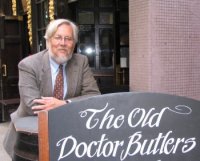
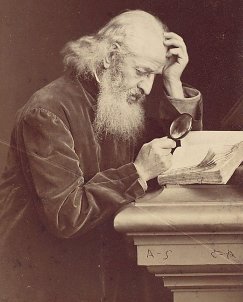 Since my most recent post only three days ago, I have had to walk back some of what I reported previously, owing to a detail that I somehow overlooked.
Since my most recent post only three days ago, I have had to walk back some of what I reported previously, owing to a detail that I somehow overlooked.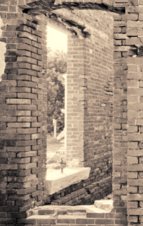 Well, it's been a while since I posted any news, but I'm excited to announce that I think I have made a "Brick Wall Break-through" in my MILES family research that I want to share with you.
Well, it's been a while since I posted any news, but I'm excited to announce that I think I have made a "Brick Wall Break-through" in my MILES family research that I want to share with you.


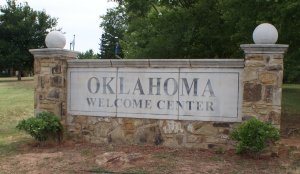 I'm excited to announce that I am planning a quick 2-day family history tour of Oklahoma, much like my quick 2-day family history tour of East Texas last year around this time.
I'm excited to announce that I am planning a quick 2-day family history tour of Oklahoma, much like my quick 2-day family history tour of East Texas last year around this time.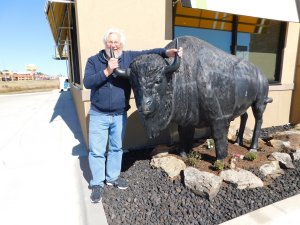 Since then, I've made a number of trips to and through Oklahoma, most notably in 1995, when, on the way to my mother's funeral, my dad and I stopped in Muscogee to visit the grave of my mother's mother, who had died there at the age of 30 in 1934, That was the first of five times (so far) that I've revisited that site to pay my respects. I returned in 1998 with my cousin Kathleen and uncle, Lindell Jenkins, in 2004 with my oldest son, in 2010 with my dad again and also my younger brother and his wife, and in 2019, with my youngest son.
Since then, I've made a number of trips to and through Oklahoma, most notably in 1995, when, on the way to my mother's funeral, my dad and I stopped in Muscogee to visit the grave of my mother's mother, who had died there at the age of 30 in 1934, That was the first of five times (so far) that I've revisited that site to pay my respects. I returned in 1998 with my cousin Kathleen and uncle, Lindell Jenkins, in 2004 with my oldest son, in 2010 with my dad again and also my younger brother and his wife, and in 2019, with my youngest son.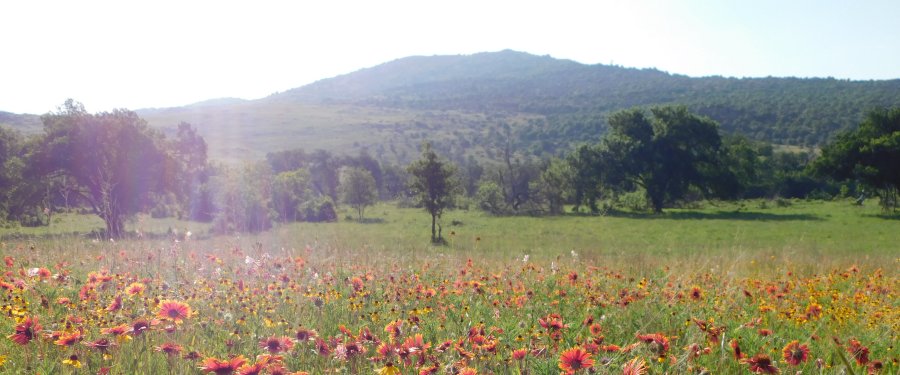
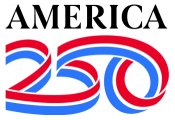 Finally, (and this has nothing directly to do with the preceding paragraphs) today, Saturday, April 19, 2025, is the 250th anniversary of the start of the American Revolution. In keeping with the importance of the date, recreation of the battles of Lexington and Concord, Massachusetts took place this morning on those sacred sites, attended and watched by thousands of people, including the Governor of Massachusetts. Interestingly, I think, the current President of the United States, was conspicuously absent, which was probably just as well because I don't think he's very popular in Massachusetts right now, having recently threatened to cut off federal funding to Harvard University if they didn't make some policy and academic changes that he demanded. Harvard refused, by the way.
Finally, (and this has nothing directly to do with the preceding paragraphs) today, Saturday, April 19, 2025, is the 250th anniversary of the start of the American Revolution. In keeping with the importance of the date, recreation of the battles of Lexington and Concord, Massachusetts took place this morning on those sacred sites, attended and watched by thousands of people, including the Governor of Massachusetts. Interestingly, I think, the current President of the United States, was conspicuously absent, which was probably just as well because I don't think he's very popular in Massachusetts right now, having recently threatened to cut off federal funding to Harvard University if they didn't make some policy and academic changes that he demanded. Harvard refused, by the way.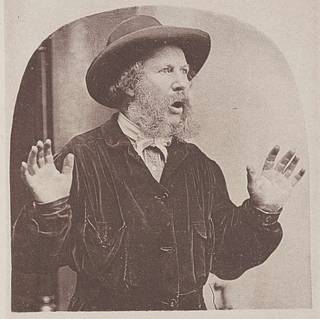 A little more than six years I made the startling discovery, thanks to a 23 and Me DNA test, that the man who fathered my own father was not my grandmother's husband, Herman H. Butler, but rather her next door neighbor, Charlie Miles. After the shock of this discovery had worn off a little, I set out to find out as much as I could about my "new" grandfather. One of the things I learned startled me almost as much as the initial discovery. By an incredible coincidence, after moving to Texas from his native Tennessee just after the turn of the twentieth century, "Grandpa Charlie," as I now call him, settled in the very same suburb of Dallas, Texas where I and my immediate family haved lived for over 40 years now, and that all his legitimate children--the two aunts and one uncle I never met--were born there! Furthermore, I also learned, Charlie, a road-building foreman by occupation, had worked out of a Dallas County depot which was located about a half-block from the apartment complex that my family and I had lived in for two years during the late 1970s. Talk about a small world!
A little more than six years I made the startling discovery, thanks to a 23 and Me DNA test, that the man who fathered my own father was not my grandmother's husband, Herman H. Butler, but rather her next door neighbor, Charlie Miles. After the shock of this discovery had worn off a little, I set out to find out as much as I could about my "new" grandfather. One of the things I learned startled me almost as much as the initial discovery. By an incredible coincidence, after moving to Texas from his native Tennessee just after the turn of the twentieth century, "Grandpa Charlie," as I now call him, settled in the very same suburb of Dallas, Texas where I and my immediate family haved lived for over 40 years now, and that all his legitimate children--the two aunts and one uncle I never met--were born there! Furthermore, I also learned, Charlie, a road-building foreman by occupation, had worked out of a Dallas County depot which was located about a half-block from the apartment complex that my family and I had lived in for two years during the late 1970s. Talk about a small world!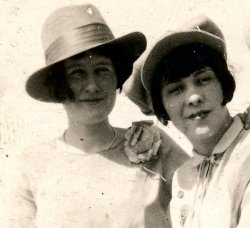 I have since discovered, thanks to old photos that both my Miles family cousin, Beverly Lumpkin, and my Butler family cousin, Aletha Hicks, had in their possession, passed down to them from their respective mothers (and in Aletha's case, her grandmother as well), that my Aunt Margaret Butler and my aunt Willie Mae Miles (seen together in the photo, right) became good friends in the 1920s, during the time that the Butler and Miles families lived next-door to one another on Rowan Avenue in East Dallas, to where the Miles family had moved about 1918 and the Butlers in 1920. Although this revelation was far less startling that those other discoveries--after all, the two girls lived next-door to one another, were nearly the same age, and went to the same schools--it was nonetheless interesting, because I couldn't help but wonder: Did either Margaret or Willie Mae ever know that in addition to the same neighborhood, schools, and friends, etc., that they also had the same little brother (i.e., my father) in common?
I have since discovered, thanks to old photos that both my Miles family cousin, Beverly Lumpkin, and my Butler family cousin, Aletha Hicks, had in their possession, passed down to them from their respective mothers (and in Aletha's case, her grandmother as well), that my Aunt Margaret Butler and my aunt Willie Mae Miles (seen together in the photo, right) became good friends in the 1920s, during the time that the Butler and Miles families lived next-door to one another on Rowan Avenue in East Dallas, to where the Miles family had moved about 1918 and the Butlers in 1920. Although this revelation was far less startling that those other discoveries--after all, the two girls lived next-door to one another, were nearly the same age, and went to the same schools--it was nonetheless interesting, because I couldn't help but wonder: Did either Margaret or Willie Mae ever know that in addition to the same neighborhood, schools, and friends, etc., that they also had the same little brother (i.e., my father) in common?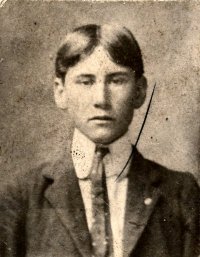 In the 1900 federal census for Franklin County, Tennessee, my then-15-years-old "Grandpa Charlie" is listed as the "adopted son" of a couple named Benjamin and Laura Rhoton. How Charlie came to be adopted by the Rhotons is a mystery to me, but I suspect it had something to do with the fact that after Charlie's father, John W. Miles, abandoned him and his mother when Charlie was only four months old, his mother, Maggie, after getting a divorce from John W., remarried. Her second husband was a man named Seaborn Jones, with whom she ended up having several more children. The fact that Charlie was living with the Rhotons instead of his own mother and stepfather and all of Charlie's half-brothers and half-sisters in 1900, suggests that maybe Charlie didn't like his stepfather, or that his stepfather didn't want to take responsibility for another mans's kid. I don't really know, because there is no known evidence of the reason. All I can be sure of is what is shown in the census.
In the 1900 federal census for Franklin County, Tennessee, my then-15-years-old "Grandpa Charlie" is listed as the "adopted son" of a couple named Benjamin and Laura Rhoton. How Charlie came to be adopted by the Rhotons is a mystery to me, but I suspect it had something to do with the fact that after Charlie's father, John W. Miles, abandoned him and his mother when Charlie was only four months old, his mother, Maggie, after getting a divorce from John W., remarried. Her second husband was a man named Seaborn Jones, with whom she ended up having several more children. The fact that Charlie was living with the Rhotons instead of his own mother and stepfather and all of Charlie's half-brothers and half-sisters in 1900, suggests that maybe Charlie didn't like his stepfather, or that his stepfather didn't want to take responsibility for another mans's kid. I don't really know, because there is no known evidence of the reason. All I can be sure of is what is shown in the census.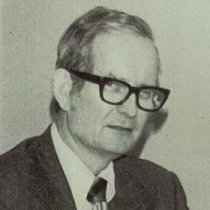 During the twenty-five years that Percy Jr. (pictured, left, at his desk at Newman Smith High school) and his family lived in Farmers Branch, they were members of Covenant Presbyterian Church in Carrollton (see below, in a photo I took in 2001), the very same church in which I was raised! The same church that my father and stepmother were still attending when Percy and his family started to go to services there, and the same church that my dad belonged to until the early 2000s, when the congregation disbanded and sold the building. By that time, however, Percy Jr. was dead, having passed away in his home in Farmers Branch in 1997.
During the twenty-five years that Percy Jr. (pictured, left, at his desk at Newman Smith High school) and his family lived in Farmers Branch, they were members of Covenant Presbyterian Church in Carrollton (see below, in a photo I took in 2001), the very same church in which I was raised! The same church that my father and stepmother were still attending when Percy and his family started to go to services there, and the same church that my dad belonged to until the early 2000s, when the congregation disbanded and sold the building. By that time, however, Percy Jr. was dead, having passed away in his home in Farmers Branch in 1997.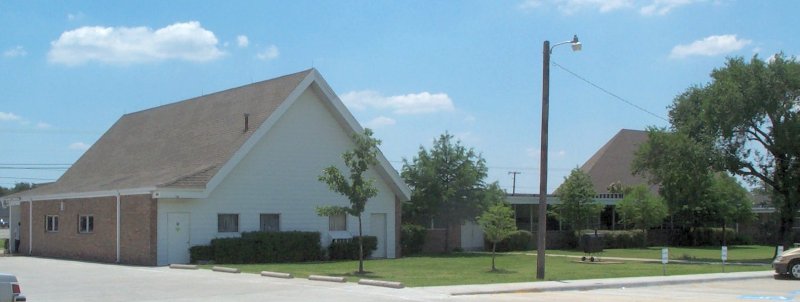
 With all that I have learned over the past two months about our roots in early-day New Netherland-New York, I can hardly wait to revisit the "Big Apple," to see for myself some of the places associated with our ancestors.
With all that I have learned over the past two months about our roots in early-day New Netherland-New York, I can hardly wait to revisit the "Big Apple," to see for myself some of the places associated with our ancestors.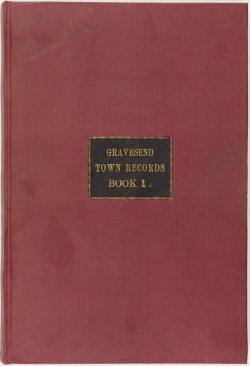 Yesterday, as I was looking through the Colonial Town Records of Gravesend, which is now a part of Brooklyn, New York, I found several references to one of our ancestors, Nicholas Stilwell, who was an early-day resident of the town. Most of those references were rather mundane, such as buying and selling property or being elected to serve as a magistrate or town constable. One that stood out from all the other references, however, was the report of a a lawsuit that Nicholas, on behalf of his wife, took out against another one of our ancestors: Ann Goulding, the wife of William Goulding.
Yesterday, as I was looking through the Colonial Town Records of Gravesend, which is now a part of Brooklyn, New York, I found several references to one of our ancestors, Nicholas Stilwell, who was an early-day resident of the town. Most of those references were rather mundane, such as buying and selling property or being elected to serve as a magistrate or town constable. One that stood out from all the other references, however, was the report of a a lawsuit that Nicholas, on behalf of his wife, took out against another one of our ancestors: Ann Goulding, the wife of William Goulding.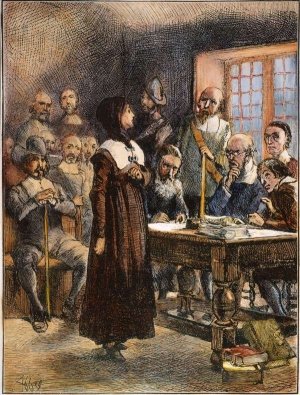 Apparently, Ann Goulding did not learn her lesson. On September 13, 1652, Nicholas Stilwell filed a suit against Ann, accusing her of doing the same thing to his wife, i.e. calling her a "a base whore." When Ann followed Nicholas' wife to her house, saying this in public so that everyone in the town could hear, Mrs. Stilwell told Ann that if she dared to come into her house, she would "through scaulding water uppon her!" The report does not say whether or not Mrs. Stilwell was forced to carry out the threat, but presumably she wasn't.
Apparently, Ann Goulding did not learn her lesson. On September 13, 1652, Nicholas Stilwell filed a suit against Ann, accusing her of doing the same thing to his wife, i.e. calling her a "a base whore." When Ann followed Nicholas' wife to her house, saying this in public so that everyone in the town could hear, Mrs. Stilwell told Ann that if she dared to come into her house, she would "through scaulding water uppon her!" The report does not say whether or not Mrs. Stilwell was forced to carry out the threat, but presumably she wasn't.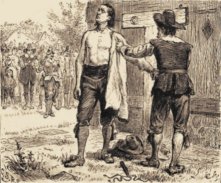 Earlier this month, after I discovered that I am descended from an English-born Baptist preacher named Obadiah Holmes, who lived in colonial Massachusetts and Rhode Island and got whipped by Puritans who didn't like his Baptist beliefs, I started doing some research in an effort to learn more about his life. In the process, I discovered that a short movie about him, called "As With Roses," had been made in 2010, by a company called Shiloh Films. Curious, I ordered a copy (for $20 plus tax and shipping) and last week, it came in the mail. It was actually a 2-DVD set, with one disc devoted entirely to the film, and the other to some extras such as a "Making of" documentary and a brief biography of Obadiah Holmes. Having watched it all now, I am ready to review it for you.
Earlier this month, after I discovered that I am descended from an English-born Baptist preacher named Obadiah Holmes, who lived in colonial Massachusetts and Rhode Island and got whipped by Puritans who didn't like his Baptist beliefs, I started doing some research in an effort to learn more about his life. In the process, I discovered that a short movie about him, called "As With Roses," had been made in 2010, by a company called Shiloh Films. Curious, I ordered a copy (for $20 plus tax and shipping) and last week, it came in the mail. It was actually a 2-DVD set, with one disc devoted entirely to the film, and the other to some extras such as a "Making of" documentary and a brief biography of Obadiah Holmes. Having watched it all now, I am ready to review it for you.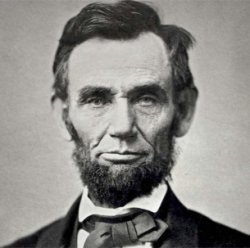
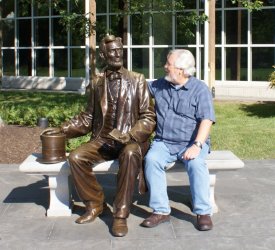 In some previous posts, I bragged (or in a couple of cases, complained) that I am a distant cousin to some U.S. Presidents, most notably Thomas Jefferson, Harry Truman, Barack Obama, and both Bushes. On this Presidents Day holiday, I thought I would share with you the news that I recently discovered that another President and I are distant cousins. If you can't guess who it is, just look at the photos on the right and the left and you will almost certainly figure it out!
In some previous posts, I bragged (or in a couple of cases, complained) that I am a distant cousin to some U.S. Presidents, most notably Thomas Jefferson, Harry Truman, Barack Obama, and both Bushes. On this Presidents Day holiday, I thought I would share with you the news that I recently discovered that another President and I are distant cousins. If you can't guess who it is, just look at the photos on the right and the left and you will almost certainly figure it out!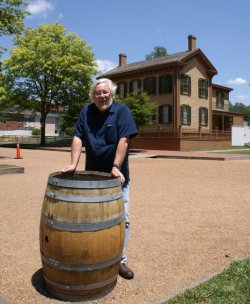
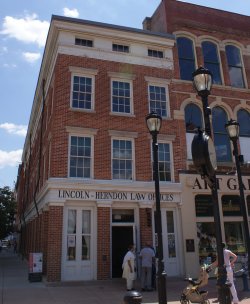
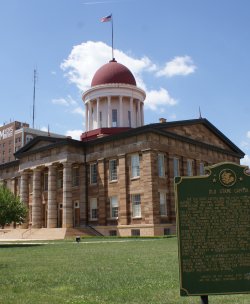
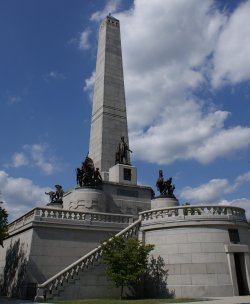
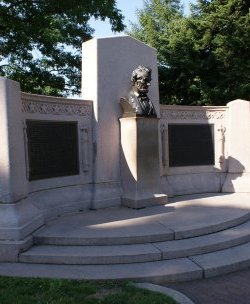
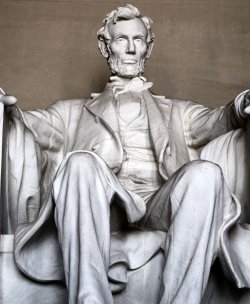
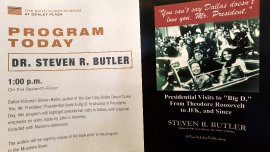 This past Friday, February 14th, to help mark the occasion of Presidents Day 2025, I presented a lecture at the Sixth Floor Museum in Dealey Plaza, about the topic of one of my most recent books (published in 2023), titled
This past Friday, February 14th, to help mark the occasion of Presidents Day 2025, I presented a lecture at the Sixth Floor Museum in Dealey Plaza, about the topic of one of my most recent books (published in 2023), titled 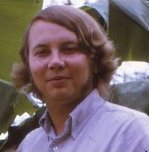 Photo, left: Yours truly, in 1972.
Photo, left: Yours truly, in 1972.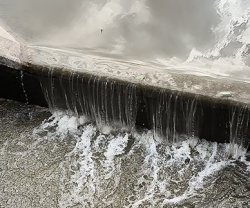 I had no idea, when I decided just after New Year's Day to finally get around to researching my Van Zandt ancestors (on my mother's side of the family), that I would be opening a genealogical floodgate. It is a fact though that the information I've uncovered in the past 5 weeks or so--not only about the Van Zandts, but also all the many other branches to which they are connected--has become almost overwhelming. But I am not complaining! Information about some of my lines is so sparse that it's genuinely frustrating. If given the choice, I would rather be overwhelmed.
I had no idea, when I decided just after New Year's Day to finally get around to researching my Van Zandt ancestors (on my mother's side of the family), that I would be opening a genealogical floodgate. It is a fact though that the information I've uncovered in the past 5 weeks or so--not only about the Van Zandts, but also all the many other branches to which they are connected--has become almost overwhelming. But I am not complaining! Information about some of my lines is so sparse that it's genuinely frustrating. If given the choice, I would rather be overwhelmed.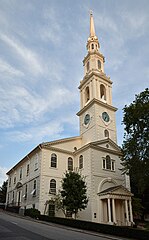 Obadiah spent the rest of his life in Rhode Island, living on a farm near Newport, where he became the second full-time minister of the First Baptist Church of Newport (see photo, left, courtesy Wikimedia Commons). He died in 1682 and was buried in a small family cemetery a few miles east of Newport. The cemetery is still there today.
Obadiah spent the rest of his life in Rhode Island, living on a farm near Newport, where he became the second full-time minister of the First Baptist Church of Newport (see photo, left, courtesy Wikimedia Commons). He died in 1682 and was buried in a small family cemetery a few miles east of Newport. The cemetery is still there today.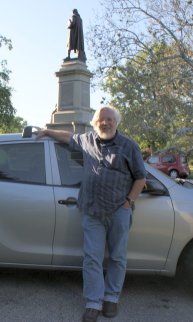 Left: Your host in Roger Williams Park, Providence, Rhode Island, June 2012.
Left: Your host in Roger Williams Park, Providence, Rhode Island, June 2012.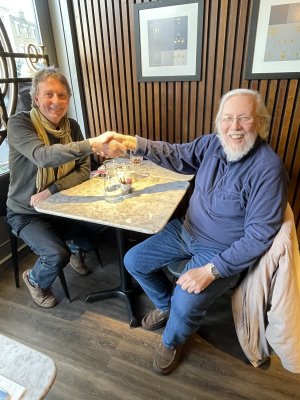 Left: "Hands Across the Water," Alan Winter and I, London, England, January 2023
Left: "Hands Across the Water," Alan Winter and I, London, England, January 2023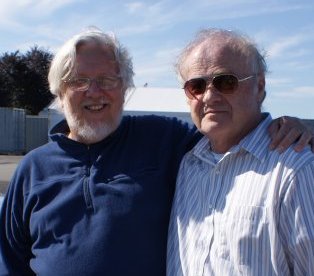 While I'm recalling old friends who've died too soon, in my opinion, I also remember the passing, almost a year ago (on January 23, 2024) of another good friend, Joseph Sullivan of Warwick, Rhode Island (originally), who, like Alan, was taken from us too soon, at the age of 73. Joseph and I also shared a love of history and held similar political views. We met at Rhode Island College in 1974, when we took a class in British History. Unlike Alan, Joseph and I lost touch after about 1980 or so, but we reconnected in 2012, during a visit that my wife and I made to the East Coast that year, and stayed in touch by email, etc. afterward. I wish now that Joseph and I had got together again after 2012, but we didn't, so let that be a lesson to anyone who is reading this: Embrace your friends, take time to talk to them, not just on the phone or by email, but in person. Don't wait until it's too late and then regret that you didn't.
While I'm recalling old friends who've died too soon, in my opinion, I also remember the passing, almost a year ago (on January 23, 2024) of another good friend, Joseph Sullivan of Warwick, Rhode Island (originally), who, like Alan, was taken from us too soon, at the age of 73. Joseph and I also shared a love of history and held similar political views. We met at Rhode Island College in 1974, when we took a class in British History. Unlike Alan, Joseph and I lost touch after about 1980 or so, but we reconnected in 2012, during a visit that my wife and I made to the East Coast that year, and stayed in touch by email, etc. afterward. I wish now that Joseph and I had got together again after 2012, but we didn't, so let that be a lesson to anyone who is reading this: Embrace your friends, take time to talk to them, not just on the phone or by email, but in person. Don't wait until it's too late and then regret that you didn't.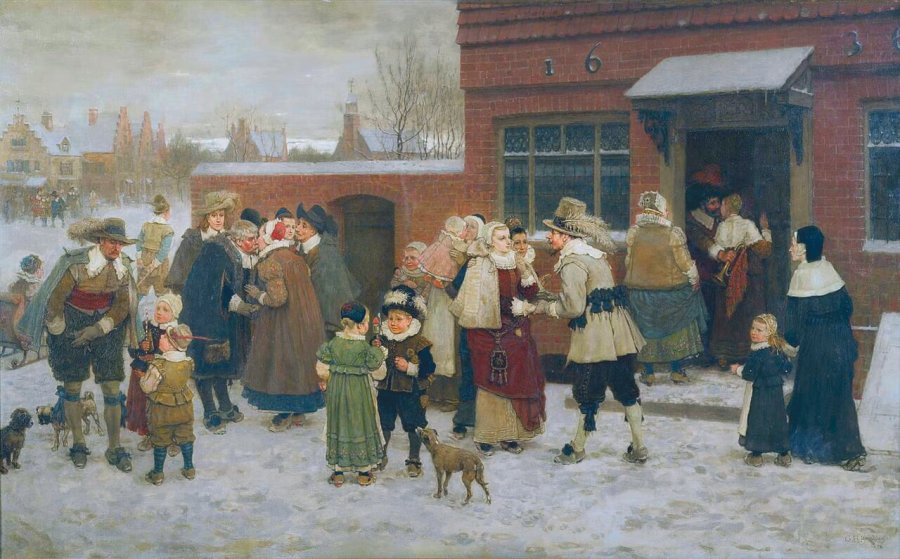 Left: "New Year's Day 1636 in New Amsterdam."
Left: "New Year's Day 1636 in New Amsterdam."
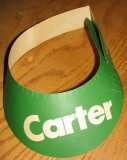 Well, I've been so busy writing, researching, traveling, and making discoveries, that I hardly know where to begin. However, before I start, I want to say a few words about former President Jimmy Carter, who died this past Sunday at the age of 100.
Well, I've been so busy writing, researching, traveling, and making discoveries, that I hardly know where to begin. However, before I start, I want to say a few words about former President Jimmy Carter, who died this past Sunday at the age of 100.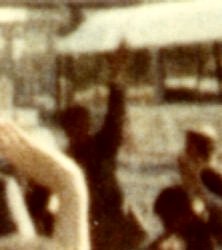 During the campaign, I acquired some bumper stickers and a Carter visor (see photo above). One of the stickers went on the bumper of my VW bug and I still have the other as a souvenir. I also have a Carter poster that I acquired much later, and a book that he and his wife, Roselyn wrote together. My copy is autographed by them both. I should also mention that when I made a road trip through the South with my oldest son in 2004, we took the time to visit the Carter Center in Atlanta, Georgia, where, among other things, we saw the Nobel Peace Prize medal that President Carter was awarded. There is no question in my mind that he deserved it.
During the campaign, I acquired some bumper stickers and a Carter visor (see photo above). One of the stickers went on the bumper of my VW bug and I still have the other as a souvenir. I also have a Carter poster that I acquired much later, and a book that he and his wife, Roselyn wrote together. My copy is autographed by them both. I should also mention that when I made a road trip through the South with my oldest son in 2004, we took the time to visit the Carter Center in Atlanta, Georgia, where, among other things, we saw the Nobel Peace Prize medal that President Carter was awarded. There is no question in my mind that he deserved it.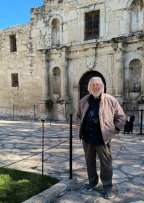 Now, about my travels! And my writing.
Now, about my travels! And my writing.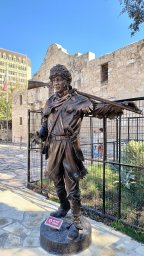 Just before Christmas, I took three days to drive down to Austin and San Antonio, mainly to see the Alamo and all the new things that are there on the Alamo property and Alamo Plaza that weren't there when my wife and I visited during Spring Break in 2018. During my visit, I also went up to the top of the Tower of the Americas, something I had never done before. Almost needless to say, I took tons of photos, especially of the Alamo and its environs, and enjoyed myself thoroughly. I also took time to see the IMAX movie "Alamo: The Price of Freedom," which I'm not sure if I ever saw before. If I did, it was probably back in the 1990s, when it was new. In common with the 2004 movie, "The Alamo," starring Dennis Quaid (as Sam Houston) and Billy Bob Thornton (as Davy Crockett), it is one of most historically accurate films about the famous battle. I really wish they (whoever "they" are) would release it on DVD. Currently, the only place you can see it is at the IMAX theater in the River Center mall, next to the Alamo and just behind and to the south of the Menger Hotel.
Just before Christmas, I took three days to drive down to Austin and San Antonio, mainly to see the Alamo and all the new things that are there on the Alamo property and Alamo Plaza that weren't there when my wife and I visited during Spring Break in 2018. During my visit, I also went up to the top of the Tower of the Americas, something I had never done before. Almost needless to say, I took tons of photos, especially of the Alamo and its environs, and enjoyed myself thoroughly. I also took time to see the IMAX movie "Alamo: The Price of Freedom," which I'm not sure if I ever saw before. If I did, it was probably back in the 1990s, when it was new. In common with the 2004 movie, "The Alamo," starring Dennis Quaid (as Sam Houston) and Billy Bob Thornton (as Davy Crockett), it is one of most historically accurate films about the famous battle. I really wish they (whoever "they" are) would release it on DVD. Currently, the only place you can see it is at the IMAX theater in the River Center mall, next to the Alamo and just behind and to the south of the Menger Hotel.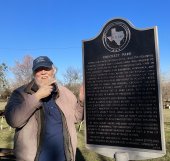 But wait! There's more!
But wait! There's more!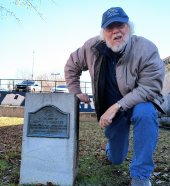
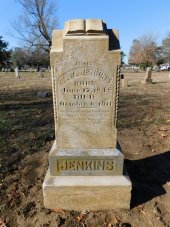 Next stop was the Paris, Texas public library, in the back lawn of which is a tiny chunk of concrete on which there is a tiny bronze plaque commemorating Davy Crockett, who is also believed to have camped near the site of Paris on his way to and/or from Honey Grove. Afterwards, I stopped to take some photos of the old Texas & Pacific R.R. depot, now an event center, from which my great-great-grandfather T. W. Jenkins once traveled to Dallas, where he got robbed in what is now called the "Deep Ellum" section of town. This was in 1911, the same year in which he died at the age of sixty-three. I guess you could say that 1911 wasn't such a good year for him!
Next stop was the Paris, Texas public library, in the back lawn of which is a tiny chunk of concrete on which there is a tiny bronze plaque commemorating Davy Crockett, who is also believed to have camped near the site of Paris on his way to and/or from Honey Grove. Afterwards, I stopped to take some photos of the old Texas & Pacific R.R. depot, now an event center, from which my great-great-grandfather T. W. Jenkins once traveled to Dallas, where he got robbed in what is now called the "Deep Ellum" section of town. This was in 1911, the same year in which he died at the age of sixty-three. I guess you could say that 1911 wasn't such a good year for him!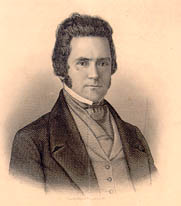 Jacob Van Zandt, Sr. had a grandson named Isaac Van Zandt (son of Jacob Van Zandt Jr.), who moved to the Republic of Texas in 1837 and became the Republic's ambassador to the United States. (That's a picture of him, left.) Among other things, he helped negotiate the annexation of Texas to the United States, the 179th anniversary of which just passed three days ago, on December 29, 2024. Isaac Van Zandt was my 3rd Cousin 6x Removed. Until today, I had no idea that I had any sort of familial connection to the Republic of Texas. Just shows you never know what you'll find when doing family history research!
Jacob Van Zandt, Sr. had a grandson named Isaac Van Zandt (son of Jacob Van Zandt Jr.), who moved to the Republic of Texas in 1837 and became the Republic's ambassador to the United States. (That's a picture of him, left.) Among other things, he helped negotiate the annexation of Texas to the United States, the 179th anniversary of which just passed three days ago, on December 29, 2024. Isaac Van Zandt was my 3rd Cousin 6x Removed. Until today, I had no idea that I had any sort of familial connection to the Republic of Texas. Just shows you never know what you'll find when doing family history research!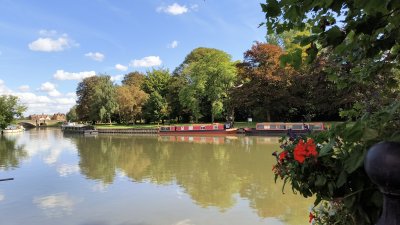 Less than a week ago, I returned home from a visit to England (my tenth this century), where I had hoped to arrive in time to see a dying longtime friend before he passed away. Unfortunately, he died three days before my scheduled arrival, but I was able, by extending my visit, to attend his funeral, where I was one of three people who delivered brief eulogies. I was also able to visit and spend time with other friends and family who are resident in the U.K. and to travel around the country, primarily the southeastern portion, where in LONDON and a picturesque little village called ABINGDON (see photo, left), I saw for myself some places with connections to the BRANCH family, to whom I am related on both my mother's and my fathers's side of the family.
Less than a week ago, I returned home from a visit to England (my tenth this century), where I had hoped to arrive in time to see a dying longtime friend before he passed away. Unfortunately, he died three days before my scheduled arrival, but I was able, by extending my visit, to attend his funeral, where I was one of three people who delivered brief eulogies. I was also able to visit and spend time with other friends and family who are resident in the U.K. and to travel around the country, primarily the southeastern portion, where in LONDON and a picturesque little village called ABINGDON (see photo, left), I saw for myself some places with connections to the BRANCH family, to whom I am related on both my mother's and my fathers's side of the family. 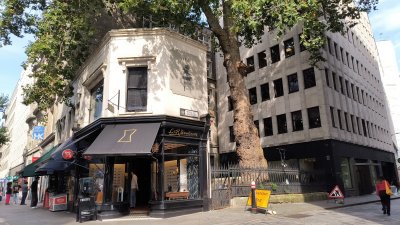 In LONDON, together with my oldest son, I visited the site of the church,
In LONDON, together with my oldest son, I visited the site of the church, 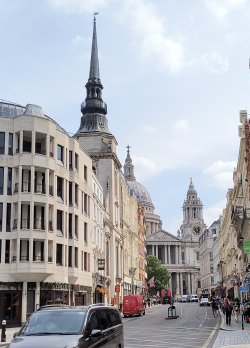
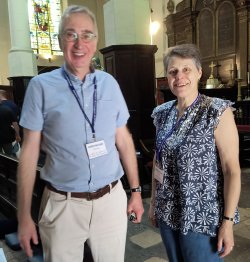 Next, my son and I visited St. Martin-within-Ludgate, located at 40 Ludgate Hill, just a block or so from the much more magnificent St. Paul's Cathedral. This church is where Christopher Branch's parents--Lionel Branch and Valentia Sparke--were married in 1597. The church that's there now is not the original structure, which was destroyed in the Great Fire. Unlike St. Peter Westcheap, however, St. Martin-within-Ludgate was rebuilt by the famous architect, Sir Christopher Wren. And unlike the grander St. Paul's, there is no charge to enter and examine St. Martin-within-Ludgate, where we were met by two enthusiastic volunteer docents--Clive and Mary--who were only too happy to tell us all about the history of the building. They also allowed us to photograph a picture of what the church looked like when Lionel and Valentia were married there (see below).
Next, my son and I visited St. Martin-within-Ludgate, located at 40 Ludgate Hill, just a block or so from the much more magnificent St. Paul's Cathedral. This church is where Christopher Branch's parents--Lionel Branch and Valentia Sparke--were married in 1597. The church that's there now is not the original structure, which was destroyed in the Great Fire. Unlike St. Peter Westcheap, however, St. Martin-within-Ludgate was rebuilt by the famous architect, Sir Christopher Wren. And unlike the grander St. Paul's, there is no charge to enter and examine St. Martin-within-Ludgate, where we were met by two enthusiastic volunteer docents--Clive and Mary--who were only too happy to tell us all about the history of the building. They also allowed us to photograph a picture of what the church looked like when Lionel and Valentia were married there (see below).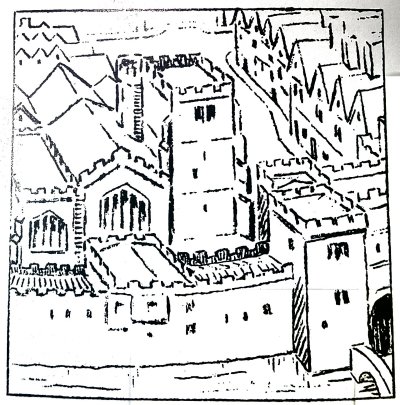
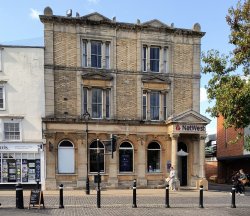 Two weeks later, on Friday, September 13, I traveled by train from London's Paddington Station to Oxford, where I caught a bus that took me to the little village of Abingdon, now a part of Oxfordshire, originally Berkshire, where, according to all accounts, the Branch (or Braunche, as it was sometimes spelled) family was resident, and prominent, for a little over two hundred years--during the 1400s, 1500s, and part of the 1600s. A webpage, created and maintained by the Abingdon Town Council tells the story of the
Two weeks later, on Friday, September 13, I traveled by train from London's Paddington Station to Oxford, where I caught a bus that took me to the little village of Abingdon, now a part of Oxfordshire, originally Berkshire, where, according to all accounts, the Branch (or Braunche, as it was sometimes spelled) family was resident, and prominent, for a little over two hundred years--during the 1400s, 1500s, and part of the 1600s. A webpage, created and maintained by the Abingdon Town Council tells the story of the 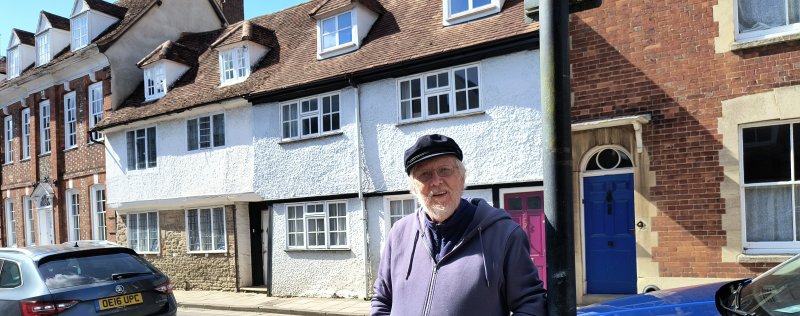
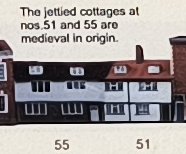 A placard near the north end of East St. Helen Street tells a little about the old houses that line each side. Although it doesn't mention Richard or Elizabeth Braunche by name, it does identify Nos. 51 and 55 as "jettied cottages" which are medieval in origin.
A placard near the north end of East St. Helen Street tells a little about the old houses that line each side. Although it doesn't mention Richard or Elizabeth Braunche by name, it does identify Nos. 51 and 55 as "jettied cottages" which are medieval in origin.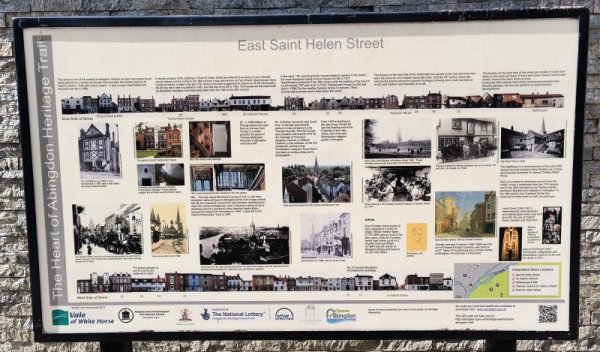
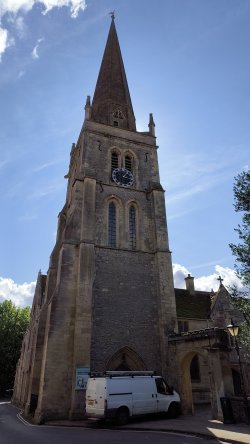
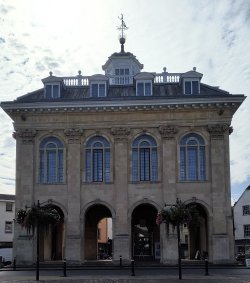 While in Abingdon, I also visited St. Helen's church (see photo, left), where I searched in vain for Braunche graves, and the local history museum, which is located on an upper floor of the old County Hall, erected in 1677 (see photo, right). Unfortunately, the Branch or Braunche family is not mentioned by name in any of the exhibits. In light of the fact that William Braunche was a governor of Christ's Hospital and four times Lord Mayor of Abingdon during the 1500s, I fully expected to find his grave or a monument or something tangible connected with him, but surprisingly did not. I have since discovered, to my dismay and regret, that during my visit, I had come within just a few yards of a very old institution--the Long Alley Almshouses--which as a governor of Christ's Hospital, William would have been familiar, but did not actually see with my own eyes or photograph, or if I did see, did not realize what I was looking at. Unfortunately, I wanted to get back to Oxford before the Natural History Museum there closed and I allowed myself to be rushed. The below photo is by a Wikipedia contributor, used under a Creative Commons License.
While in Abingdon, I also visited St. Helen's church (see photo, left), where I searched in vain for Braunche graves, and the local history museum, which is located on an upper floor of the old County Hall, erected in 1677 (see photo, right). Unfortunately, the Branch or Braunche family is not mentioned by name in any of the exhibits. In light of the fact that William Braunche was a governor of Christ's Hospital and four times Lord Mayor of Abingdon during the 1500s, I fully expected to find his grave or a monument or something tangible connected with him, but surprisingly did not. I have since discovered, to my dismay and regret, that during my visit, I had come within just a few yards of a very old institution--the Long Alley Almshouses--which as a governor of Christ's Hospital, William would have been familiar, but did not actually see with my own eyes or photograph, or if I did see, did not realize what I was looking at. Unfortunately, I wanted to get back to Oxford before the Natural History Museum there closed and I allowed myself to be rushed. The below photo is by a Wikipedia contributor, used under a Creative Commons License.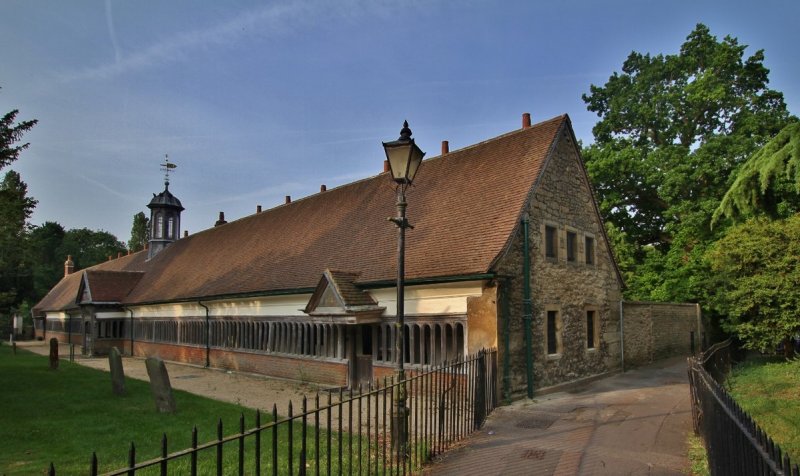

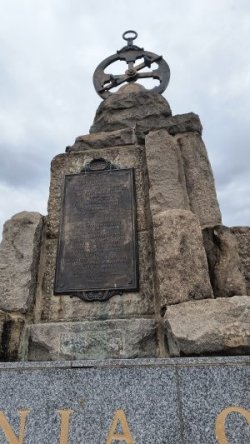
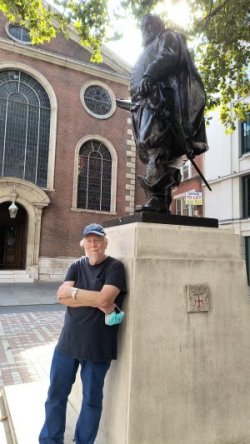
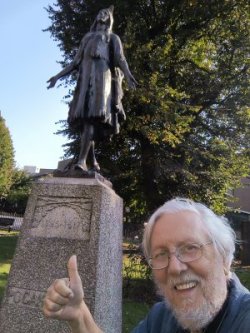
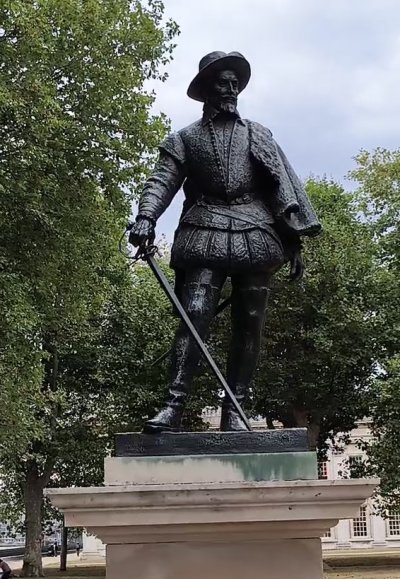
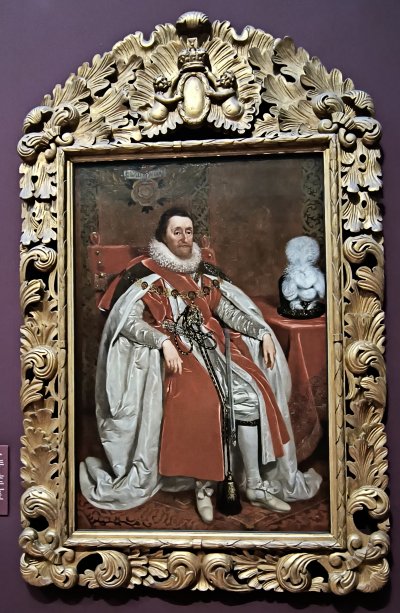
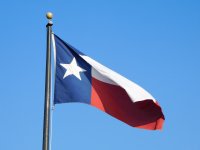 First of all, I went on my "Northeast Texas Family History Tour," as planned, over the weekend of May 18 and 19. All in all, it went pretty well and I have to say that it was productive. I learned a lot that I didn't know already, and just as importantly, I got to revisit some places I hadn't seen in a long time, and see some other places I was visiting for the first time. But there's so much to say about that trip, despite how short as it was, I am creating a whole webpage about it, so I won't go into details about it here.
First of all, I went on my "Northeast Texas Family History Tour," as planned, over the weekend of May 18 and 19. All in all, it went pretty well and I have to say that it was productive. I learned a lot that I didn't know already, and just as importantly, I got to revisit some places I hadn't seen in a long time, and see some other places I was visiting for the first time. But there's so much to say about that trip, despite how short as it was, I am creating a whole webpage about it, so I won't go into details about it here.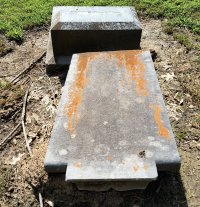 Secondly, ever since I got back from my "Northeast Texas Family History Tour," I've been trying to cajole the relatives on my mother's side of the family to pitch in and help pay for the repair of our Great-Great-Grandfather T. W. Jenkins' monument, which I found lying face down on the ground in Evergreen Cemetery in Paris, Texas. Apparently, sometime between the previous time I saw it, on May 16, 2017, and the most recent time I saw it, on May 18, 2024--a period of seven years--it had toppled over off its base!
Secondly, ever since I got back from my "Northeast Texas Family History Tour," I've been trying to cajole the relatives on my mother's side of the family to pitch in and help pay for the repair of our Great-Great-Grandfather T. W. Jenkins' monument, which I found lying face down on the ground in Evergreen Cemetery in Paris, Texas. Apparently, sometime between the previous time I saw it, on May 16, 2017, and the most recent time I saw it, on May 18, 2024--a period of seven years--it had toppled over off its base!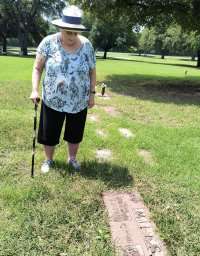 On Memorial Day, Monday, May 27, my first cousin Beverly Lumpkin and I took a "cemetery tour" in my car, to Laurel Land Memorial Park in Oak Cliff (the southern part of Dallas) and also Forest Lawn Cemetery, in northeast Dallas. At Laurel Land, we saw the graves of our grandfather, Charlie Miles and his wife (Beverly's grandmother), Lillian Dalton Miles, and we also saw the graves of our Uncle R. V. Miles and his wife, Marie, our cousin Vernon Ray Miles and his second wife, and Vernon Ray's first wife, who was killed in a tragic traffic accident in 1954, caused by a drunk driver named Joe Raymond Butler--an name that is eerily similar to the name of my father, Raymond Joe Butler, who was Vernon Ray's uncle (although they never met)
On Memorial Day, Monday, May 27, my first cousin Beverly Lumpkin and I took a "cemetery tour" in my car, to Laurel Land Memorial Park in Oak Cliff (the southern part of Dallas) and also Forest Lawn Cemetery, in northeast Dallas. At Laurel Land, we saw the graves of our grandfather, Charlie Miles and his wife (Beverly's grandmother), Lillian Dalton Miles, and we also saw the graves of our Uncle R. V. Miles and his wife, Marie, our cousin Vernon Ray Miles and his second wife, and Vernon Ray's first wife, who was killed in a tragic traffic accident in 1954, caused by a drunk driver named Joe Raymond Butler--an name that is eerily similar to the name of my father, Raymond Joe Butler, who was Vernon Ray's uncle (although they never met)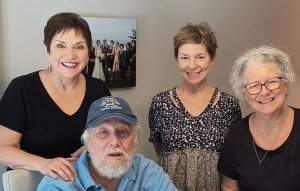 First, on Saturday, June 29, I met up with three cousins on my father's side of the family--Aletha Hicks, Debbie Young, and Donna St. Clair--all of whom are the grandchildren of my late Aunt Margaret Butler Vance Ficklin, to have a "picture party" at Aletha's house in northeast Dallas. We hadn't seen each other in nearly twenty years, but they were so welcoming and open that it was almost as if we had just seen each other yesterday, which was nice. I brought some photos on a USB drive that I had inherited from my grandmother (their great-grandmother), and Aletha brought out boxes of photos and some albums containing photos that she inherited from her Nannie-Margaret. I had seen some of the photos before (obviously someone had made and distributed duplicates), but there were some that were entirely new to me, which is what I hoped for. I also had hoped that Aletha would let me borrow those "new" photos and take them home to scan, which she did. Among the treasures I found were a photo of my father as a boy on a bike outside his childhood home in East Dallas, two photos in which my aunt, Willie Mae Miles, was in the picture with my Aunt Margaret, and one of Willie Mae and what appears to be her first husband (she was married three times).
First, on Saturday, June 29, I met up with three cousins on my father's side of the family--Aletha Hicks, Debbie Young, and Donna St. Clair--all of whom are the grandchildren of my late Aunt Margaret Butler Vance Ficklin, to have a "picture party" at Aletha's house in northeast Dallas. We hadn't seen each other in nearly twenty years, but they were so welcoming and open that it was almost as if we had just seen each other yesterday, which was nice. I brought some photos on a USB drive that I had inherited from my grandmother (their great-grandmother), and Aletha brought out boxes of photos and some albums containing photos that she inherited from her Nannie-Margaret. I had seen some of the photos before (obviously someone had made and distributed duplicates), but there were some that were entirely new to me, which is what I hoped for. I also had hoped that Aletha would let me borrow those "new" photos and take them home to scan, which she did. Among the treasures I found were a photo of my father as a boy on a bike outside his childhood home in East Dallas, two photos in which my aunt, Willie Mae Miles, was in the picture with my Aunt Margaret, and one of Willie Mae and what appears to be her first husband (she was married three times).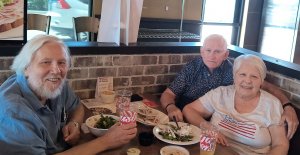 On Monday, July 1, I met up with a cousin on my mother's side of the family, Gerald "Inky" Jenkins, and his wife, Cindy, at a Jason's Deli near my home. There, Inky gave me his $100 contribution toward the repair of our GGF T. W. Jenkins grave monument and I gave him some old photos that another relative had given me, photos that mostly featured members of Inky's family, including his father in his Coast Guard uniform. Over lunch, we swapped stories about our military service. Inky was in the U.S. Army, in Vietnam and also Germany, and I was in the Navy, around the same time--the late 1960s and early 1970s. I hadn't seen Inky for about seven years. It was good to catch up.
On Monday, July 1, I met up with a cousin on my mother's side of the family, Gerald "Inky" Jenkins, and his wife, Cindy, at a Jason's Deli near my home. There, Inky gave me his $100 contribution toward the repair of our GGF T. W. Jenkins grave monument and I gave him some old photos that another relative had given me, photos that mostly featured members of Inky's family, including his father in his Coast Guard uniform. Over lunch, we swapped stories about our military service. Inky was in the U.S. Army, in Vietnam and also Germany, and I was in the Navy, around the same time--the late 1960s and early 1970s. I hadn't seen Inky for about seven years. It was good to catch up.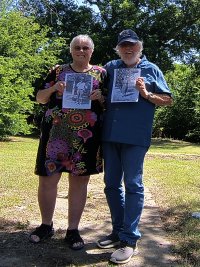 Finally, on Wednesday, July 3, my cousin Beverly Lumpkin and I took another tour, in my car, to East Dallas, where we visited the site of the house where my grandmother, Alice Tate Butler, once lived (now a vacant lot) and the site of the house in which our grandfather, Charlie Miles, lived next door (now a new house in place of the old one.) After showing Beverly the school that her mother and my father both attended (the old building since replaced by a new one), we went and had a look at three of the houses that our grandfather Charlie Miles and his family lived in during the 1930s and 1940s, which which are still standing! (Three others have since been torn down.) Following a quick detour through Dallas' "Deep Ellum" district, so that I could take a photo of a Texas & Pacific Railway ad painted on the side of an old hotel (because my father had worked for T&P for 15 years, and also because July 3, 1948 was the day he started there), we went and had another leisurely lunch, this time at TGI Friday's in Mesquite, the same restaurant in which Beverly and I met up in 2019 after discovering, through DNA tests, that we were cousins.
Finally, on Wednesday, July 3, my cousin Beverly Lumpkin and I took another tour, in my car, to East Dallas, where we visited the site of the house where my grandmother, Alice Tate Butler, once lived (now a vacant lot) and the site of the house in which our grandfather, Charlie Miles, lived next door (now a new house in place of the old one.) After showing Beverly the school that her mother and my father both attended (the old building since replaced by a new one), we went and had a look at three of the houses that our grandfather Charlie Miles and his family lived in during the 1930s and 1940s, which which are still standing! (Three others have since been torn down.) Following a quick detour through Dallas' "Deep Ellum" district, so that I could take a photo of a Texas & Pacific Railway ad painted on the side of an old hotel (because my father had worked for T&P for 15 years, and also because July 3, 1948 was the day he started there), we went and had another leisurely lunch, this time at TGI Friday's in Mesquite, the same restaurant in which Beverly and I met up in 2019 after discovering, through DNA tests, that we were cousins.
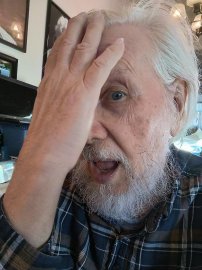 To add to my frustration, I also have DNA matches to people who have what I called "dead-end" Miles ancestors, who also seem to fit into the picture, but the picture is incomplete for them as well. One good example are the dozen or so matches I have to people descended from a man named Joseph Miles, through his daughter, Elizabeth Orlena Miles Partin. The trouble is that none of these other people have been able to trace their Miles lines back any further than Joseph! So, where did he come from? Well, thanks to census records, the answer to that question is South Carolina, where he was born about 1802. But who are his mother and father? And how is he related to my William B. Miles, who was born in North Carolina about 1810, according to the 1850 census?
To add to my frustration, I also have DNA matches to people who have what I called "dead-end" Miles ancestors, who also seem to fit into the picture, but the picture is incomplete for them as well. One good example are the dozen or so matches I have to people descended from a man named Joseph Miles, through his daughter, Elizabeth Orlena Miles Partin. The trouble is that none of these other people have been able to trace their Miles lines back any further than Joseph! So, where did he come from? Well, thanks to census records, the answer to that question is South Carolina, where he was born about 1802. But who are his mother and father? And how is he related to my William B. Miles, who was born in North Carolina about 1810, according to the 1850 census? For the past several months, I have been concentrating my efforts on finding the person or persons I call the "missing link" between my great-great-grandfather, William B. Miles of Franklin and Coffee counties, Tennessee--for whom I have a "paper trail" dating back to 1836--and the Miles ancestors that my DNA matches on Ancestry.com have revealed. But so far, no luck. The best analogy I can use is that it's like trying to put together a jigsaw puzzle with key pieces missing.
For the past several months, I have been concentrating my efforts on finding the person or persons I call the "missing link" between my great-great-grandfather, William B. Miles of Franklin and Coffee counties, Tennessee--for whom I have a "paper trail" dating back to 1836--and the Miles ancestors that my DNA matches on Ancestry.com have revealed. But so far, no luck. The best analogy I can use is that it's like trying to put together a jigsaw puzzle with key pieces missing.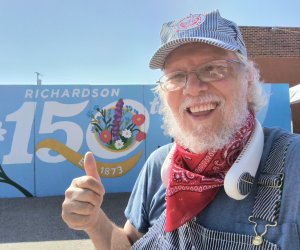 Recently, I helped celebrate the Sesquicentennial (150th anniversary) of Richardson, Texas, the town that my paternal grandfather, Charlie Miles, decided to make his home after he left his native Tennessee sometime shortly after the turn of the twentieth century. About 1918, or thereabouts, Charlie moved to Dallas, where I was born nearly half-a-century later, but throughout his life, maintained close ties to Richardson, where he had once worked in the local livery stable. Ironically (or is it just coincidentally?), my grandmother's husband, Herman Butler, the man I thought was my grandfather until I was nearly 70, also worked in a livery stable, in Dallas, around the same time. Charlie had another tie to Richardson: In 1948-1949, he supervised the road crew that repaved every road and street that then existed in Richardson and was recognized and thanked for his hard work both by local civic leaders and the editor of the local newspaper, The Richardson Echo. Less than a quarter of a century later, I worked in Richardson for a while, and then again for a brief period in the mid 1970s, and then finally, in 1983, moved to Richardson with my family, where we have been ever since. At the time, I did not know about Charlie being my biological grandfather. That discovery was made in 2019 after I took a 23 and Me DNA test. Since then, I have often wondered: What were the odds that of all the places I could have made my home, I would choose the very same city that my grandfather, a man I never met (nor even knew about for most of my life), chose all those years ago? I don't know, but in either event, that thought was one of many on my mind when on a sunny blue-sky day in late June, in my capacity as President of the Richardson Historical & Genealogical Society, I helped my fellow Richardsonites celebrate the 150th anniversary of the founding of our city.
Recently, I helped celebrate the Sesquicentennial (150th anniversary) of Richardson, Texas, the town that my paternal grandfather, Charlie Miles, decided to make his home after he left his native Tennessee sometime shortly after the turn of the twentieth century. About 1918, or thereabouts, Charlie moved to Dallas, where I was born nearly half-a-century later, but throughout his life, maintained close ties to Richardson, where he had once worked in the local livery stable. Ironically (or is it just coincidentally?), my grandmother's husband, Herman Butler, the man I thought was my grandfather until I was nearly 70, also worked in a livery stable, in Dallas, around the same time. Charlie had another tie to Richardson: In 1948-1949, he supervised the road crew that repaved every road and street that then existed in Richardson and was recognized and thanked for his hard work both by local civic leaders and the editor of the local newspaper, The Richardson Echo. Less than a quarter of a century later, I worked in Richardson for a while, and then again for a brief period in the mid 1970s, and then finally, in 1983, moved to Richardson with my family, where we have been ever since. At the time, I did not know about Charlie being my biological grandfather. That discovery was made in 2019 after I took a 23 and Me DNA test. Since then, I have often wondered: What were the odds that of all the places I could have made my home, I would choose the very same city that my grandfather, a man I never met (nor even knew about for most of my life), chose all those years ago? I don't know, but in either event, that thought was one of many on my mind when on a sunny blue-sky day in late June, in my capacity as President of the Richardson Historical & Genealogical Society, I helped my fellow Richardsonites celebrate the 150th anniversary of the founding of our city.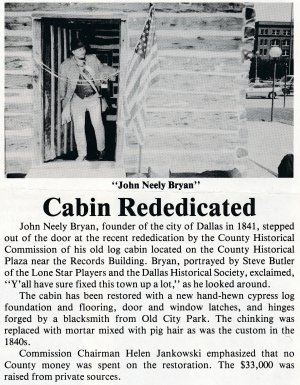 But, as it happens, this is not the first time I've done this sort of thing! Nor is it the first time I've done it in costume. (At the Richardson celebration, as you can see from the photo, I was dressed as a 19th Century locomotive engineer, to help folks recall that Richardson was founded in 1873 by the Houston & Texas Central Railroad.)
But, as it happens, this is not the first time I've done this sort of thing! Nor is it the first time I've done it in costume. (At the Richardson celebration, as you can see from the photo, I was dressed as a 19th Century locomotive engineer, to help folks recall that Richardson was founded in 1873 by the Houston & Texas Central Railroad.)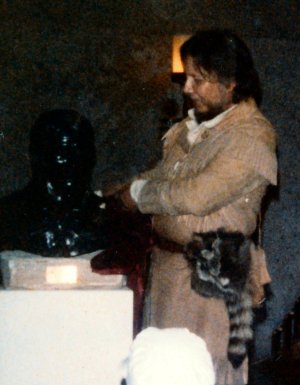 Similarly, in April 1986, I dressed up as the famous frontiersman, Davy Crockett (who I'm not related to in any way, but who has been my "hero" since childhood), to help celebrate the Texas Sesquicentennial at a ceremony held at the Hall of State in Dallas' Fair Park. That same summer, in August, I portayed Crockett again for the Dallas Historical Society's "Davy Crockett Bicentennial Birthday Bash," also held at the Hall of State, where I was given the honor of unveiling a bronze bust of the celebrated frontiersmen on the occasion of his 200th birthday.
Similarly, in April 1986, I dressed up as the famous frontiersman, Davy Crockett (who I'm not related to in any way, but who has been my "hero" since childhood), to help celebrate the Texas Sesquicentennial at a ceremony held at the Hall of State in Dallas' Fair Park. That same summer, in August, I portayed Crockett again for the Dallas Historical Society's "Davy Crockett Bicentennial Birthday Bash," also held at the Hall of State, where I was given the honor of unveiling a bronze bust of the celebrated frontiersmen on the occasion of his 200th birthday. It was in his play, "Romeo and Juliet," that Shakespeare wrote: "What's in a name? A rose by any other name would smell as sweet." But Shakespeare wasn't a family historian (so far as I know), and in genealogy or family history, a name, particularly a surname, is actually quite important, because the consistency of a family name extending from the present or recent past to the far distant past is what enables us to trace our ancestry with some degree of accuracy.
It was in his play, "Romeo and Juliet," that Shakespeare wrote: "What's in a name? A rose by any other name would smell as sweet." But Shakespeare wasn't a family historian (so far as I know), and in genealogy or family history, a name, particularly a surname, is actually quite important, because the consistency of a family name extending from the present or recent past to the far distant past is what enables us to trace our ancestry with some degree of accuracy.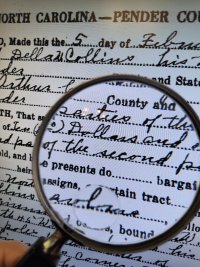 In an earlier entry
In an earlier entry 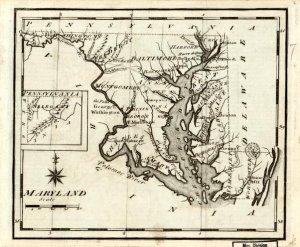 Since writing my February 17 entry, I have found additional proof that confirms that I have found the right Miles family. Just today, I found six persons who are a DNA match to me and every single one of them is descended from the Poteet family, a member of which intermarried with a member of the Miles family in Baltimore County, Maryland. I have also found several DNA matches to people who are descended from members of the Rice family that intermarried with the Miles family.
Since writing my February 17 entry, I have found additional proof that confirms that I have found the right Miles family. Just today, I found six persons who are a DNA match to me and every single one of them is descended from the Poteet family, a member of which intermarried with a member of the Miles family in Baltimore County, Maryland. I have also found several DNA matches to people who are descended from members of the Rice family that intermarried with the Miles family.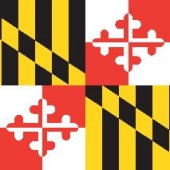 After months and months of careful, meticulous research, I have finally reached the conclusion that there is no doubt that my principal paternal line, the Miles family, originated in Baltimore County, Maryland before migrating to Caswell County, North Carolina, then to Logan County, Kentucky, then to Robertson County, Tennessee, then to Franklin and Coffee counties, Tennessee, and then finally, to Collin, Hunt, and Dallas counties, Texas. I base this belief on the fact that I have no fewer than 36 verifiable DNA matches to people who can likewise trace their ancestry to the Baltimore County line (and are therefore distant cousins). Here then, is what I have good reason to believe is my Miles Family line of descent in this country:
After months and months of careful, meticulous research, I have finally reached the conclusion that there is no doubt that my principal paternal line, the Miles family, originated in Baltimore County, Maryland before migrating to Caswell County, North Carolina, then to Logan County, Kentucky, then to Robertson County, Tennessee, then to Franklin and Coffee counties, Tennessee, and then finally, to Collin, Hunt, and Dallas counties, Texas. I base this belief on the fact that I have no fewer than 36 verifiable DNA matches to people who can likewise trace their ancestry to the Baltimore County line (and are therefore distant cousins). Here then, is what I have good reason to believe is my Miles Family line of descent in this country: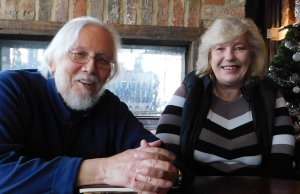 In December, during a month-long visit to the UK, I met up with one of my English DNA cousins, Tina Miles (seen here with me) at a pub next to the historic Chatham Dockyard. Interestingly, this is only the second time I've met up with one of my DNA matches who I had not previously known.
In December, during a month-long visit to the UK, I met up with one of my English DNA cousins, Tina Miles (seen here with me) at a pub next to the historic Chatham Dockyard. Interestingly, this is only the second time I've met up with one of my DNA matches who I had not previously known.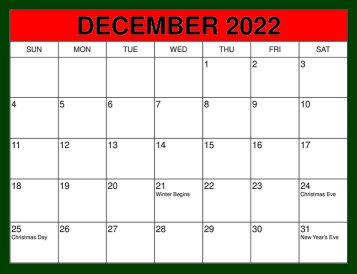 During the past several months, while recovering from a heart attack, open heart surgery, and also cataract surgery, I've had plenty of free time to devote to family history research. Throughout all that time, I have focused on two goals: 1.) Breaking through the proverbial "brick wall" that has my MILES family line stalled at the year 1810 (more or less), and 2.) Figuring out exactly how I am related, through which common ancestor(s), to my black (or more accurately, mixed-race) DNA-match cousins, who now number more than two dozen. As 2022 draws to a close, I'd like to be able to say that I have made great progress toward achieving both those goals, but unfortunately, and despite all my efforts, I can't.
During the past several months, while recovering from a heart attack, open heart surgery, and also cataract surgery, I've had plenty of free time to devote to family history research. Throughout all that time, I have focused on two goals: 1.) Breaking through the proverbial "brick wall" that has my MILES family line stalled at the year 1810 (more or less), and 2.) Figuring out exactly how I am related, through which common ancestor(s), to my black (or more accurately, mixed-race) DNA-match cousins, who now number more than two dozen. As 2022 draws to a close, I'd like to be able to say that I have made great progress toward achieving both those goals, but unfortunately, and despite all my efforts, I can't.
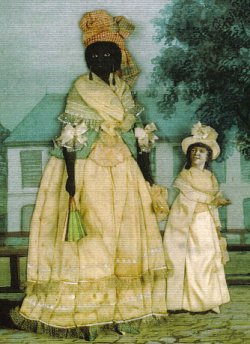 Three years ago, as chronicled elsewhere in this section of my website, I had the DNA surprise of my life, when I learned that in 1927 my married paternal grandmother had an affair, or at the very least, a one-night stand, with her next-door neighbor, Charlie Miles, resulting nine months later in the birth of my father, Raymond Butler.
Three years ago, as chronicled elsewhere in this section of my website, I had the DNA surprise of my life, when I learned that in 1927 my married paternal grandmother had an affair, or at the very least, a one-night stand, with her next-door neighbor, Charlie Miles, resulting nine months later in the birth of my father, Raymond Butler.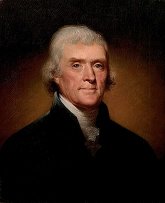 On this Independence Day, I am proud to report that although I am not a direct descendant of President Thomas Jefferson, thanks to the fact that he and I have a common ancestor on my father's side of the family (Christopher Branch) we are distantly related: Fourth Cousins, 6x Removed.
On this Independence Day, I am proud to report that although I am not a direct descendant of President Thomas Jefferson, thanks to the fact that he and I have a common ancestor on my father's side of the family (Christopher Branch) we are distantly related: Fourth Cousins, 6x Removed.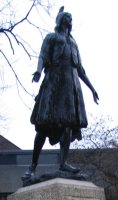 Late last year I came across some information that led me to believe that there was a possibility that I am a descendant of the famous Pocahontas of Jamestown, Virginia history, but I hesitated to claim her pending further research. Well, I am happy to report that further research has been done, largely in regard to DNA matches, and I can now report that I now think there is a near certainty that Pocahontas is in fact, my ancestress! This, of course, would explain the trace amount of Native American DNA that I possess, according to 23 and Me.
Late last year I came across some information that led me to believe that there was a possibility that I am a descendant of the famous Pocahontas of Jamestown, Virginia history, but I hesitated to claim her pending further research. Well, I am happy to report that further research has been done, largely in regard to DNA matches, and I can now report that I now think there is a near certainty that Pocahontas is in fact, my ancestress! This, of course, would explain the trace amount of Native American DNA that I possess, according to 23 and Me.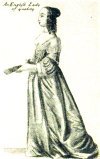 I have known for some time now (about two years or so) that my earliest ancestor in America was a 10-year-old girl named Cicily, who arrived at Jamestown, Virginia in 1610, presumably with her parents (names lost to history), aboard a vessel called The Swan. What I failed to take notice of until more recently is that fact that Cicily, who as a grown woman was married three times, was a common ancestor to both my grandmother, Alice Tate Butler, and my biological grandfather, Charlie Miles, which means that my grandparents were, as incredible as it might seem, distant cousins! To illustrate, I have made
I have known for some time now (about two years or so) that my earliest ancestor in America was a 10-year-old girl named Cicily, who arrived at Jamestown, Virginia in 1610, presumably with her parents (names lost to history), aboard a vessel called The Swan. What I failed to take notice of until more recently is that fact that Cicily, who as a grown woman was married three times, was a common ancestor to both my grandmother, Alice Tate Butler, and my biological grandfather, Charlie Miles, which means that my grandparents were, as incredible as it might seem, distant cousins! To illustrate, I have made 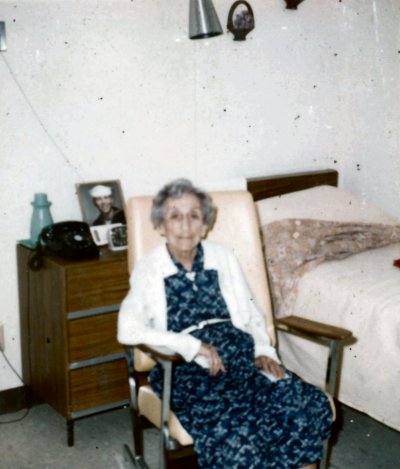 Fifty years ago today, on May 28, 1972, my grandmother, the only one I ever knew, passed away at the Skyline Nursing Home in Desoto, Texas, a suburb of Dallas. She was 86, nearly 87, years-old.
Fifty years ago today, on May 28, 1972, my grandmother, the only one I ever knew, passed away at the Skyline Nursing Home in Desoto, Texas, a suburb of Dallas. She was 86, nearly 87, years-old.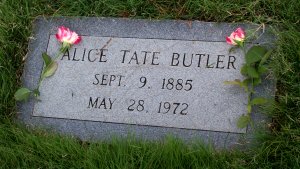
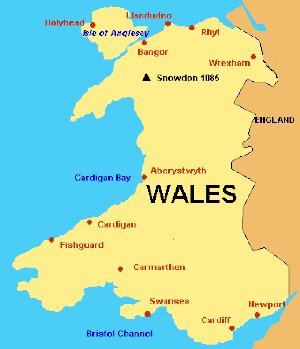 For me, these past two days, Thu., March 31, and Fri., April 1, have been packed with family history events and developments. First of all, March 31st was the third anniversary of my discovery, in 2019, that my father's father was Charlie Miles, not Herman Butler, as we had all thought. As I remarked at the time, this was a major event because it effectively replaced a quarter of the family tree I had been working on for the past nearly fifty years and replaced it with a whole "new" set of ancestors!
For me, these past two days, Thu., March 31, and Fri., April 1, have been packed with family history events and developments. First of all, March 31st was the third anniversary of my discovery, in 2019, that my father's father was Charlie Miles, not Herman Butler, as we had all thought. As I remarked at the time, this was a major event because it effectively replaced a quarter of the family tree I had been working on for the past nearly fifty years and replaced it with a whole "new" set of ancestors!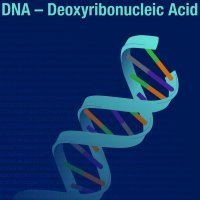 BUT WAIT! THERE'S MORE: As I continued to investigate, I fount that although all three had different last names, they were all related to each other, as well as to me, and all through the Tate family!
BUT WAIT! THERE'S MORE: As I continued to investigate, I fount that although all three had different last names, they were all related to each other, as well as to me, and all through the Tate family!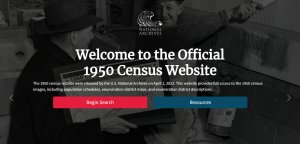
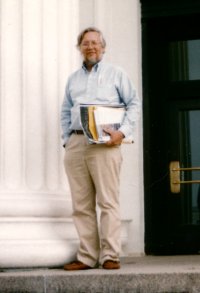 Although the chance discovery of a box of old family photos in the attic of my father and stepmother's house, in November 1971, was the spark that ignited my interest in family history, I didn't begin to do any formal research until Tuesday, January 11, 1972, the fiftieth anniversary of which recently came and went without my remembering it at the time. For some reason, I was thinking I didn't get started until February or March, but today, when I checked an old notebook that I kept in 1972, I was reminded it was a much earlier date.
Although the chance discovery of a box of old family photos in the attic of my father and stepmother's house, in November 1971, was the spark that ignited my interest in family history, I didn't begin to do any formal research until Tuesday, January 11, 1972, the fiftieth anniversary of which recently came and went without my remembering it at the time. For some reason, I was thinking I didn't get started until February or March, but today, when I checked an old notebook that I kept in 1972, I was reminded it was a much earlier date.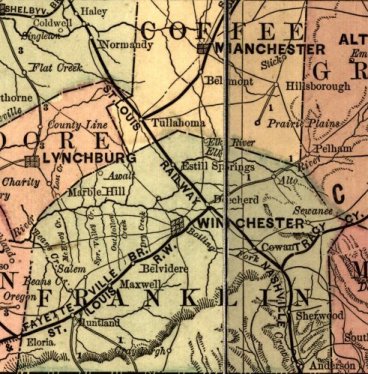 Through my father, Raymond Joe Butler, I am a descendant of no fewer than five families that made their homes in Franklin County, Tennessee during the nineteenth century. This is exceptional. The only other place where I've found an equivalent cluster of antecedent families (also five in number) is Hardin County, Kentucky, and those are all on my mother's side.
Through my father, Raymond Joe Butler, I am a descendant of no fewer than five families that made their homes in Franklin County, Tennessee during the nineteenth century. This is exceptional. The only other place where I've found an equivalent cluster of antecedent families (also five in number) is Hardin County, Kentucky, and those are all on my mother's side.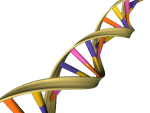 I am one of those avid family historians that is always doing some kind of family history research, especially now that I'm semi-retired. I ought to be fully retired, after all, I'm over 70, but I still teach three sections of U.S. or Texas History at a community college near my home.
I am one of those avid family historians that is always doing some kind of family history research, especially now that I'm semi-retired. I ought to be fully retired, after all, I'm over 70, but I still teach three sections of U.S. or Texas History at a community college near my home.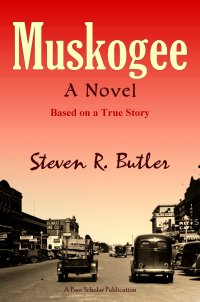 Inspired by the 100th anniversary of my maternal grandparents' wedding and the 87th anniversary of my maternal grandmother's death in 1934, I have finally fulfilled a long-held ambition, which is to write a novel based on the events of my grandparents' 13-year marriage and more particularly, the ten years or so they spent living in Muskogee, Oklahoma. Scheduled for publication on or before September 1, 2021, it is titled Muskogee: A Novel Based on a True Story. On the left is a picture of the front cover, which I designed myself.
Inspired by the 100th anniversary of my maternal grandparents' wedding and the 87th anniversary of my maternal grandmother's death in 1934, I have finally fulfilled a long-held ambition, which is to write a novel based on the events of my grandparents' 13-year marriage and more particularly, the ten years or so they spent living in Muskogee, Oklahoma. Scheduled for publication on or before September 1, 2021, it is titled Muskogee: A Novel Based on a True Story. On the left is a picture of the front cover, which I designed myself.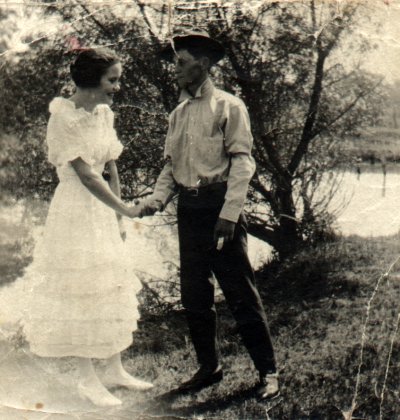 One hundred years ago today, on Saturday, July 23, 1921, at the age of nineteen, my maternal grandfather, William Ollie Jenkins, married my maternal grandmother, Ida Lee Seay, the seventeen-year-old daughter of a Lamar County building contractor named Matthew E. Seay. Unfortunately, the venue has been lost to history, but in view of the fact that the officiant was the Reverend N. C. Walters of Powderly, the New Providence Church, located about five miles northeast of Paris, the church to which Reverend Walters was attached, seems a likely spot. Of course, it's also possible that the wedding took place at the Jenkins home in Powderly or the Seay home, the location of which is uncertain.
One hundred years ago today, on Saturday, July 23, 1921, at the age of nineteen, my maternal grandfather, William Ollie Jenkins, married my maternal grandmother, Ida Lee Seay, the seventeen-year-old daughter of a Lamar County building contractor named Matthew E. Seay. Unfortunately, the venue has been lost to history, but in view of the fact that the officiant was the Reverend N. C. Walters of Powderly, the New Providence Church, located about five miles northeast of Paris, the church to which Reverend Walters was attached, seems a likely spot. Of course, it's also possible that the wedding took place at the Jenkins home in Powderly or the Seay home, the location of which is uncertain.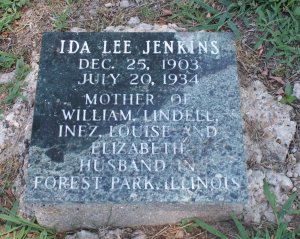 As it happens, today is also the anniversary of an unhappy occasion, namely Ida's funeral, which was held eighty-seven years ago, on Monday, July 23, 1934, after which she was buried at Frozen Rock Cemetery, a small, semi-rural burial ground located on the outskirts of Muskogee, not far from the west bank of the Arkansas River. She died on Friday, July 20, 1934 (only two months after baby Elizabeth Ann was buried in a children's grave in a different cemetery), of tuberculosis, also known as "consumption," thus bringing the marriage of Ida and Ollie to a conclusion. Ida, the grandmother I knew, was only thirty years old at the time of her death.
As it happens, today is also the anniversary of an unhappy occasion, namely Ida's funeral, which was held eighty-seven years ago, on Monday, July 23, 1934, after which she was buried at Frozen Rock Cemetery, a small, semi-rural burial ground located on the outskirts of Muskogee, not far from the west bank of the Arkansas River. She died on Friday, July 20, 1934 (only two months after baby Elizabeth Ann was buried in a children's grave in a different cemetery), of tuberculosis, also known as "consumption," thus bringing the marriage of Ida and Ollie to a conclusion. Ida, the grandmother I knew, was only thirty years old at the time of her death.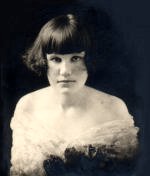 Reflecting on these two events, which occurred thirteen years apart to the day, I can't help but feel sad, and sorry for my grandmother, whose life was cut so tragically short. I also feel sorry for her children, only 12, 11, 7 and 3 years old at the time their mother passed, who would spend the rest of their childhoods without her to guide and nurture and comfort them. And I feel sorry too for myself and my siblings and my cousins, who never had a chance to know the woman that her sister Maude characterized as "a beautiful person." Rest in peace grandmother.
Reflecting on these two events, which occurred thirteen years apart to the day, I can't help but feel sad, and sorry for my grandmother, whose life was cut so tragically short. I also feel sorry for her children, only 12, 11, 7 and 3 years old at the time their mother passed, who would spend the rest of their childhoods without her to guide and nurture and comfort them. And I feel sorry too for myself and my siblings and my cousins, who never had a chance to know the woman that her sister Maude characterized as "a beautiful person." Rest in peace grandmother. As I think I may have mentioned in a previous posting, my great-great-grandfather, William B. Miles, is the furthest back member of that line for which I have a verifiable "paper trail," beginning in 1836, when he was about twenty-six years of age and living in Franklin County, Tennessee, and going up to about 1856, when he apparently died, also in Franklin County, Tennessee, at the age of about fifty-six.
As I think I may have mentioned in a previous posting, my great-great-grandfather, William B. Miles, is the furthest back member of that line for which I have a verifiable "paper trail," beginning in 1836, when he was about twenty-six years of age and living in Franklin County, Tennessee, and going up to about 1856, when he apparently died, also in Franklin County, Tennessee, at the age of about fifty-six.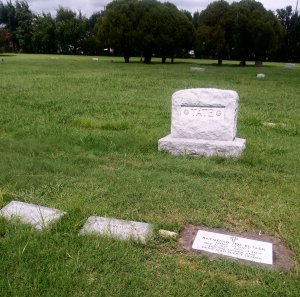 Yesterday, I drove out to Forest Lawn Cemetery in Dallas to see my father's VA grave marker, which had only recently arrived and been set in place. Some people say that "the government" can't do anything right, but I have no complaints with this government-made marker. It was exactly as I expected it to look, with no mistakes. I was, however, a little upset by the fact that while my father's marker was nice and straight, those of his mother and her husband, who are buried on the same side of the plot, are not flat to the ground anymore and also askew, especially my grandmother's husband's marker. I decided that I'd arrange to have them reset, so that they will be in alignment with my dad's marker. Afterward, I started thinking about the history of that family plot, which is marked by a large stone that simply says "TATE," which was my grandmother's maiden name.
Yesterday, I drove out to Forest Lawn Cemetery in Dallas to see my father's VA grave marker, which had only recently arrived and been set in place. Some people say that "the government" can't do anything right, but I have no complaints with this government-made marker. It was exactly as I expected it to look, with no mistakes. I was, however, a little upset by the fact that while my father's marker was nice and straight, those of his mother and her husband, who are buried on the same side of the plot, are not flat to the ground anymore and also askew, especially my grandmother's husband's marker. I decided that I'd arrange to have them reset, so that they will be in alignment with my dad's marker. Afterward, I started thinking about the history of that family plot, which is marked by a large stone that simply says "TATE," which was my grandmother's maiden name.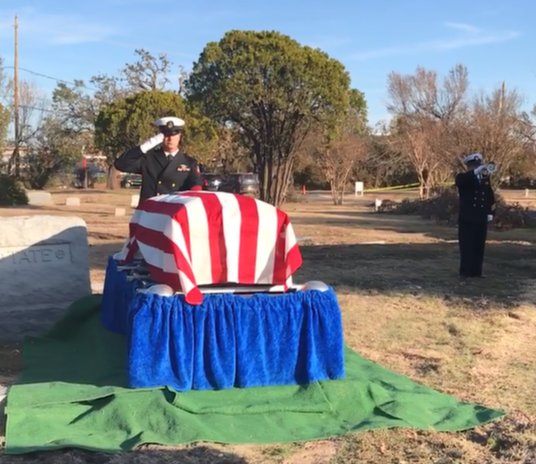
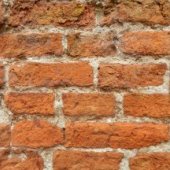 One of the things I learned a long time ago is that in family history, sooner or later, a researcher will hit what's called a "brick wall," a point at which no matter how hard you try, you just can't go back any further in time because the paper trail has seemingly run out. I guess you could also call it a "dead end," except that you know there's an answer to your questions, but you just can't find any documents that answers them. This is because the documents you seek don't exist, or you just haven't looked in all the places where they might be "hidden." Most often, what you are looking for is something that provides a link between generations, a deed or a will or something else that says "my son so-and-so," or "my daughter, so-and-so," or "my brother, so-and-so." Well, you get the idea.
One of the things I learned a long time ago is that in family history, sooner or later, a researcher will hit what's called a "brick wall," a point at which no matter how hard you try, you just can't go back any further in time because the paper trail has seemingly run out. I guess you could also call it a "dead end," except that you know there's an answer to your questions, but you just can't find any documents that answers them. This is because the documents you seek don't exist, or you just haven't looked in all the places where they might be "hidden." Most often, what you are looking for is something that provides a link between generations, a deed or a will or something else that says "my son so-and-so," or "my daughter, so-and-so," or "my brother, so-and-so." Well, you get the idea.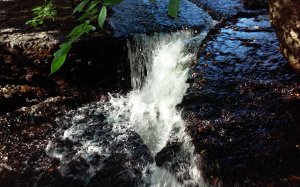 I also learned a long time ago that when you hit the proverbial "brick wall," and just can't seem to go any further with any particular line, it is time to be like water and find the path of least resistance. In other words, it's time to "go with the flow," and that's what I've done with the fourth Franklin County, Tennessee family from whom I'm descended, the HOLDER family.
I also learned a long time ago that when you hit the proverbial "brick wall," and just can't seem to go any further with any particular line, it is time to be like water and find the path of least resistance. In other words, it's time to "go with the flow," and that's what I've done with the fourth Franklin County, Tennessee family from whom I'm descended, the HOLDER family.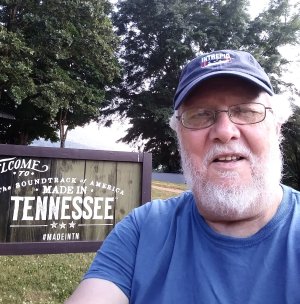 Shortly after I discovered, on May 31, 2019, that I have a different grandfather than the one I thought I had for all my life, I began to research the "new" lines from which I'm descended, to replace the "old" lines that were no longer (and never had been) relevant). By and large, I've been successful, and happy with the results. Not the least of my discoveries is the fact that I am a descendant of some of the very earliest English families to settle in North America. However, while that's gratifying, I've also run into some proverbial "brick walls." Not the least of these is the fact that so far as the proverbial "paper trail" is concerned, I am unable to trace my direct paternal line, the Miles family, any further back that about 1810, when my great-great-grandfather, William B. Miles, was born in North Carolina (according to the 1850 federal census). Unfortunately, although the census provides us with an approximate date and place of birth for William B. Miles, the actual paper trail ends at June 1838, when his name first appears in the country court minutes of Coffee County, Tennessee. So far, I've been unable to find anything older, nor any document of any kind that provides us with the identity of his parents, or even a good clue. So, at present, I'm stuck. Or am I?
Shortly after I discovered, on May 31, 2019, that I have a different grandfather than the one I thought I had for all my life, I began to research the "new" lines from which I'm descended, to replace the "old" lines that were no longer (and never had been) relevant). By and large, I've been successful, and happy with the results. Not the least of my discoveries is the fact that I am a descendant of some of the very earliest English families to settle in North America. However, while that's gratifying, I've also run into some proverbial "brick walls." Not the least of these is the fact that so far as the proverbial "paper trail" is concerned, I am unable to trace my direct paternal line, the Miles family, any further back that about 1810, when my great-great-grandfather, William B. Miles, was born in North Carolina (according to the 1850 federal census). Unfortunately, although the census provides us with an approximate date and place of birth for William B. Miles, the actual paper trail ends at June 1838, when his name first appears in the country court minutes of Coffee County, Tennessee. So far, I've been unable to find anything older, nor any document of any kind that provides us with the identity of his parents, or even a good clue. So, at present, I'm stuck. Or am I?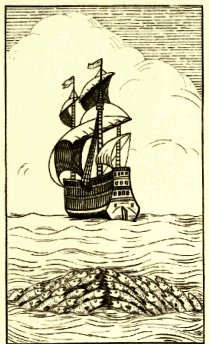 Yesterday, when I was in the process of creating the spreadsheets I mention in the section above, I was reminded that although Christopher Branch was certainly one of my earliest ancestors in America, he wasn't the first. I had forgotten the fact that an ancestor named Cicily Reynolds arrived at Jamestown aboard The Swan in 1610 or thereabouts, some ten years earlier than Christopher Branch. Sometime after, when she was about sixteen or seventeen, she married a man named Thomas Bayley or Bailey. Precisely when he arrived in the colony is unknown.
Yesterday, when I was in the process of creating the spreadsheets I mention in the section above, I was reminded that although Christopher Branch was certainly one of my earliest ancestors in America, he wasn't the first. I had forgotten the fact that an ancestor named Cicily Reynolds arrived at Jamestown aboard The Swan in 1610 or thereabouts, some ten years earlier than Christopher Branch. Sometime after, when she was about sixteen or seventeen, she married a man named Thomas Bayley or Bailey. Precisely when he arrived in the colony is unknown.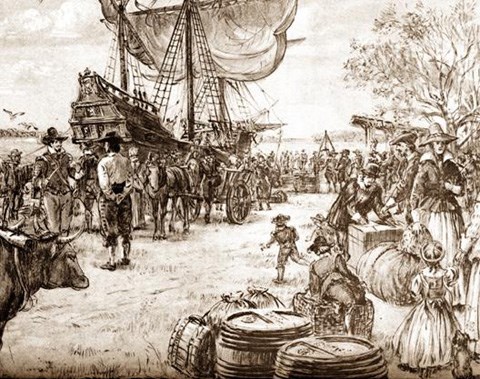 Believe it or not, my "roots" in America go back exactly 400 years this year because my earliest ancestors in America, an Englishman named Christopher Branch, and his wife, Addie, sailed from London aboard a ship called the London Merchant, in March 1619 (old style) or 1620 (new style), bound for Virginia, where the English had first established a colony only thirteen years earlier, in 1607. For those of you unfamiliar with what that means, England was then still using a calendar in which each new year did not began until March 25.
Believe it or not, my "roots" in America go back exactly 400 years this year because my earliest ancestors in America, an Englishman named Christopher Branch, and his wife, Addie, sailed from London aboard a ship called the London Merchant, in March 1619 (old style) or 1620 (new style), bound for Virginia, where the English had first established a colony only thirteen years earlier, in 1607. For those of you unfamiliar with what that means, England was then still using a calendar in which each new year did not began until March 25.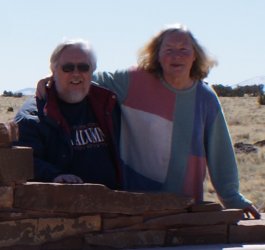 On Friday, September 25, 2020, my cousin, Kathleen Jenkins Eavenson, died at her home in Phoenix, Arizona. She was four months short of her 70th birthday. She was the daughter and only child of my Uncle Lindell Ray Jenkins and his wife, Betsey Torrey Strow, of Dallas, Texas, where Kathleen was born and raised.
On Friday, September 25, 2020, my cousin, Kathleen Jenkins Eavenson, died at her home in Phoenix, Arizona. She was four months short of her 70th birthday. She was the daughter and only child of my Uncle Lindell Ray Jenkins and his wife, Betsey Torrey Strow, of Dallas, Texas, where Kathleen was born and raised.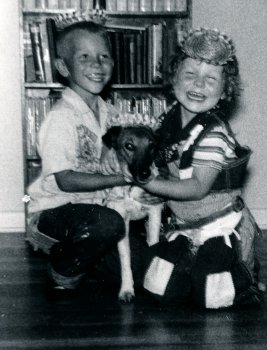 She also liked to remind me that I drove her crazy playing my "Ballad of Davy Crockett" record over and over and over again. Kathleen said that whereas I liked to dress up and pretend to be Davy Crockett, she wanted to be Billy the Kid. In our later years, whenever we wrote to one another or spoke on the phone, she would sometimes call me "Davy" and I'd call her "Billy." In the photo to the left, which was taken at my sixth birthday party, she is dressed as Billy the Kid. That's her dog, Duffy, in the picture. Kathleen really thought it was funny to have Duffy wearing a party hat.
She also liked to remind me that I drove her crazy playing my "Ballad of Davy Crockett" record over and over and over again. Kathleen said that whereas I liked to dress up and pretend to be Davy Crockett, she wanted to be Billy the Kid. In our later years, whenever we wrote to one another or spoke on the phone, she would sometimes call me "Davy" and I'd call her "Billy." In the photo to the left, which was taken at my sixth birthday party, she is dressed as Billy the Kid. That's her dog, Duffy, in the picture. Kathleen really thought it was funny to have Duffy wearing a party hat.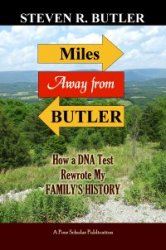 Earlier this month, my latest book, Miles Away from Butler: How a DNA Test Rewrote my Family's History, was published by Poor Scholar Publications. Consisting of seven chapters and an Introduction, it tells the story of how in 2019, thanks to the results of a 23 and Me DNA test, I uncovered a 91-year-old family secret that had the effect of pruning several branches from my family tree and the addition of many more new ones!.
Earlier this month, my latest book, Miles Away from Butler: How a DNA Test Rewrote my Family's History, was published by Poor Scholar Publications. Consisting of seven chapters and an Introduction, it tells the story of how in 2019, thanks to the results of a 23 and Me DNA test, I uncovered a 91-year-old family secret that had the effect of pruning several branches from my family tree and the addition of many more new ones!.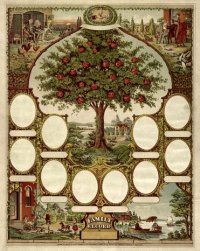 It may be winter, but my family tree is branching out like it was spring. This year (2019), owing to the subtraction of four paternal branches by DNA testing and the addition of seventeen "new" ones in their place, combined with six others that were the result of regular research, my paternal branches now total thirty-four.
It may be winter, but my family tree is branching out like it was spring. This year (2019), owing to the subtraction of four paternal branches by DNA testing and the addition of seventeen "new" ones in their place, combined with six others that were the result of regular research, my paternal branches now total thirty-four.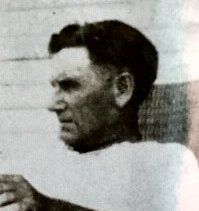 Yesterday, Saturday, December 21, 2019, was what would have been my father's 92nd birthday. To commemorate it, I had lunch in the same restaurant where I had taken him out to lunch on his birthday every year, or almost very year, since he turned 65. Later, I visited the cemetery where he was recently buried, to sprinkle some earth from the front yard of the house where he was born on his grave. I had scooped up a little for that purpose back in February, when he and I visited the old homestead in East Dallas. (See March 1st posting below.) I didn't think I would need it so soon. Even though he was then 91, I had hoped he had at least another two or three years left, but it turned out to be only a few months instead.
Yesterday, Saturday, December 21, 2019, was what would have been my father's 92nd birthday. To commemorate it, I had lunch in the same restaurant where I had taken him out to lunch on his birthday every year, or almost very year, since he turned 65. Later, I visited the cemetery where he was recently buried, to sprinkle some earth from the front yard of the house where he was born on his grave. I had scooped up a little for that purpose back in February, when he and I visited the old homestead in East Dallas. (See March 1st posting below.) I didn't think I would need it so soon. Even though he was then 91, I had hoped he had at least another two or three years left, but it turned out to be only a few months instead.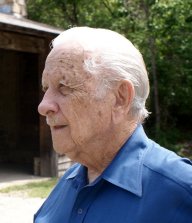 On Wednesday, November 13, 2019, my nearly 92-year-old father, Raymond Joe Butler, died at Dallas Medical Center.
On Wednesday, November 13, 2019, my nearly 92-year-old father, Raymond Joe Butler, died at Dallas Medical Center.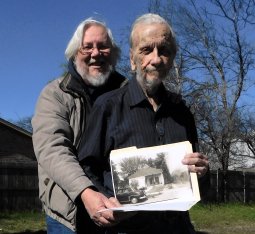 In the spring of 2014, when I took my oldest son and grandson on a drive-through visit to my grandparents' old neighborhood in East Dallas, I was astonished to see that their house was still standing. Most of the original wooden homes in the neighborhood were already gone by then, replaced by new houses made of brick. Three years later, when my elderly father and I went by to take a look, the old house was gone, but there was no new house, only a vacant lot. When I looked again this year, in late January, I fully expected to see a brand new house on the site. To my surprise, the lot was still vacant! I realized then that my dad and I still had a chance to do something I wished that we had done in 2017--that is, get out of the car and walk around the place. Recently, on Sunday, February 24, a remarkably sunny, warm day in North Texas, my 91-year-old father and I did just that.
In the spring of 2014, when I took my oldest son and grandson on a drive-through visit to my grandparents' old neighborhood in East Dallas, I was astonished to see that their house was still standing. Most of the original wooden homes in the neighborhood were already gone by then, replaced by new houses made of brick. Three years later, when my elderly father and I went by to take a look, the old house was gone, but there was no new house, only a vacant lot. When I looked again this year, in late January, I fully expected to see a brand new house on the site. To my surprise, the lot was still vacant! I realized then that my dad and I still had a chance to do something I wished that we had done in 2017--that is, get out of the car and walk around the place. Recently, on Sunday, February 24, a remarkably sunny, warm day in North Texas, my 91-year-old father and I did just that. 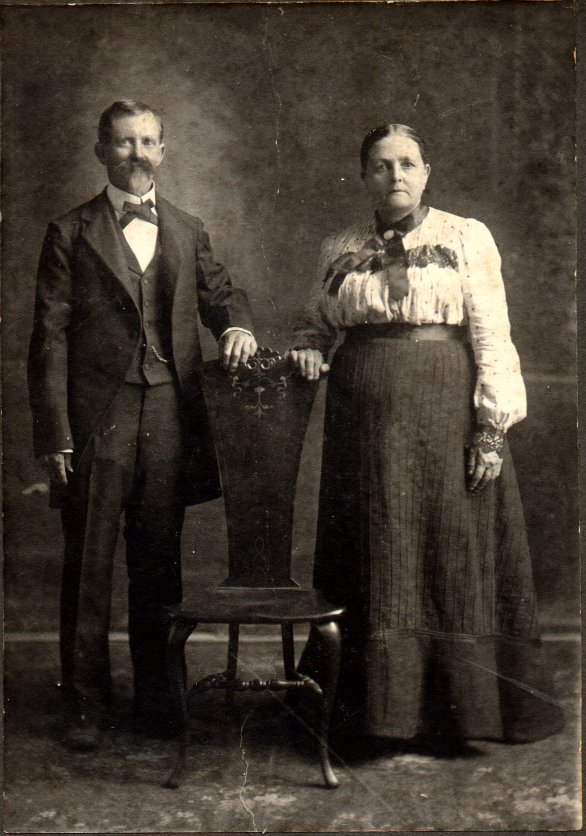
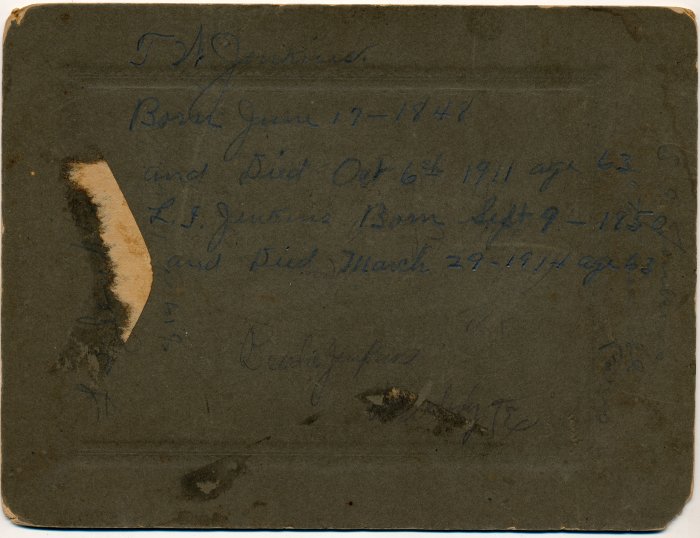
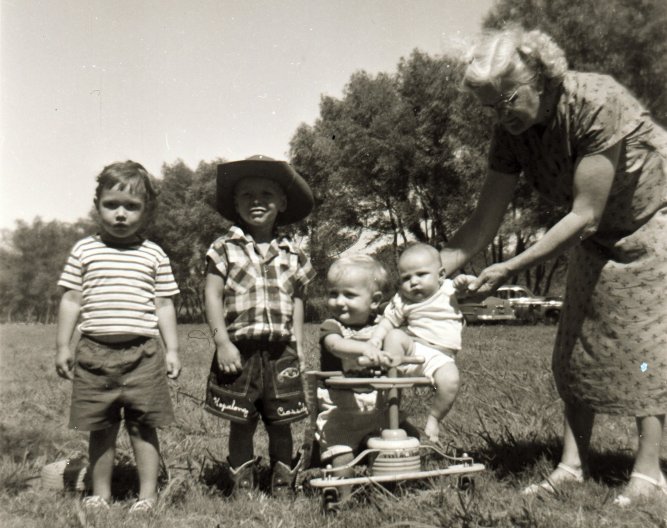

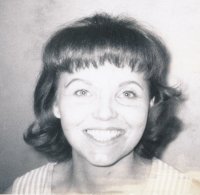 The first on the list (I'm going in the order in which I became acquainted with them) is my actual mother, born Ida Louise Jenkins in 1930 in Muskogee, Oklahoma.
The first on the list (I'm going in the order in which I became acquainted with them) is my actual mother, born Ida Louise Jenkins in 1930 in Muskogee, Oklahoma.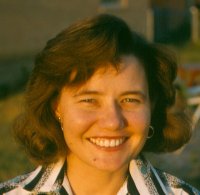 The second mother on my list is my mother's older sister, my Aunt Nez Hickman, born Emma Inez Jenkins in 1927, also in Muskogee, Oklahoma. Aunt Nez was one of a handful of people who saw me and held me shortly after I was born. During my childhood, she and my Uncle Charles Hickman were like a second set of parents to me and I spent a lot of time with them, so much in fact that after my parents were divorced and my mother remarried, they proposed to adopt me. My mother wouldn't agree to it, however. I owe Aunt Nez a lot because she was there for me, loving me and caring about me during a time when I often felt unloved and unwanted, after both my parents remarried. She was in some ways more of a mother to me than my own mother and we remained close until she died in 2009. Aunt Nez was also special to me because unlike my mother, who had no interest in family history, Nez was enthusiastic about helping me learn more about my maternal ancestors. She was a great help to me in that department also.
The second mother on my list is my mother's older sister, my Aunt Nez Hickman, born Emma Inez Jenkins in 1927, also in Muskogee, Oklahoma. Aunt Nez was one of a handful of people who saw me and held me shortly after I was born. During my childhood, she and my Uncle Charles Hickman were like a second set of parents to me and I spent a lot of time with them, so much in fact that after my parents were divorced and my mother remarried, they proposed to adopt me. My mother wouldn't agree to it, however. I owe Aunt Nez a lot because she was there for me, loving me and caring about me during a time when I often felt unloved and unwanted, after both my parents remarried. She was in some ways more of a mother to me than my own mother and we remained close until she died in 2009. Aunt Nez was also special to me because unlike my mother, who had no interest in family history, Nez was enthusiastic about helping me learn more about my maternal ancestors. She was a great help to me in that department also.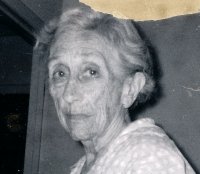 Third on my list is my grandmother, Alice Tate Butler, who I called "Nannie." Born in a little town in Alabama in 1885, she came to Texas at the age of three with her family, settling in Dallas in 1890. She also loved and cared for me during those unhappy years when I felt like a "leftover kid." I spent a lot of good times with her, staying with her on weekends and sometimes longer, at her home in East Dallas. When I was around twelve, she nursed me through a bout of Scarlet Fever, an infectious illness that she had suffered herself as a child. By the time I came along she was in her sixties so I only remember her as an old lady, but a very sweet and loving one, who always made me feel wanted and special. When she died in 1972 at age 86, I felt like I had lost one of my best friends in the whole world, which I had. I still keep a photo of her and I together, taken when I came home on leave from the Navy, on my chest o'drawers. I also owe my grandmother a debt of gratitude because it was she, albeit without meaning to do so, who inspired to begin my lifelong hobby of family history research.
Third on my list is my grandmother, Alice Tate Butler, who I called "Nannie." Born in a little town in Alabama in 1885, she came to Texas at the age of three with her family, settling in Dallas in 1890. She also loved and cared for me during those unhappy years when I felt like a "leftover kid." I spent a lot of good times with her, staying with her on weekends and sometimes longer, at her home in East Dallas. When I was around twelve, she nursed me through a bout of Scarlet Fever, an infectious illness that she had suffered herself as a child. By the time I came along she was in her sixties so I only remember her as an old lady, but a very sweet and loving one, who always made me feel wanted and special. When she died in 1972 at age 86, I felt like I had lost one of my best friends in the whole world, which I had. I still keep a photo of her and I together, taken when I came home on leave from the Navy, on my chest o'drawers. I also owe my grandmother a debt of gratitude because it was she, albeit without meaning to do so, who inspired to begin my lifelong hobby of family history research.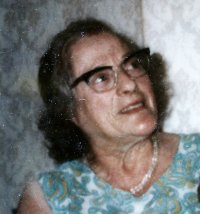 The fourth mother on my list is my mother-in-law, Fay Wolfson. What can I say about Fay? She had a heart of gold and I just wish everyone could have a mother-in-law as wonderful and kind and generous and sharing as her. Born in London, England in 1913, Fay had a hard life, especially during the Second World War, when the Germans were bombing the British capital, but through all her hardships, she kept smiling. She always made me feel welcome, from the first day I met her in 1969. Unfortunately, like my own mother, Fay died suddenly and unexpectedly, although at the more advanced age of 74.
The fourth mother on my list is my mother-in-law, Fay Wolfson. What can I say about Fay? She had a heart of gold and I just wish everyone could have a mother-in-law as wonderful and kind and generous and sharing as her. Born in London, England in 1913, Fay had a hard life, especially during the Second World War, when the Germans were bombing the British capital, but through all her hardships, she kept smiling. She always made me feel welcome, from the first day I met her in 1969. Unfortunately, like my own mother, Fay died suddenly and unexpectedly, although at the more advanced age of 74.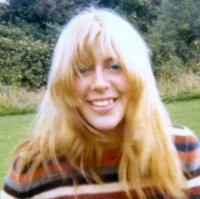 Last, but hardly least on my list, is my wife, Anita, the loving, caring mother of my sons, and the wonderful "Nana" of my grandsons. There are not enough superlatives to express how much I love and appreciate her. She figuratively, and perhaps also literally, saved my life by coming into it at just the right time. Of all the people in my life, she is undoubtedly the most important. Although the other women I've named above have all, in their own way, made me feel special and loved, no one has ever done a better job of it, and for much, much longer, than my wonderful wife.
Last, but hardly least on my list, is my wife, Anita, the loving, caring mother of my sons, and the wonderful "Nana" of my grandsons. There are not enough superlatives to express how much I love and appreciate her. She figuratively, and perhaps also literally, saved my life by coming into it at just the right time. Of all the people in my life, she is undoubtedly the most important. Although the other women I've named above have all, in their own way, made me feel special and loved, no one has ever done a better job of it, and for much, much longer, than my wonderful wife.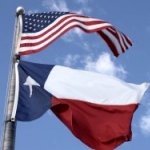 One of my goals when I first began to research my family's history was to learn how the Butler family came to be in Texas. In fact, I remember very well, back in November 1971, asking my paternal grandmother, after she told me how her parents brought her and her siblings to Texas from Alabama in 1888, if she knew how my grandfather's (her husband's) family came to be in Texas. She said she didn't know. All she knew was that he (my grandfather Butler) grew up in Denison, a little town located on the Red River a little more than an hour's drive from Dallas. For a long time that's all I had to go on and it wasn't much.
One of my goals when I first began to research my family's history was to learn how the Butler family came to be in Texas. In fact, I remember very well, back in November 1971, asking my paternal grandmother, after she told me how her parents brought her and her siblings to Texas from Alabama in 1888, if she knew how my grandfather's (her husband's) family came to be in Texas. She said she didn't know. All she knew was that he (my grandfather Butler) grew up in Denison, a little town located on the Red River a little more than an hour's drive from Dallas. For a long time that's all I had to go on and it wasn't much. Starting last Thursday and finishing today, I have created several "Family Tree" webpages for this site that illustrate the line of descent from thirty-seven different pairs of ancestors down to and through me to my grandchildren. When I started my research forty-five years ago, I only had knowledge of two (my two sets of grandparents). When I think about all the genealogical "brick walls" I've yet to overcome and become frustrated, it helps me to remember that if I had not made this effort, it would either have had to wait for another generation to discover all that information or it would have continued to be "lost."
Starting last Thursday and finishing today, I have created several "Family Tree" webpages for this site that illustrate the line of descent from thirty-seven different pairs of ancestors down to and through me to my grandchildren. When I started my research forty-five years ago, I only had knowledge of two (my two sets of grandparents). When I think about all the genealogical "brick walls" I've yet to overcome and become frustrated, it helps me to remember that if I had not made this effort, it would either have had to wait for another generation to discover all that information or it would have continued to be "lost."
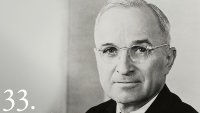
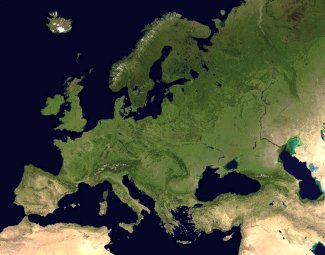
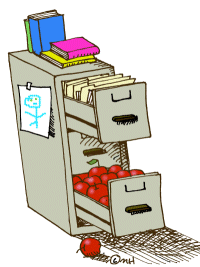 The receipt of my DNA results prompted me to do something I have been meaning to do for quite some time, namely get things better organized. Whether it is the work I do to make a living or the work I do as a hobby, the part I like the best is the actual "doing," which in the case of my family history work means "research." The part I like least is the "paperwork," that is getting things organized.
The receipt of my DNA results prompted me to do something I have been meaning to do for quite some time, namely get things better organized. Whether it is the work I do to make a living or the work I do as a hobby, the part I like the best is the actual "doing," which in the case of my family history work means "research." The part I like least is the "paperwork," that is getting things organized.